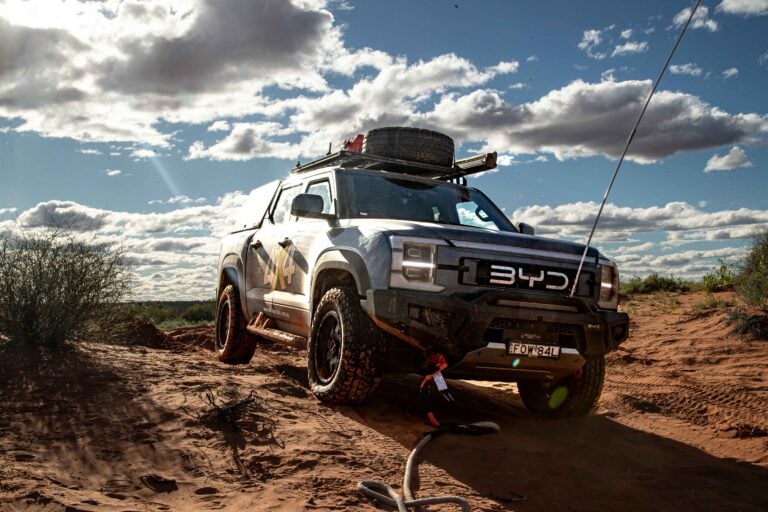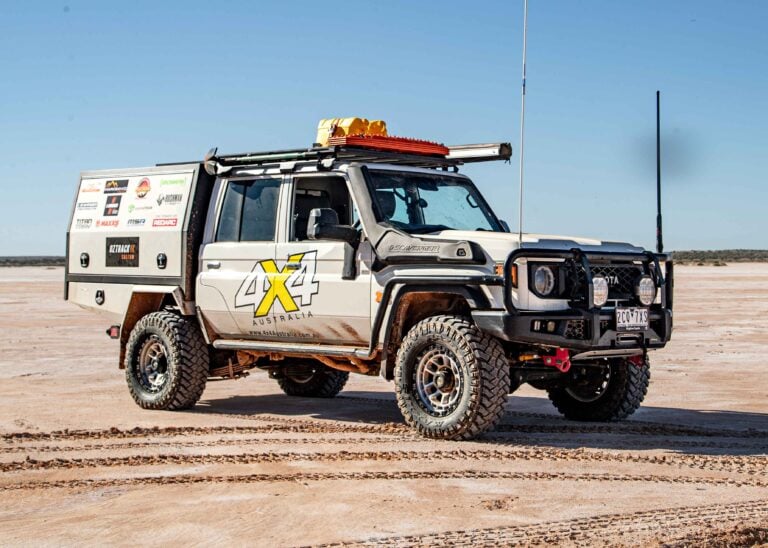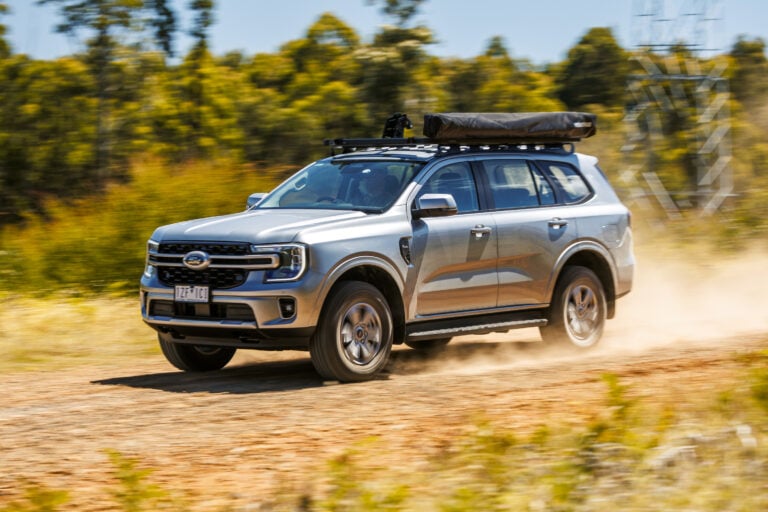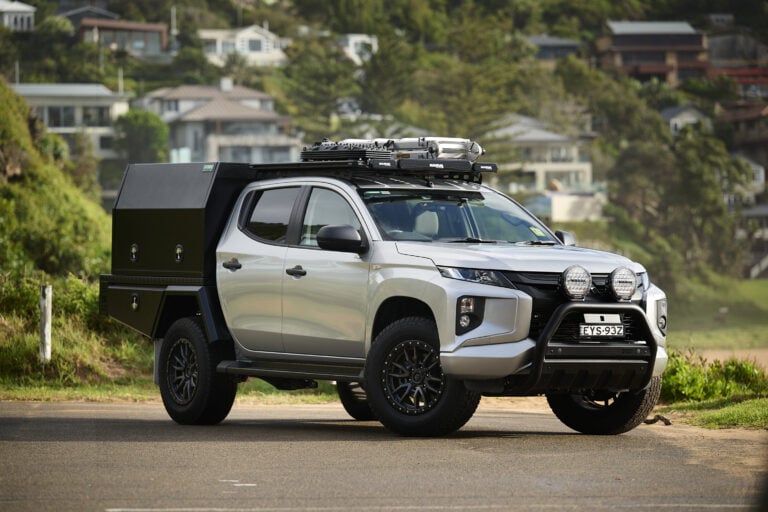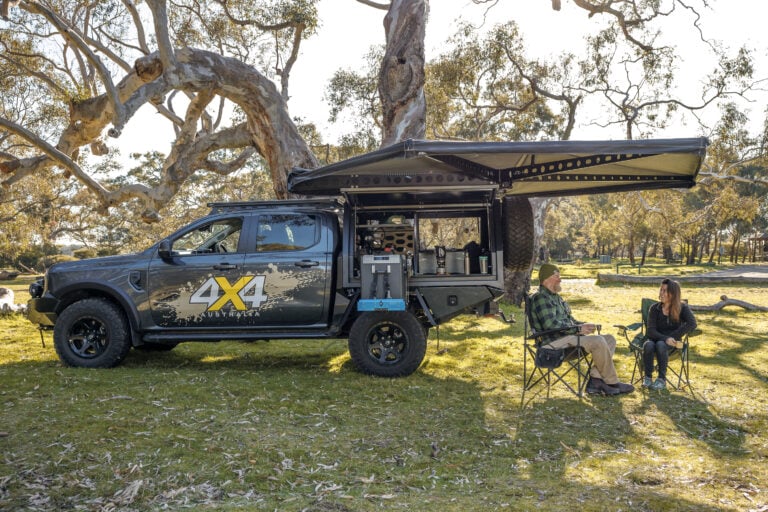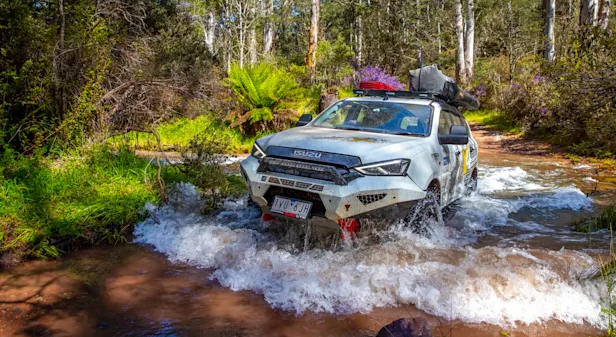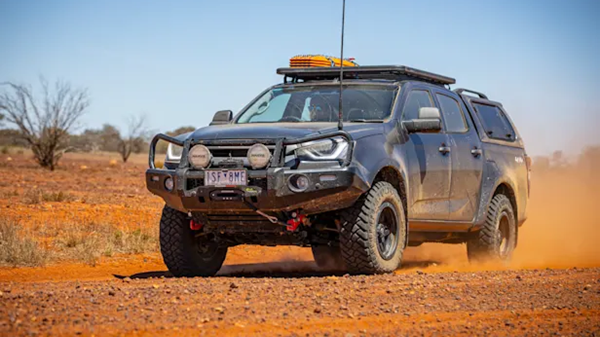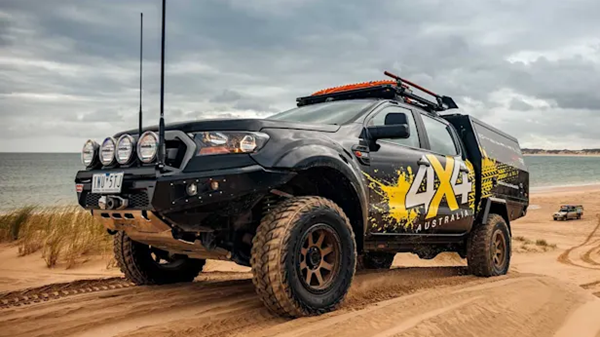- Pink Lakes
- Sunsets
- Plenty of tracks to explore
- Excellent campsites
- Sense of isolation
When it comes to charging your auxiliary batteries, REDARC has been Australia’s leading company in providing solutions for your 4WD.
REDARC has just released the Manager Alpha that allows you to charge from a combination of vehicle (DC), mains (AC) and solar simultaneously, which means your battery has the best chance of being fully charged at all times.
The Manager Alpha is available in 50A, 75A, and 100A variants and is compatible with all battery types. With this much power on tap, you can power everything from induction cooktops and fridges to coffee machines while charging your batteries faster than you can drain them. This makes it an ideal bit of gear for when you are on the move, remote camping or at home.
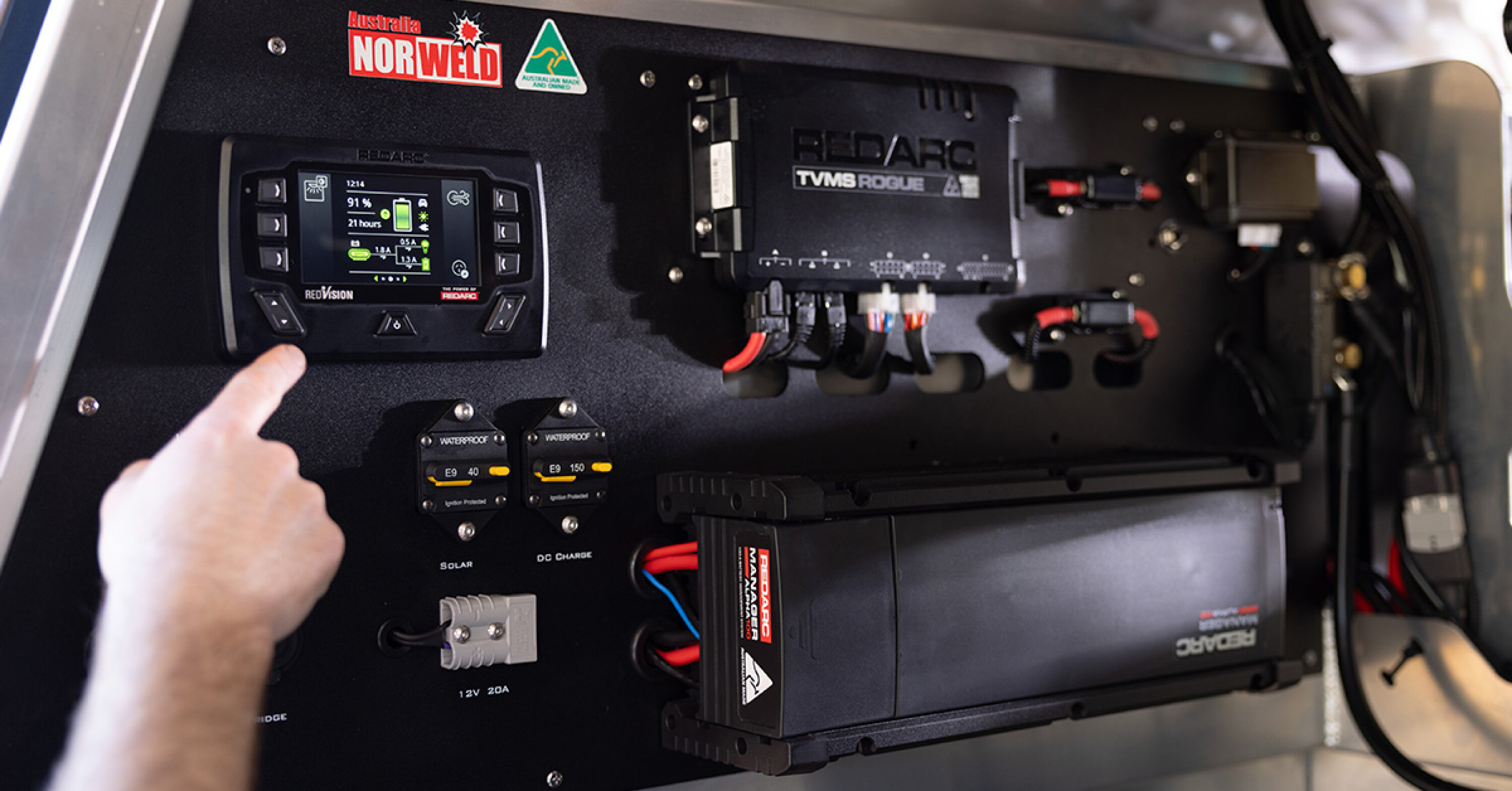
Key features of the Manager Alpha include ultra-fast charging with charge rates of up to 100A available, which ensures batteries are charged quickly and efficiently. The charging options are also versatile with the ability to charge from a mix of DC, AC and solar simultaneously, providing flexibility and convenience no matter the situation.
The Manager Alpha has advanced charging features that automatically utilise excess solar power to keep your starter battery charged. With the touch of a button, the Manager Alpha can also revive your starter battery, so you will never be left stranded after leaving your lights on. A user-friendly interface means you can stay informed and in control with RedVision, offering accurate real-time monitoring of your system’s state of charge, remaining charge and current flow.
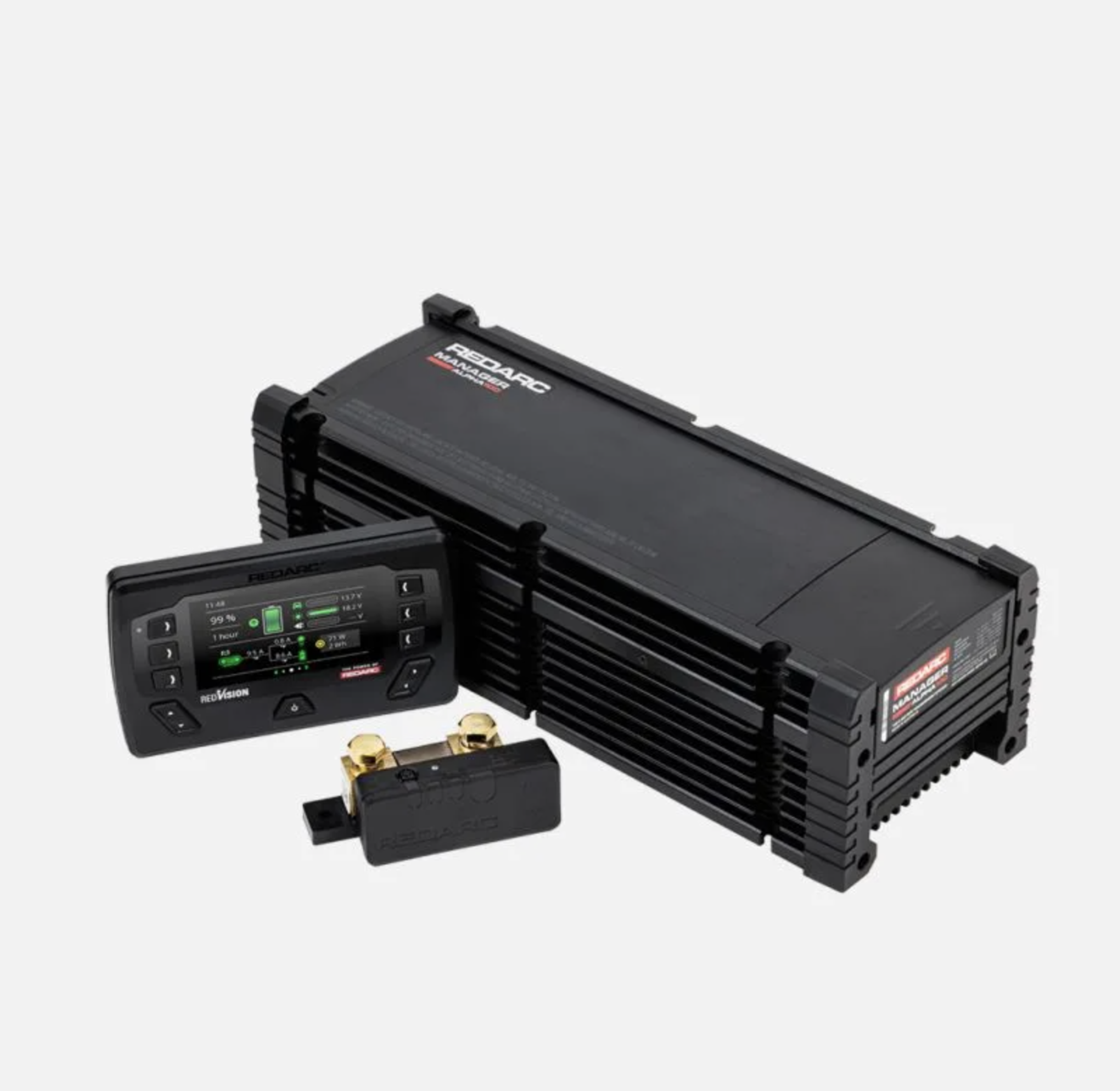
With a compact design combining AC, DC, and solar into a single unit, the Manager Alpha is 55 per cent smaller and 28 per cent lighter than comparable competitor systems. Built in Australia these units have been tested to the toughest vibration standards in the world, so the Manager Alpha is ready for adventure.
Dylan Pinkard, REDARC’s New Product Development Manager, says the Manager Alpha is a testament to REDARC’s commitment to innovative solutions that meet customer needs. “Our customers demand more power than ever, and the Manager delivers this in spades. Its innovative design allows for recovery or maintenance of the vehicle’s start battery, meaning one less thing to worry about while remote firmware updates ensure you’re always up to date with the latest features.”
The 50A unit weighs 5.8kg, the 75A unit weighs 6kg and the 100A unit weighs 6.1kg. Each of the units has the same footprint with dimensions of 400mm L x 154mm W x 120mm H. The Manager Alpha is backed by nationwide support and includes a hassle-free two-year warranty, REDNetwork certified installer network and after-sales service.
Pricing
- Manager Alpha with RedVision (50A): $3999
- Manager Alpha with RedVision (75A): $4899
- Manager Alpha with RedVision (100A): $5899
Imagine the harsh reality for those gold prospectors who left their lives behind to head to Cape York after the discovery of the precious metal there in the mid-1800s.
Walking for weeks into inhospitable country where there was no food and little water, but reports of cannibal inhabitants, all with no guarantee of finding the gold they had come looking for, and after having spent months aboard a boat to get to Australia in the first place.
Curiosity got the better of me after reading a book titled The Rivers of Gold that portrayed the riches and hardships of thousands of prospectors who made their way to the Cape seeking fortune. I decided to head across to Cape York myself on a recent trip to try to get a feeling for the hardship and isolation that these people endured.
It was explorer William Hann who found gold in the isolated hills 200km west of Cooktown in the Palmer River around 1874, and a year later a prospecting party found payable gold. Word quickly spread and the rush was on.
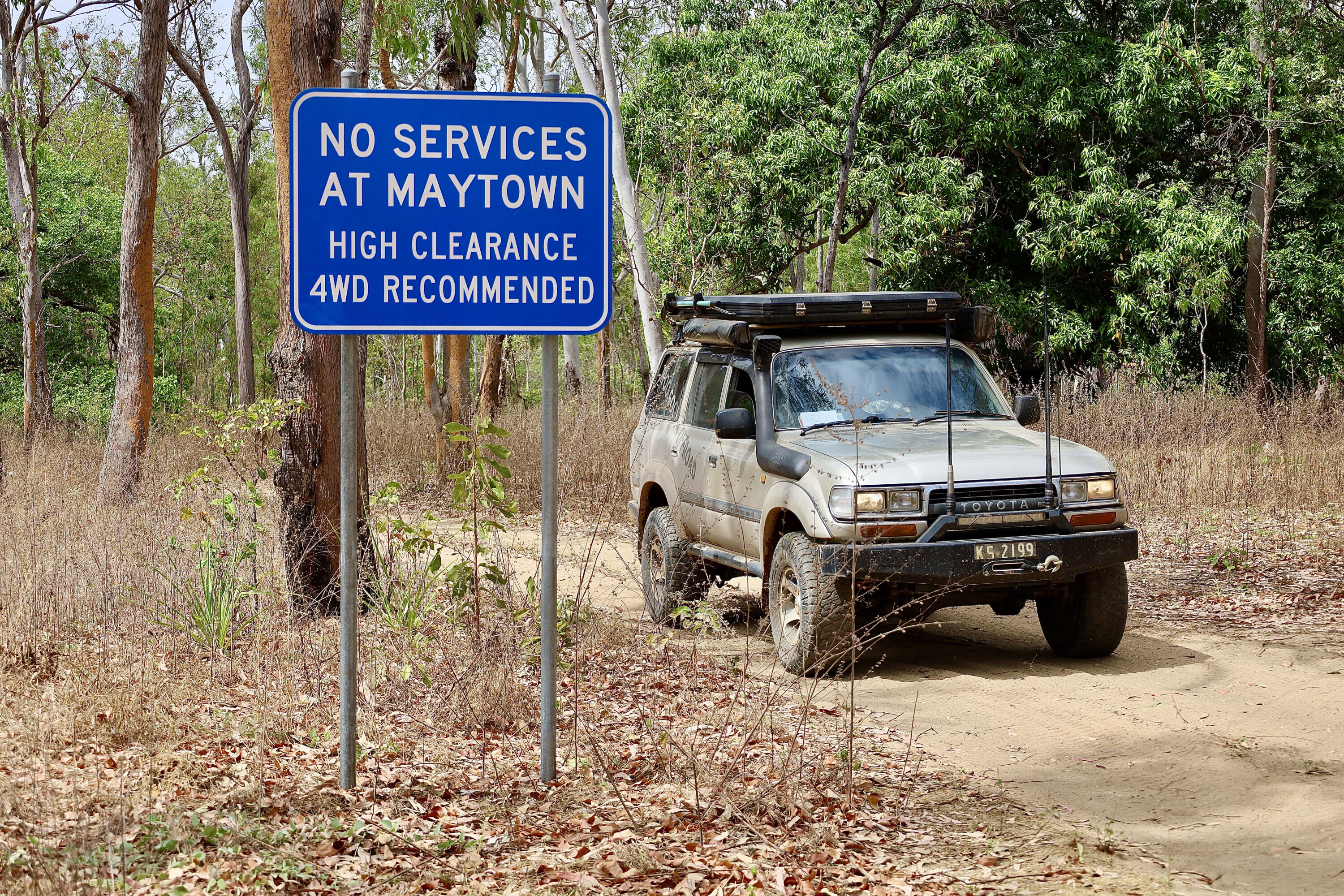
A fellow by the name of James Mulligan was an experienced and well-respected explorer who made his way to north Queensland in the early 1870s to lead exploration parties into new areas looking for gold.
He had an amazing success rate and literally opened the Palmer River Goldfields for other prospectors to hunt for their fortunes. Mulligan was supported by the government through grants and rewards to open new areas such as the Hodgkinson goldfields, and to work in other areas.
Heading 200km out to the goldfields caused all sorts of issues due to a lack of food, and Mulligan is quoted as saying, “Any man who heads out towards the Palmer with less than two weeks supply – will surely perish”. Not only that, but the terrain also was challenging, and several indigenous tribes were known to be on the hunt.
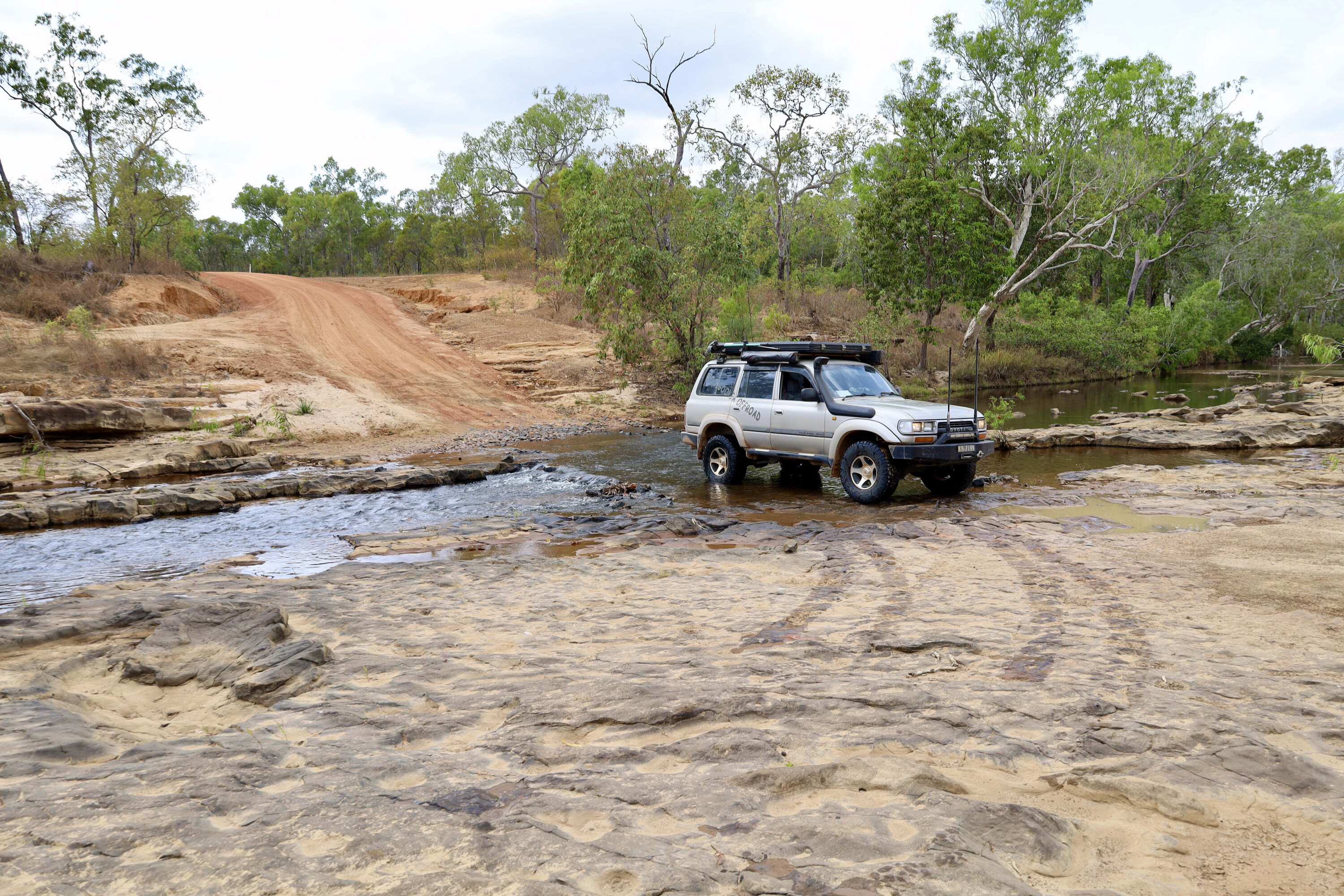
When word got out about the gold, barges and ships from around the world began arriving at Cooktown, the existence of which began with just a few tents pitched on the banks of the Endeavour River.
But Cooktown was soon a bustling port, and it grew quickly with the new arrivals, with some reports claiming there were up to 47 licensed drinking premises, several brothels, two newspapers, Chinese opium houses, a number bakeries and official government houses. In a short amount of time the town swelled with nearly 30,000 people passing through on their way to the goldfields, the majority of whom were Chinese.
The Chinese had a strong presence through the goldfields and were much hated by other diggers, and conflict would regularly break out, but it is reported they were much loved by the local cannibals for their sweet taste.
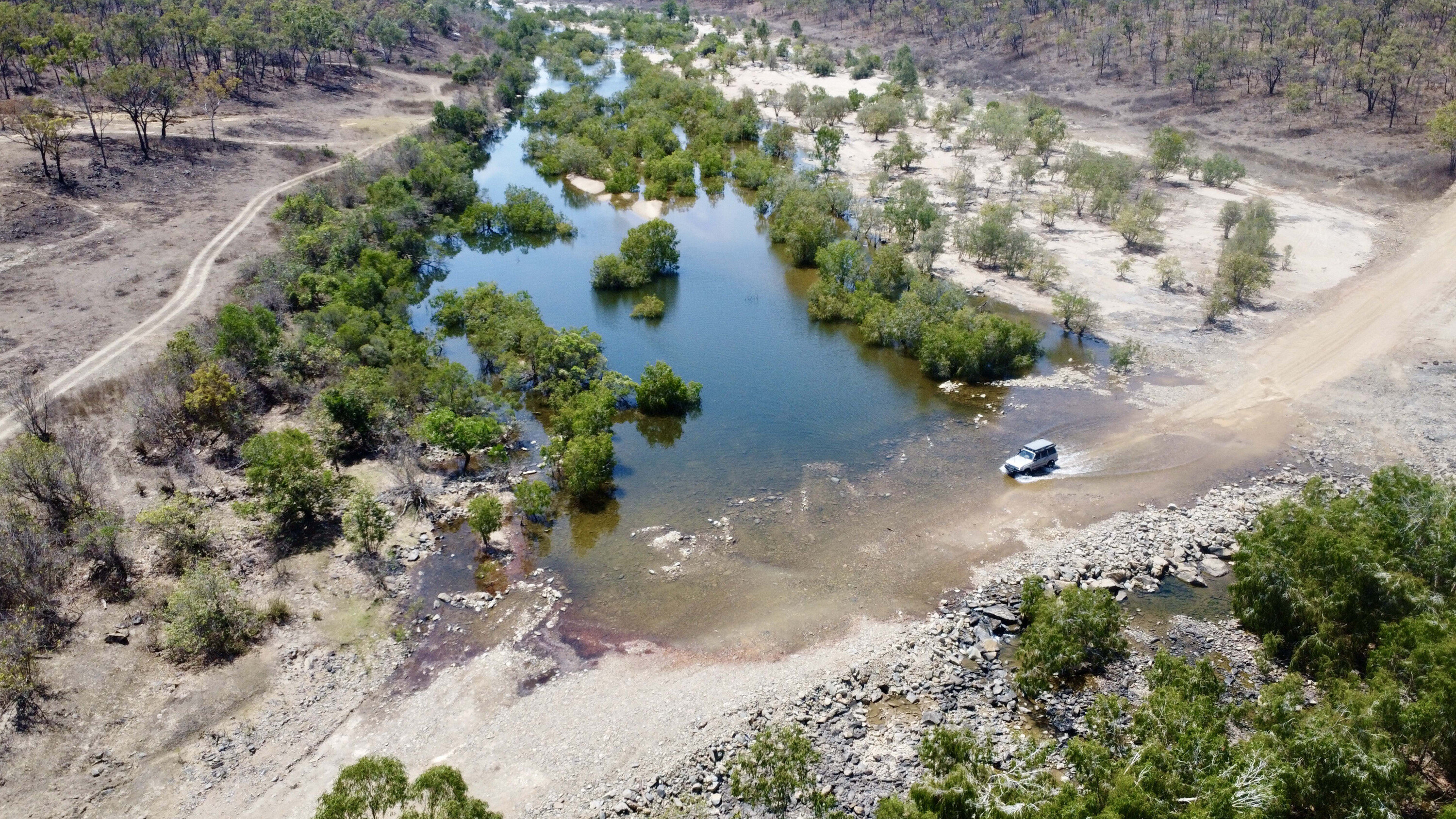
Hard working and quiet, the Chinese did well on the Palmer through prospecting, as well as by establishing market gardens that supplied the town and goldfields with fresh produce and rice. Even today there is a strong Asian influence in Cooktown.
With the goldfields swelling to capacity over time there was constant hunt for new gold. Lone miners moved away from the crowded river and creeks only to find themselves hunted by the local tribes, or their camps raided by other miners looking for free gold.
The Palmer River Goldfields were some of the most isolated in the country and challenges included wet season flooding where bridges and tracks simply washed away, supplies often took weeks to arrive, and there was a lack of medical practitioners.
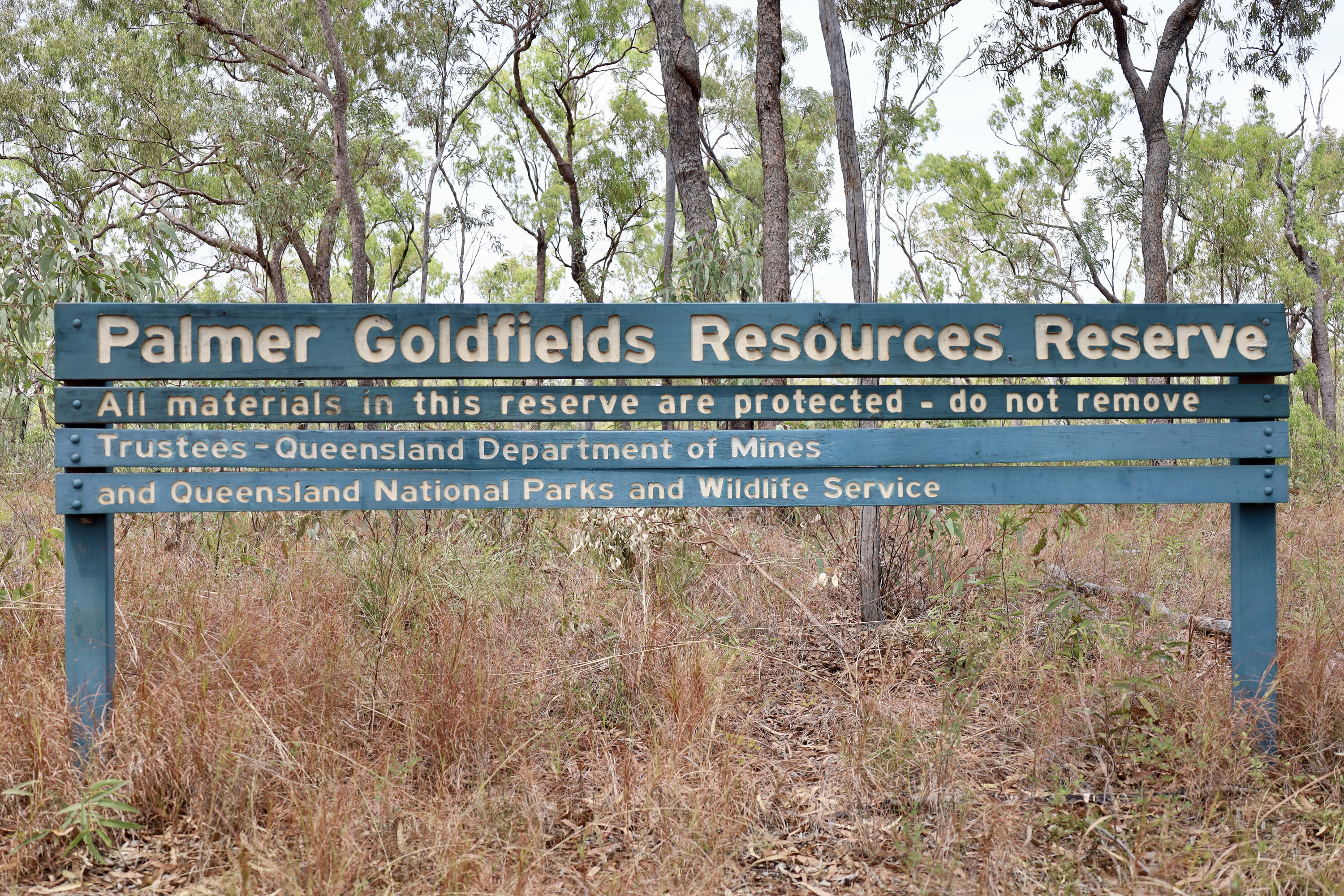
The goldfields consisted rich alluvial fields and lucky diggers had the opportunity to get rich quickly.
Many of those who struck gold would head back to Cooktown to spread their wealth, some miners spending it in the ale houses and brothels, others cashing in and leaving, while some would buy more supplies and trudge back to the Palmer.
There was a proposal to put in a railway line from Cooktown out to the now established Maytown, but with a lack of workers and gold petering out, the line never extended past Laura, just 108 km away. Today, massive bridge piers can be found near the Laura River, and this section of the line is now called the track to nowhere, because it never reached Maytown.
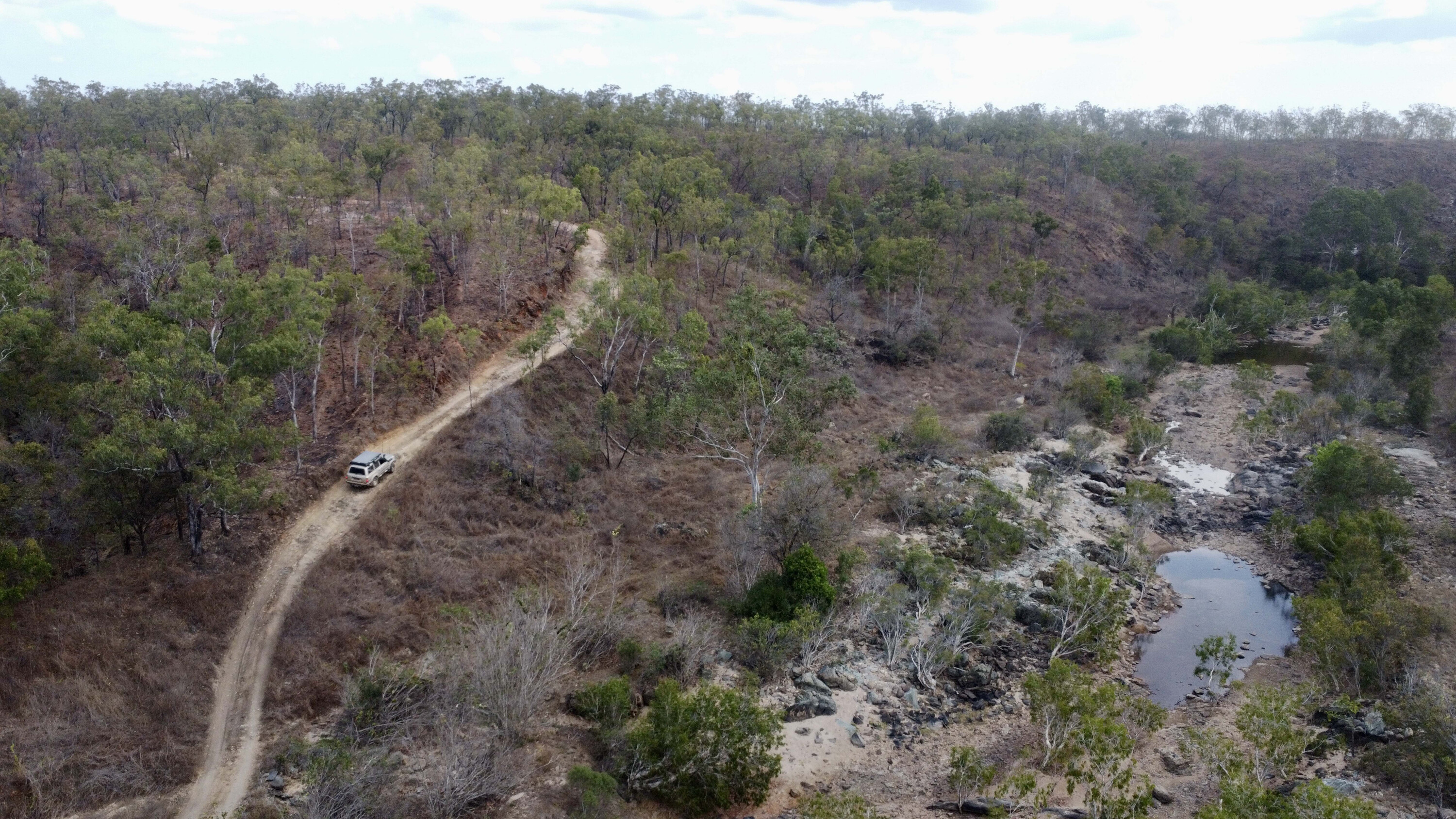
The Palmer River Goldfields only boomed for a short time as the gold became harder and harder to find. Miners left and shopkeepers closed, following the miners to new fields.
Today and the Palmer River area is a quiet place apart from four-wheel drivers, prospectors with metal detectors, and history buffs all seeking to explore the area. My journey into this historical area started at Laura, about 350km north of Cairns, and this would be my only stop for fuel for several days.
Finding the turnoff to Maytown is as easy as heading down the maintained Palmerville Road until the Maytown sign, and taking the Old Coach Road, which is regarded as one of the hardest and most challenging tracks in Cape York.
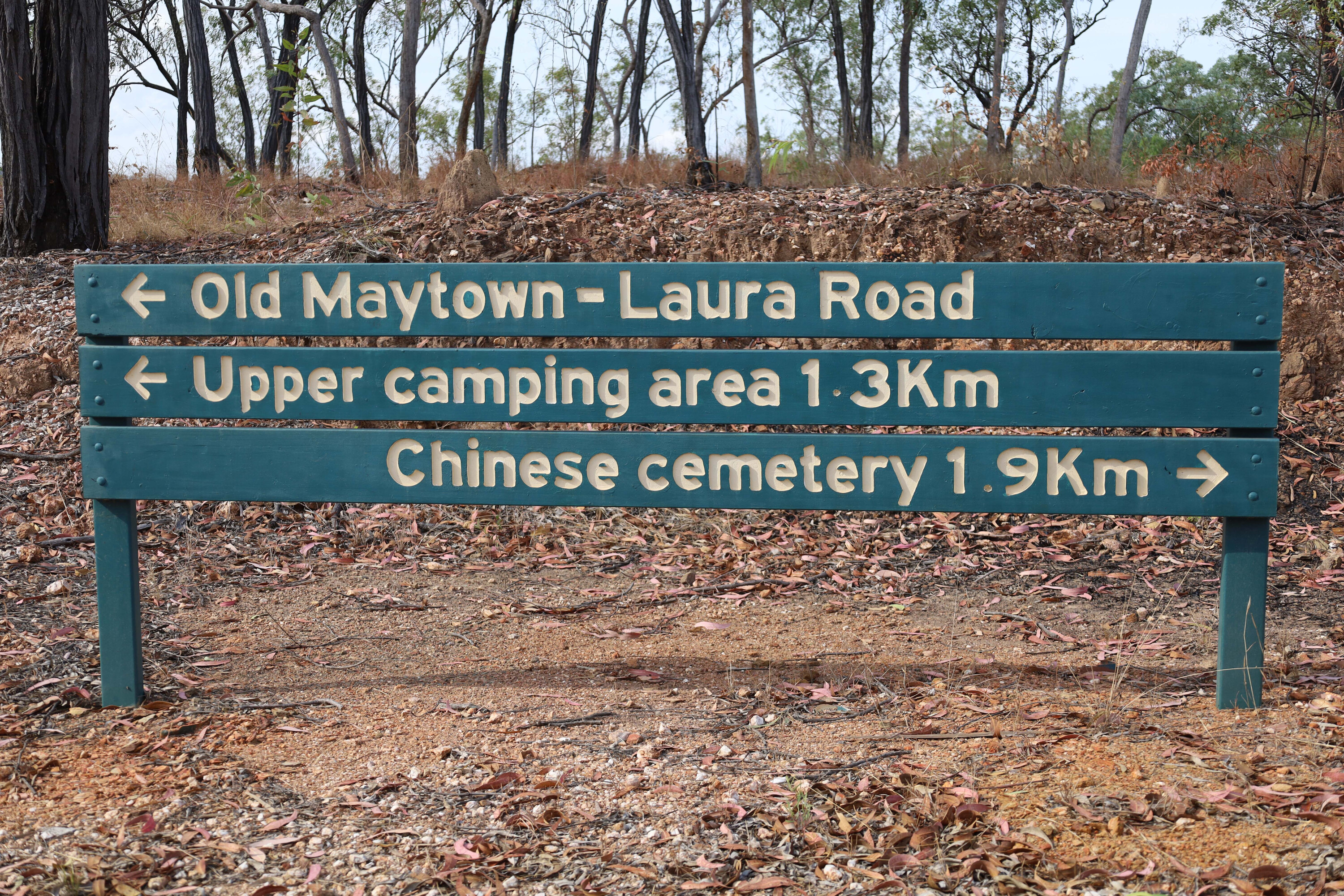
Right from the start, the Old Coach Road was challenging, with steep drop-offs, rocky sections, ruts that criss-crossed the road, and rocks strewn everywhere.
It took me nearly eight hours to cover 90km, and sections of the road were barely wider than my LandCruiser, and often with a steep drop on one side and high cliffs on the other. Despite visiting in the dry season, there was still water in the Palmer and Old Palmer rivers, which made for a nice break in the drive, while panoramic views from high points along the way offered a glimpse into how hard and inhospitable this land is.
Maytown is today littered with an array of historical ruins including stone walls and rusted and weathered pieces of metal, but one of the main attractions is the cobblestone kerbs and walkways that can still be found, and were made mainly from local slate.
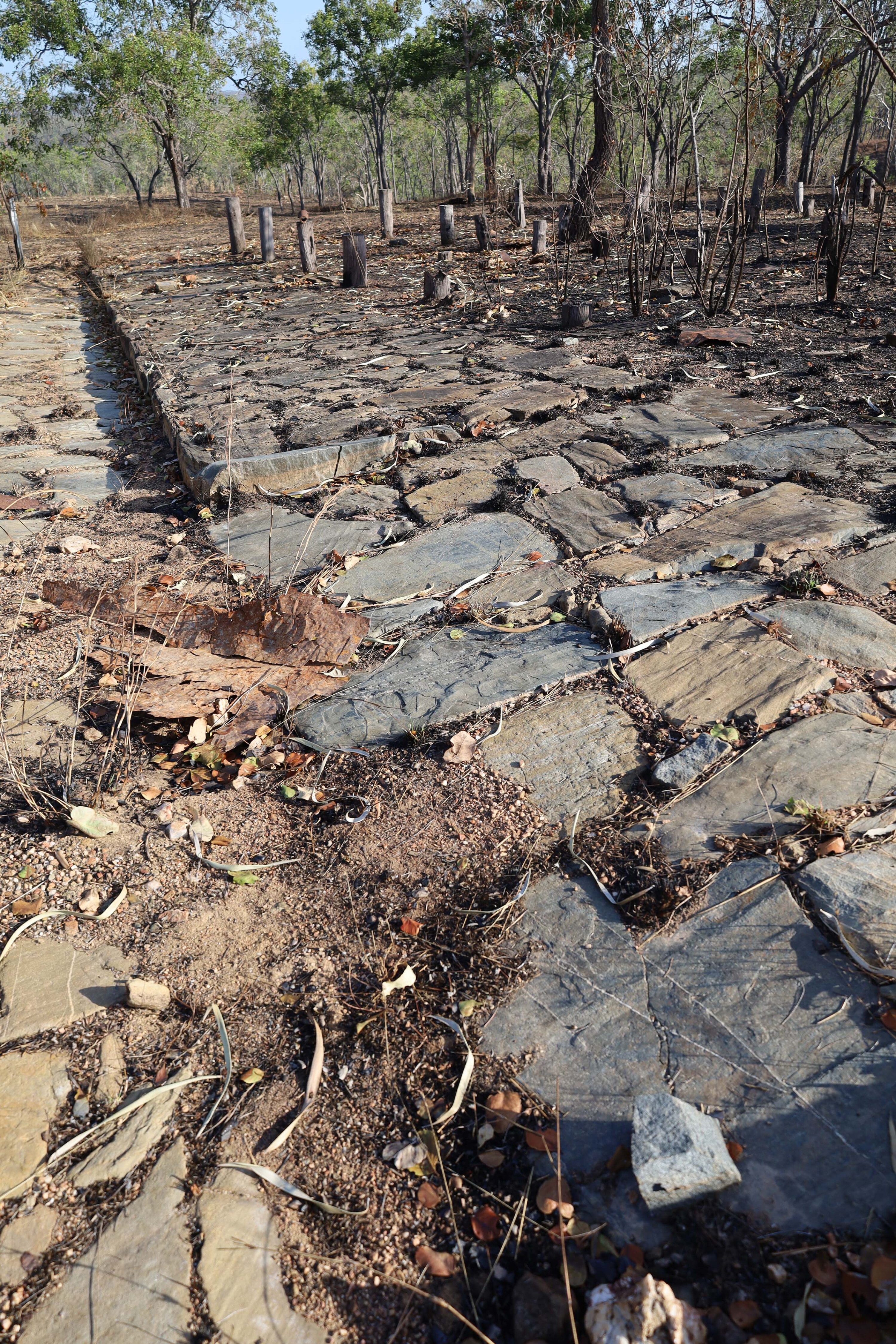
The integrity of the laid rock is impressive all along the main street and some of the old shops have the same stonework right up to where there doorways would have been.
It was good to see plaques indicating the names of shop owners and their type of businesses, and nearby a replica miner’s hut has been built, and it is full of relics and memorabilia from the area.
I spent the day exploring the old mine sites where stampers, boilers and massive pieces of broken steel lay on the ground. Deep mines that were once a hive of activity now lay abandoned, and are fenced off, while information signs describe how hard mining life was due to the isolation and the lack of water.
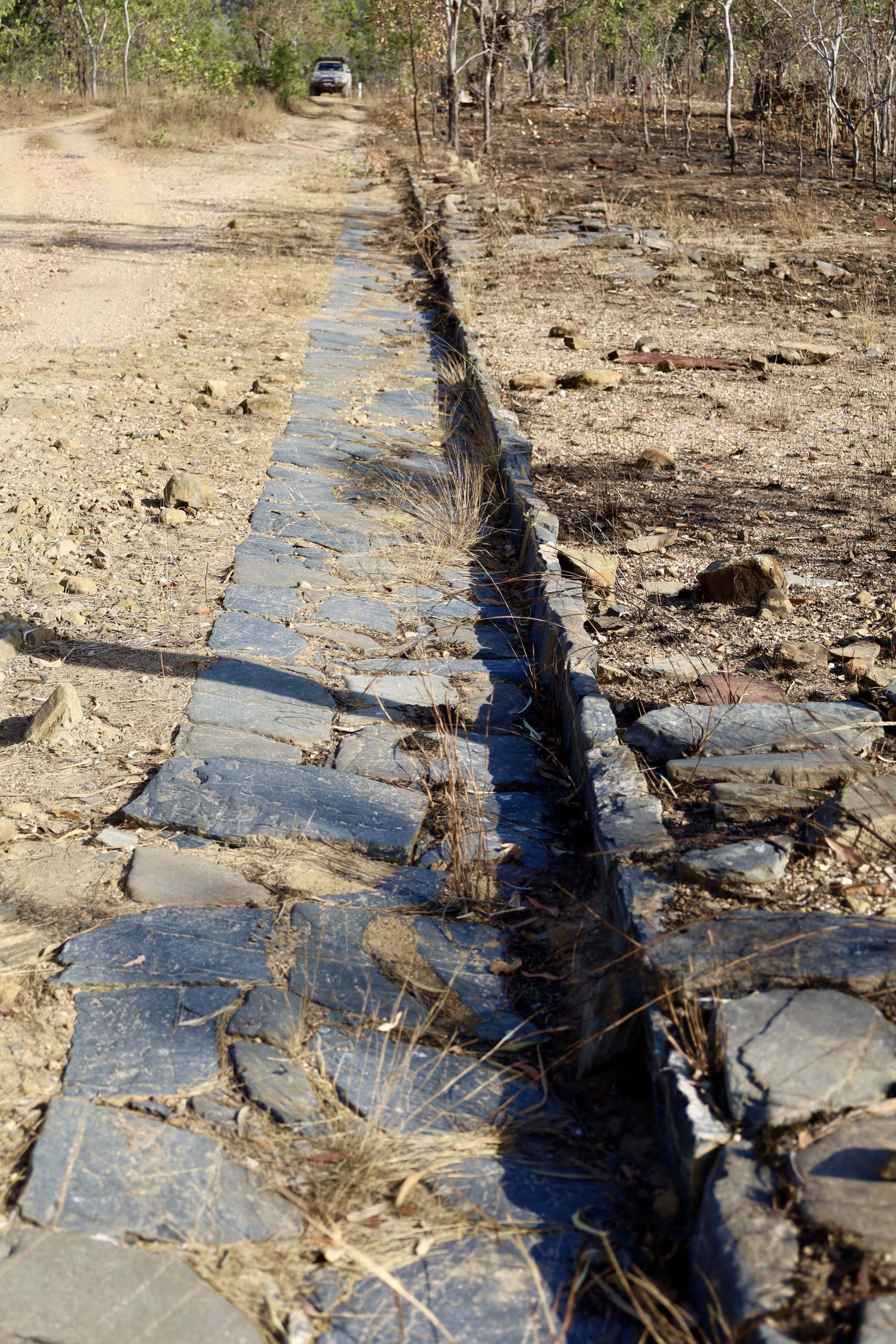
One of the most significant sites was the Comet Mill and mine; part of the National Estate Register this site has been persevered for the future as it’s one of the largest intact original collections of 19th century mining equipment.
The Comet was huge for its day with a massive boiler and a 10-head stamper with 25hp engines. Unfortunately, water was an issue again, with none of it available during the dry season but too much of it during the wet season, resulting in flooding.
Walking around I was amazed to see a lot of equipment stamped with ‘Made in Melbourne 1882’, making my trip here seem comparatively easy driving a modern vehicle.
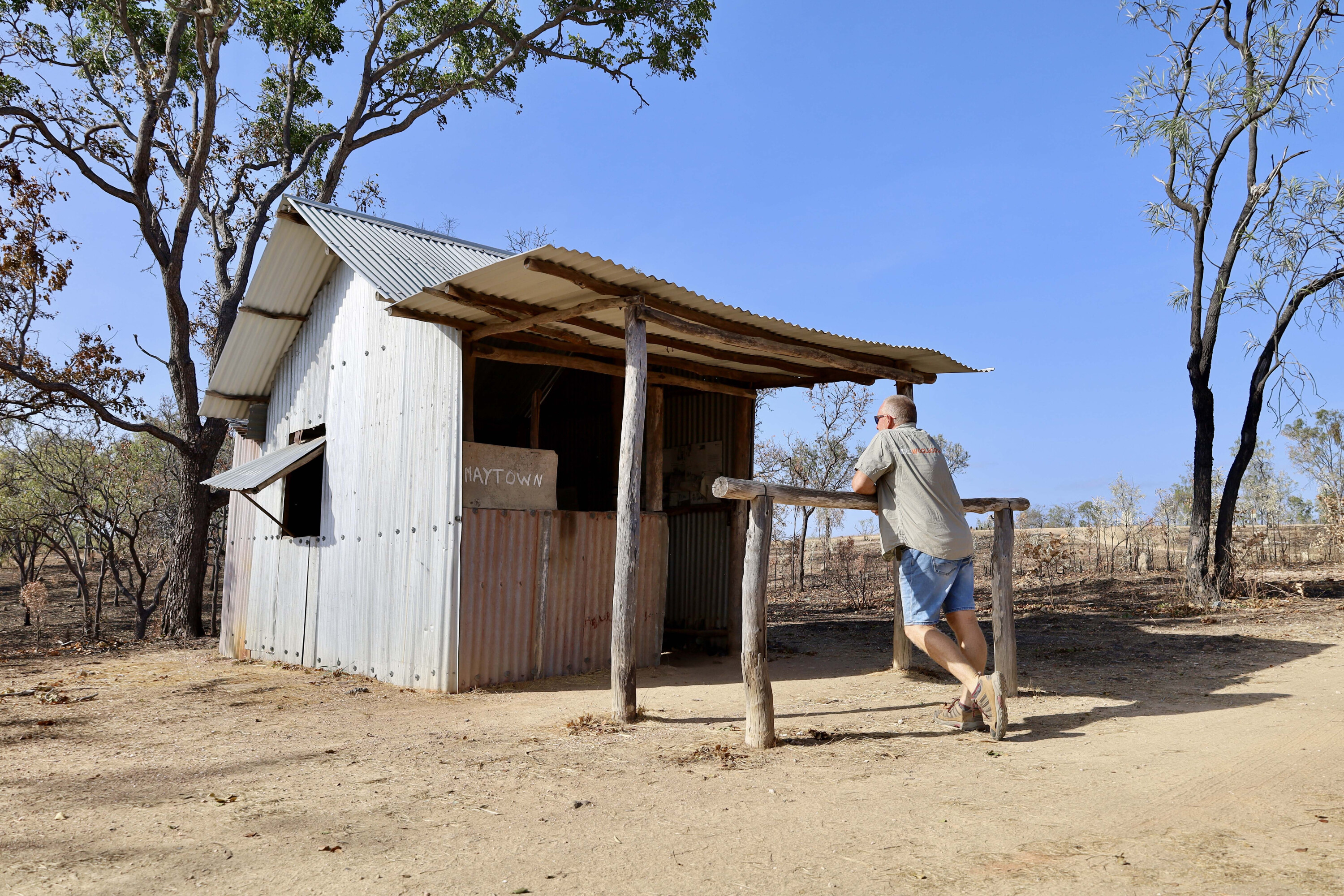
After spending a few days exploring Maytown, camping on the beautiful Palmer River and tackling the Old Coach Road, it was time to head south.
Crossing the river it’s a good 80km drive back out towards the Palmer River Roadhouse along Whites Creek Road and to civilisation.
Like any book that describes conflicts, exploration and riches from days long gone, there might be a little fiction mixed in with the facts regarding the history of Maytown, but one thing is for sure, this is a fabulous place to visit for anyone interested in taking a journey to into our colonial past.
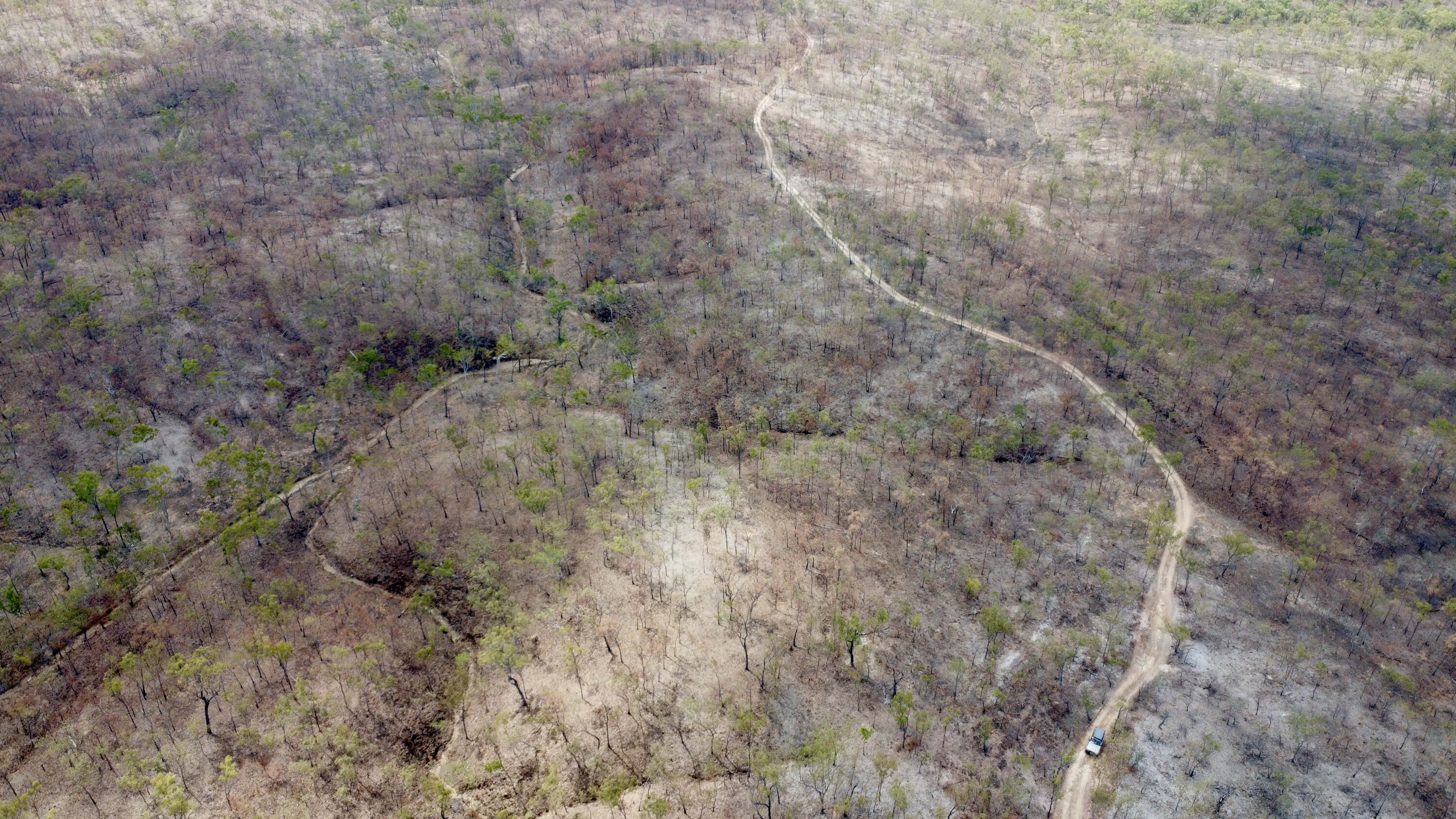
Where’s Maytown?
Maytown and the Palmer River Goldfields are in Cape York in far north Queensland.
Once known as the largest and richest goldfields in Australia, it’s now a remote, deserted and isolated region where a capable 4×4 is necessary to get around. Nearly 600km north of Cairns, there is plenty to see and do for the avid adventurer, gold hunter and historian.
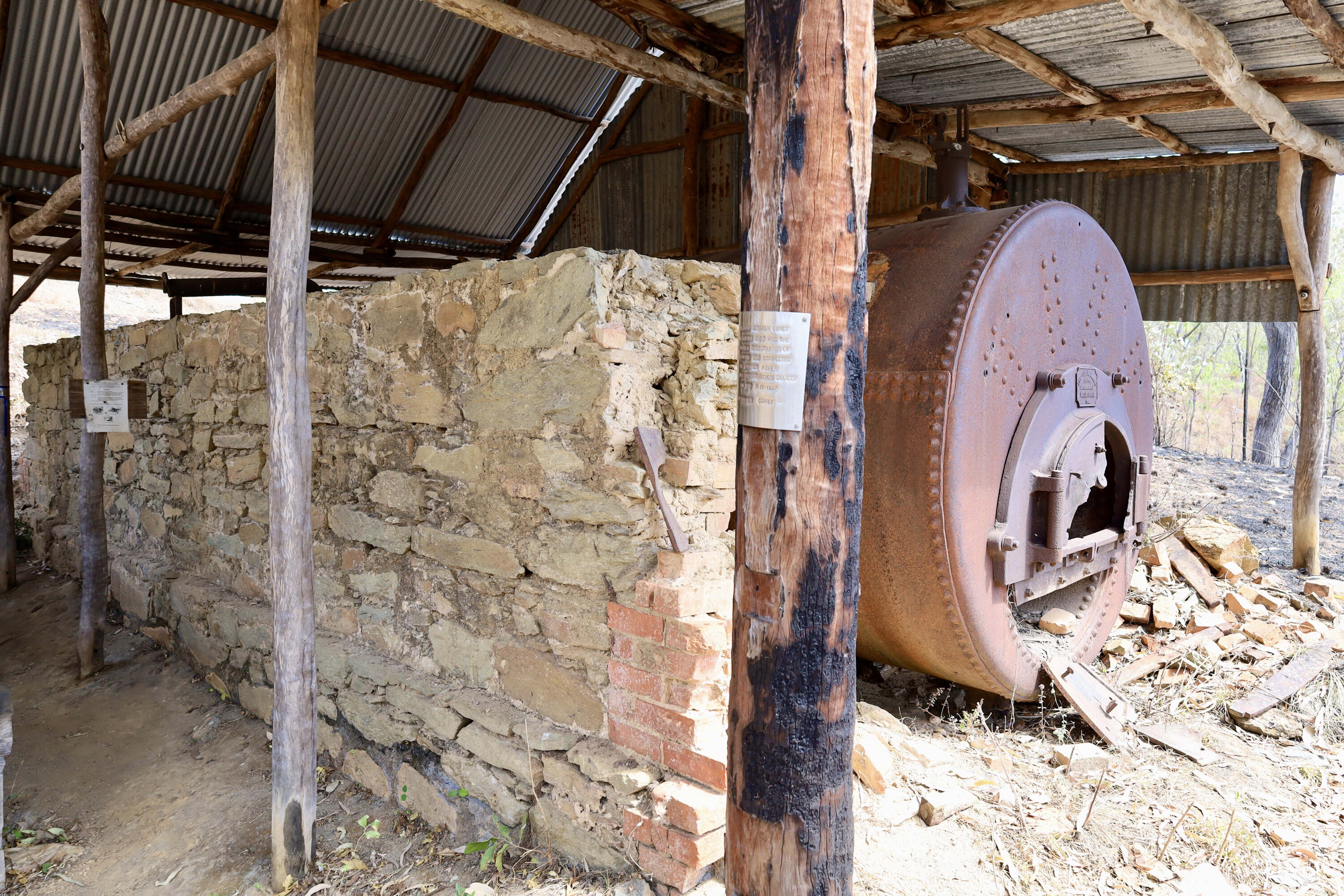
What to see, do and expect
This harsh region used to make or break good men, but today it’s a go to area in Cape York for gold hunters seeking riches.
The Old Coach Road on the northern side of Maytown is a four-wheel driver’s dream; it takes a full day to complete the 80km drive. You’ll need a good two to three days in here to wander around the old town, find the mills and stampers, and to enjoy the serenity at the camps on the Palmer River.
There are no services once you leave Laura, so you must be well equipped and supplied.
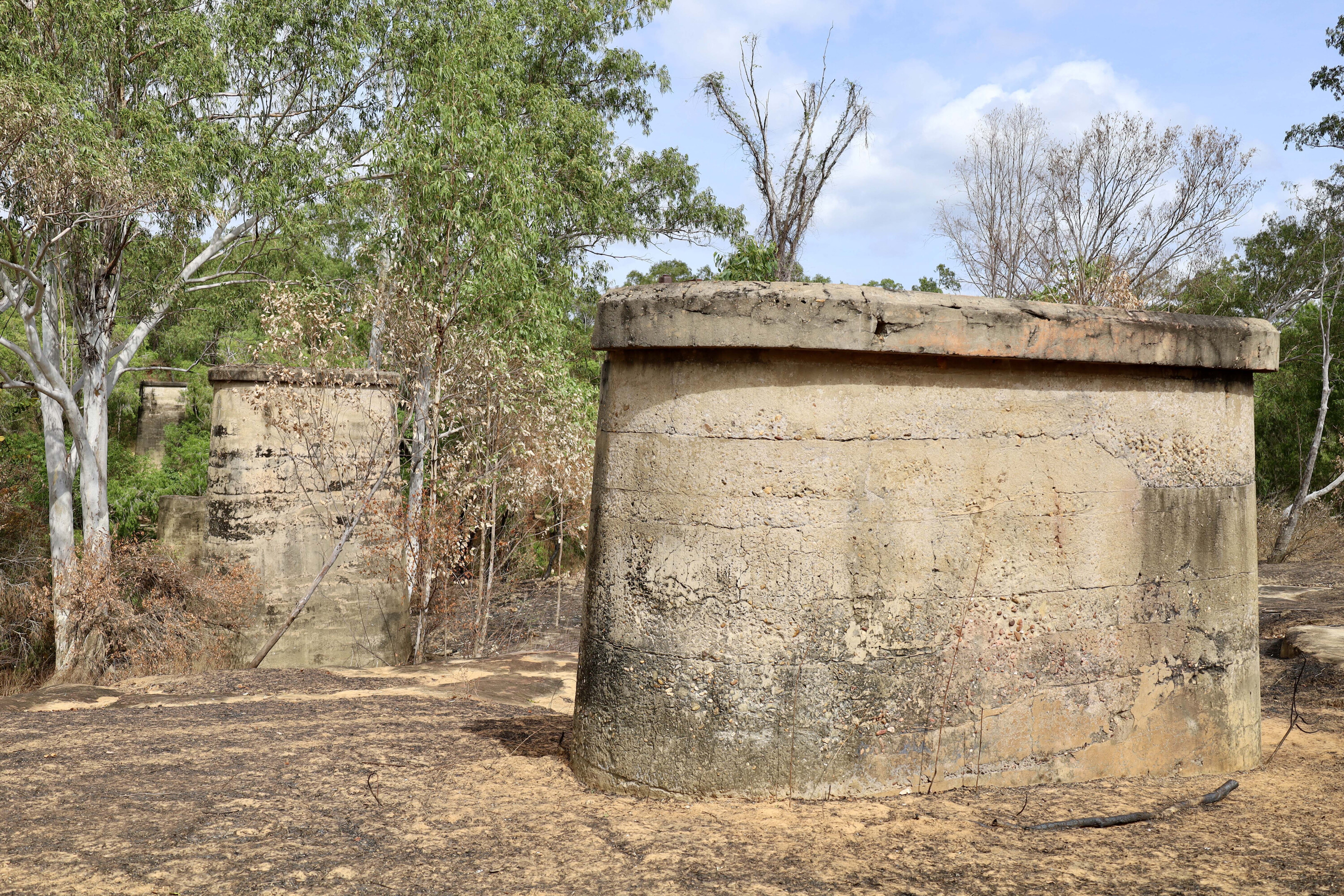
Other facts
This is a very remote part of Cape York and the Old Coach Road is regarded a difficult track.
A high-clearance vehicle is needed and towing a trailer would be tough on the track from Maytown to Laura due to steep angles, narrow cuttings and big ruts.
You will need a decent map of Cape York or a good GPS. Most tracks and points of interest are marked along the way. The old Maytown town site is a great place to spend a few hours wandering around looking at relics.
The best time of the year to go is in the cooler months after the wet season has passed.
Razed Products realised that a range of lockable, lightweight Rooftop Boxes would create valuable space on a roof rack, so they set about manufacturing the RSB-1 as a starter and, with its popularity, added the RSB-1M and the RSB-2.
The Rooftop Boxes were developed to include several excellent features that suit 4WDers, tradies and campers who are looking for additional storage space for their gear with security in the form of lockable latches and easy access. These feature-packed cases are perfect for storing your 4WD recovery gear such as snatch straps, winch extensions, EQ straps, shackles, as well as axes or shovels. This means you can keep your wet and muddy gear out of the 4WD and up on your roof rack.
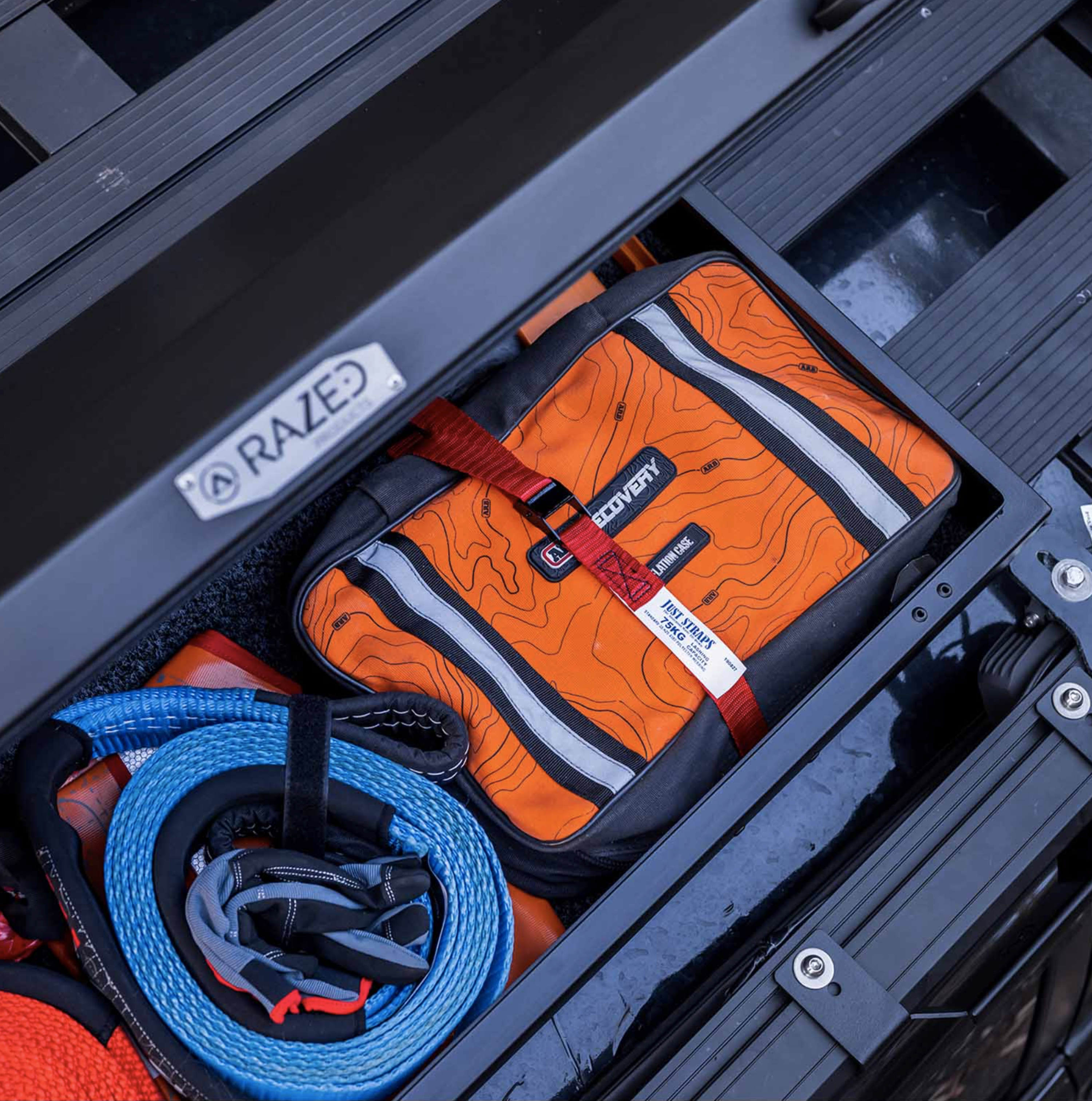
“We wanted to make a proudly Australian-made aluminium storage solution that was lightweight, strong, slimline, weatherproof – plus lockable that was extremely secure via internal fixings,” said Razed Products’ Scott Glover. “We knew about other options for storage out there, but none of them stood out from what we wanted to achieve.
“We didn’t want a plastic box or a chunky RAW aluminium toolbox on our vehicles; or to add too much height which at the time other options were either a lot taller, bulky or just inconvenient to use or access, with straps getting in the way and limiting access and making it hard to get items out when sitting on top of your roof.”
The Rooftop Boxes mount to roof platforms using all stainless-steel hardware including channel nuts, washers and bolts, and they have pre-cut fixing locations to mount in a range of positions and locations on your roof platform. They are lightweight with black powder-coated aluminium construction, the lids are lockable with concealed fixings for security, and they are rubber-sealed and gas-strut supported.
“With our RSB system, we wanted it to be easy to mount to an array of roof rack systems including Rhino Rack, Yakima, Rola Titan, plus others,” explained Scott. “Recently we developed a system to enable mounting to the popular ARB Base Rack, this has been in conjunction with designing and launching other Base Rack solutions based on other items in our product range.”
The RSB-1M expands on the RSB-1 with the new design incorporating external Maxtrax mounts in the lid of the storage box, which adds convenience and leaves more space to store gear inside. This differs from the RSB-1 and features four locating pins that enable you to store up to 4 Maxtrax MkII or XTREMEs inside the case.
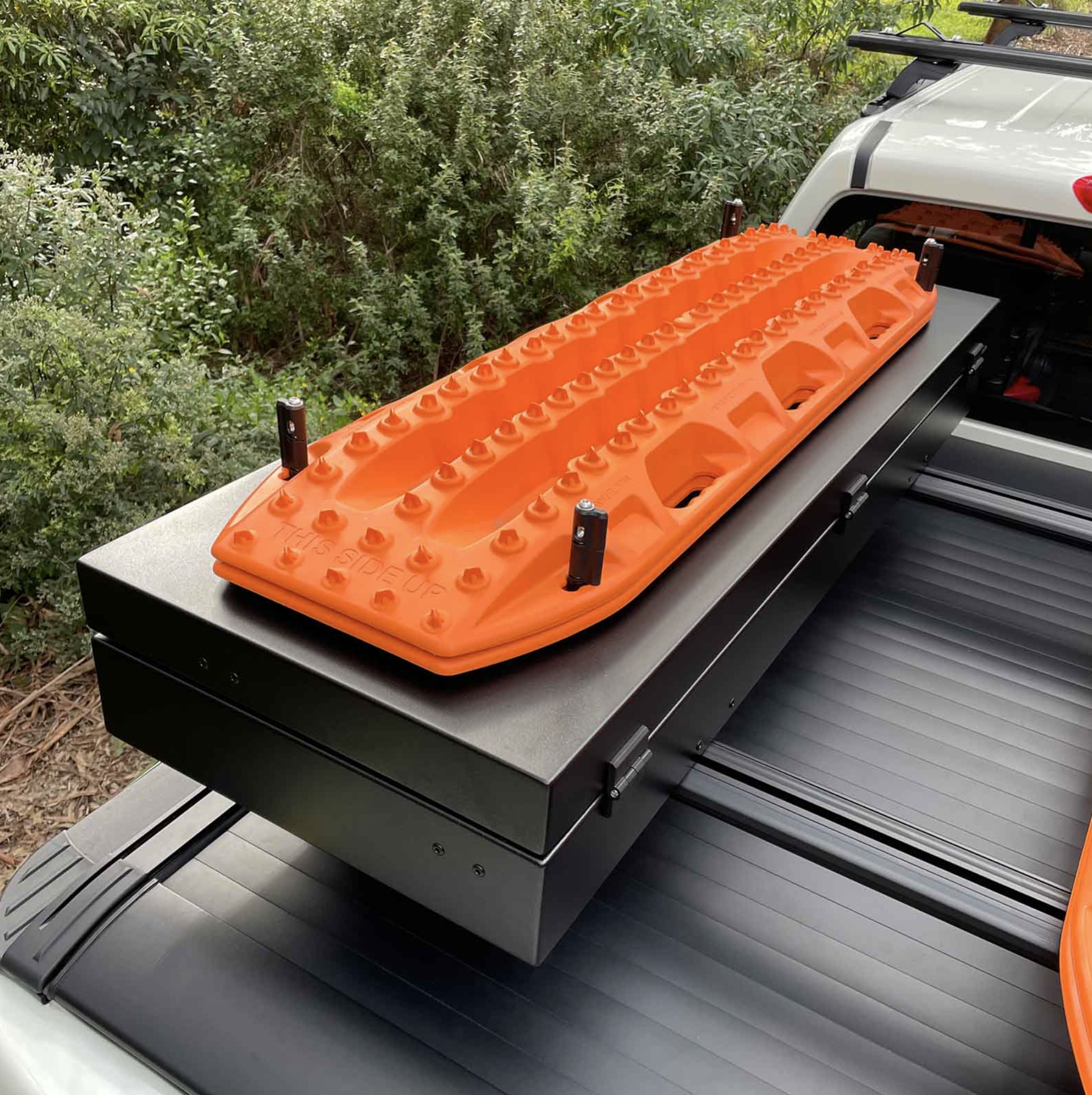
The RSB-1 and RSB-1M also include integrated shovel holder points on the front, where you can attach a set of Yakima Ace O’Spades (not included) which allows you to carry your shovel or axe on the side of your storage box.
The RSB-2 is the smaller of the three storage boxes with external dimensions of 950 x 410 x 175mm and a volume of around 60 litres. The RSB-1 has dimensions of 1220 x 430 x 200mm and a volume of approximately 90 litres. The RSB-1M dimensions are 1220 x 430 x 170mm (270mm overall height including the Maxtrax pins) and is approximately 85 litres in volume.
Pricing (RRP)
- RSB-1: $650
- RSB -1M: $699
- RSB-2: $550
Modifying a four-wheel drive for off-road travel is inevitable for most owners with an appetite for adventure, but loading a 4×4 with gear – think bull bars, roof-top tents – or hitching a caravan or camper trailer behind it can vastly increase overall weight and lead to the vehicle being overloaded.
From the factory, a vehicle is stamped with a GVM (Gross Vehicle Mass) rating by the manufacturer, which indicates the maximum weight a vehicle can legally carry – this includes the vehicle itself, on-board passengers, all cargo, and any aftermarket accessories installed. GVM isn’t to be confused with GCM (Gross Combined Mass), which essentially is the combined weight of a vehicle and what it’s towing. For example, a Mitsubishi Triton GLX+ has a GVM of 3200kg and a GCM of 6250kg.
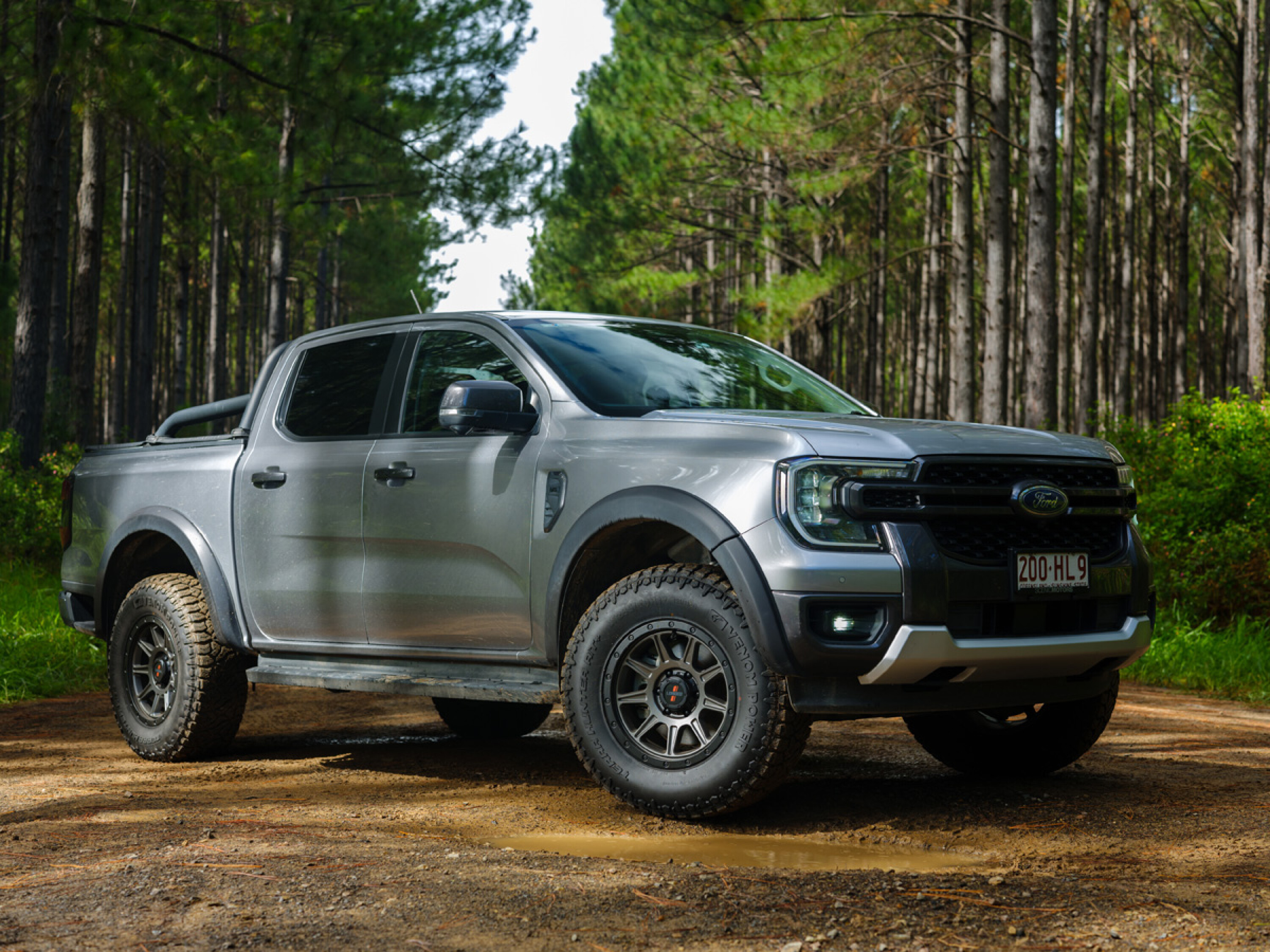
A GVM upgrade involves modifying a vehicle to increase its GVM rating, which means it can legally carry more weight than the factory GVM limit. It’s a big, multi-faceted process that typically involves upgrading the suspension with stronger springs and shocks; upgrading the brake system so that it can cope with the added weight; and reinforcing the chassis to support the increased weight.
However, often overlooked is the importance of wheel load-rating for vehicles carrying heavy loads and/or with GVM upgrades. There’s plenty of information on the web about tyre load ratings, but it’s important for four-wheel drivers to also know about wheel load ratings and the potential risks of overloading wheels. In fact, many OEM factory rims do not even have a load rating marked on the wheel. Alloy wheels fitted to vehicles that are overloaded can crack as a result of impact or the forces produced while driving over uneven surfaces.
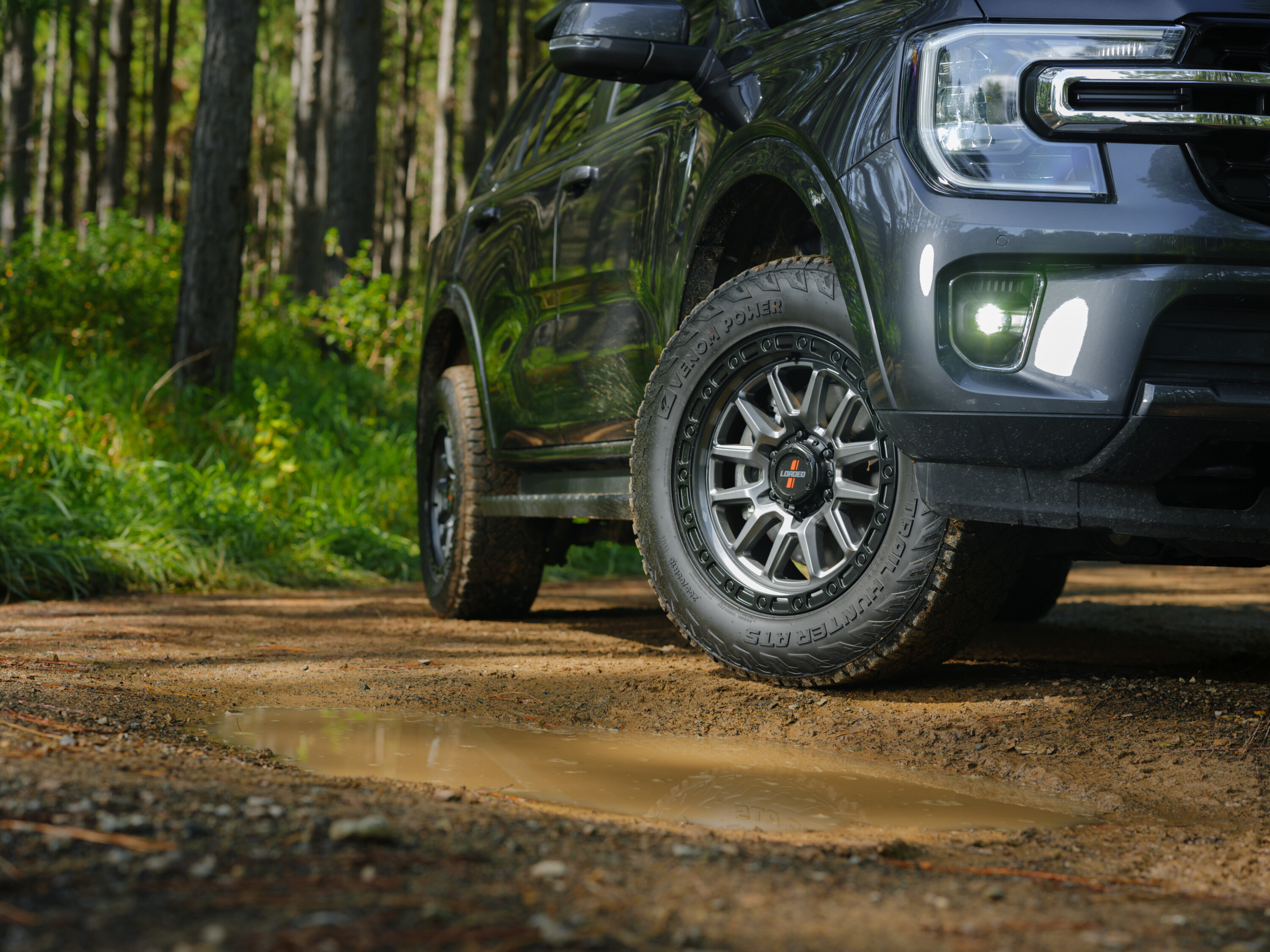
LOADED is a new brand in Australia that was developed at the Brisbane headquarters of Neta Tires & Wheels, an Australian company with a 65-year history in Australia.
“Our customers were asking for a high load-rated/GVM alloy wheel brand,” said National Wheel Manager, Scott Knight. “Every LOADED wheel has a 1675kg load rating, giving it greater strength, shock resistance and making them ideal for vehicles carrying heavy loads and/or with GVM upgrades. LOADED offers you peace of mind.”
The specialised alloy wheels are manufactured using a “flow-form” process, which makes them lighter, stronger and more shock-resistant than conventional cast-alloy wheels. The “flow-form” process uses hydraulic rollers to elongate, compress and shape the wheel barrel, which in turn modifies the microstructure of the metal and increases its tensile strength for higher load capacity and greater shock-resistance. Other brands, on the other hand, achieve a higher load for a standard cast wheel by adding more material. This results in a heavier wheel that compromises performance by slowing acceleration and reducing fuel efficiency.
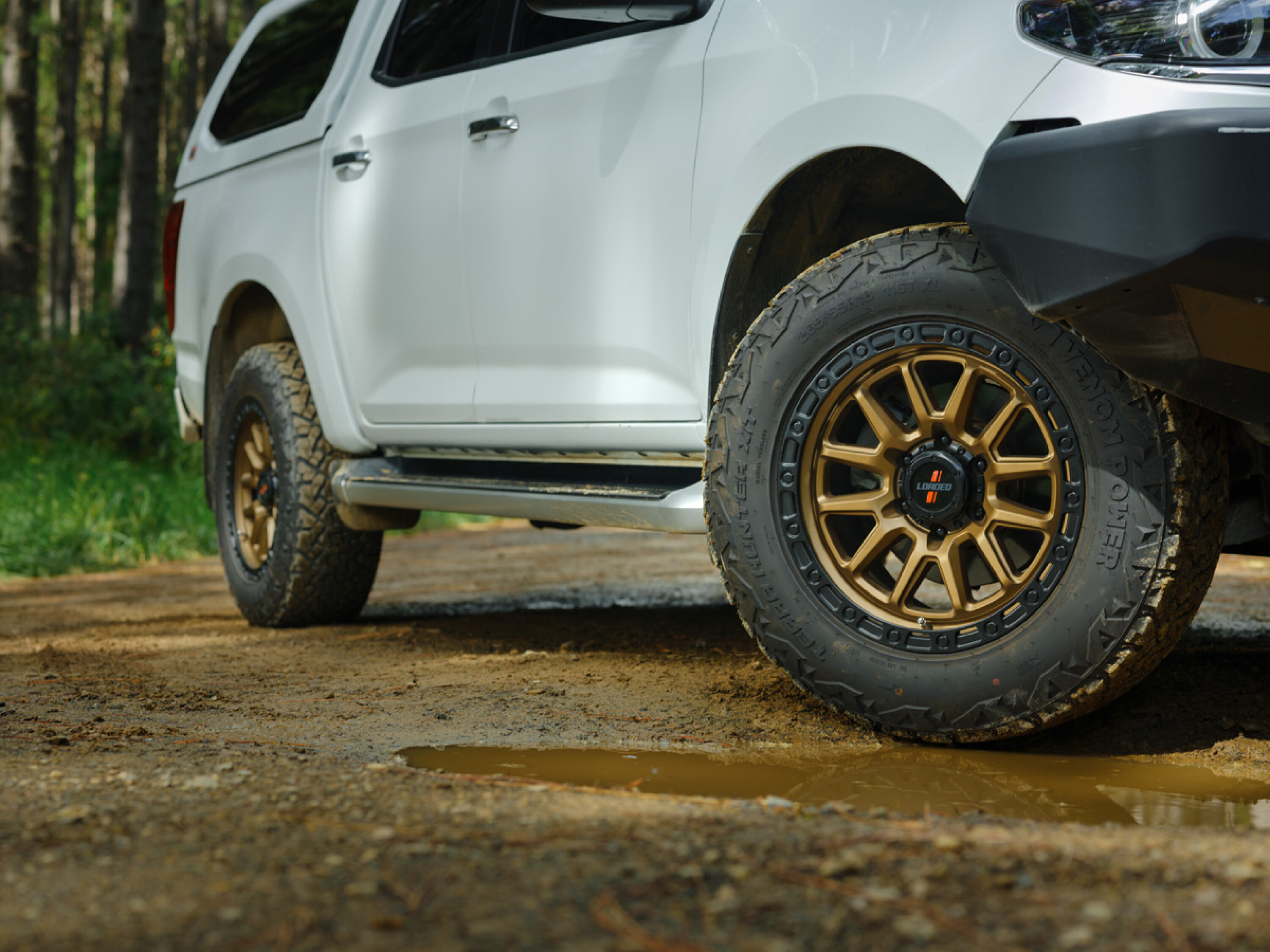
LOADED wheels have passed rigorous international testing standards for impact, bending fatigue and radial fatigue, and are backed by a lifetime structural warranty (conditions apply).
Touring Solutions Australia (TSA) specialises in GVM upgrades, and engineers at the Australian company recently approved and endorsed LOADED wheels for vehicles fitted with its GVM upgrade and lift kits.
“After careful consideration, Touring Solutions Australia (TSA) welcomed the opportunity to introduce LOADED wheels to its certified installer network,” said Todd Kranen, Sales and Business Development Manager at TSA. “LOADED Stockton and Gunbarrel wheels offer our network an attractive-looking wheel in a common PCD. Not to mention, LOADED have the testing and data to back its massive 1675kg load rating!”
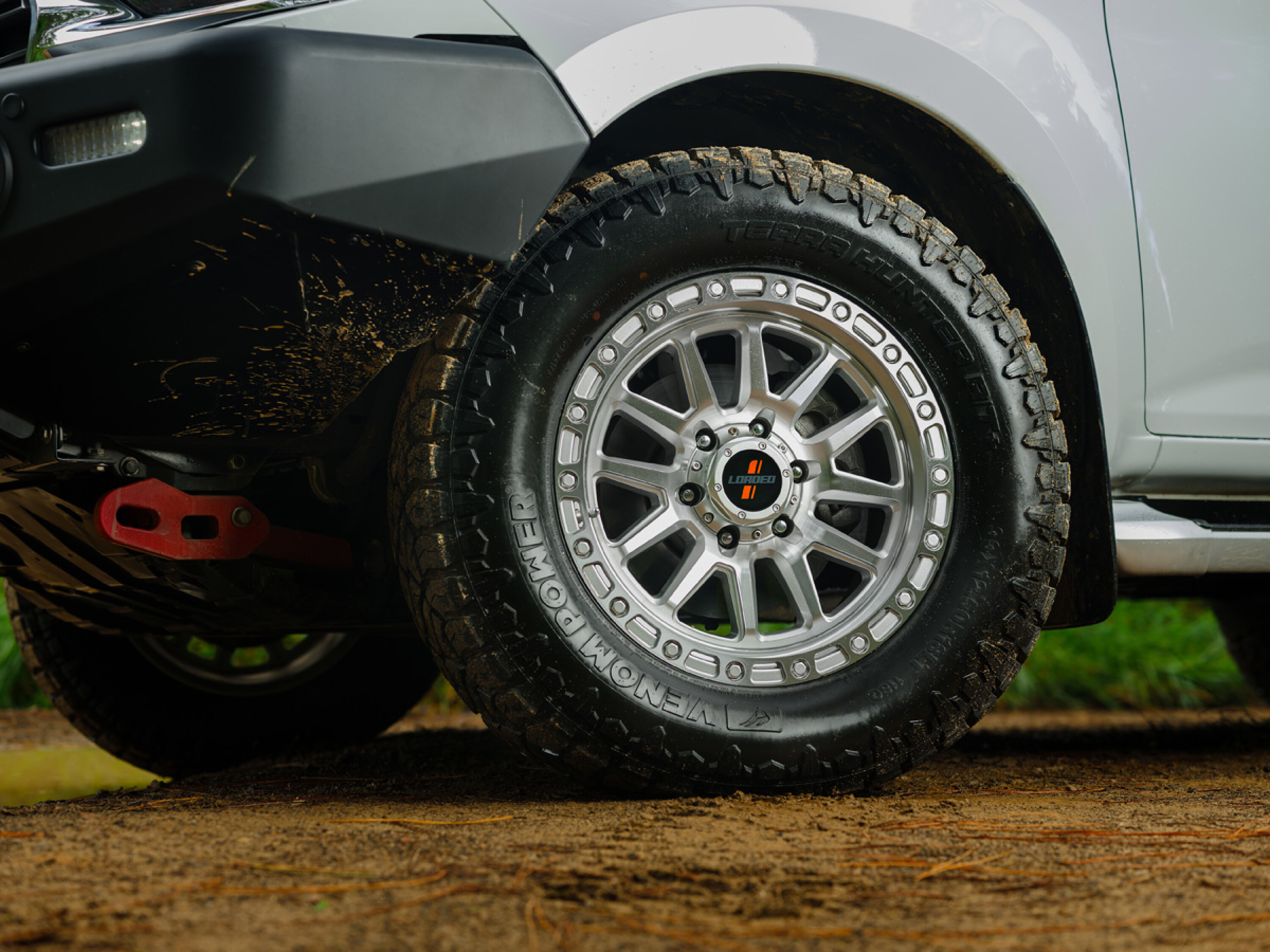
Todd told us that when increasing the GVM of your vehicle, it is imperative to utilise a wheel – like the LOADED range – that is rated for the increased GVM load.
“Given the increased payload resultant from a GVM upgrade, the entire weight of the vehicle is carried by the wheels,” he said. “In the absence of wheels rated for the increased carrying capacity, there exists a tangible risk of vehicle damage or compromise in ensuring a safe journey home.”
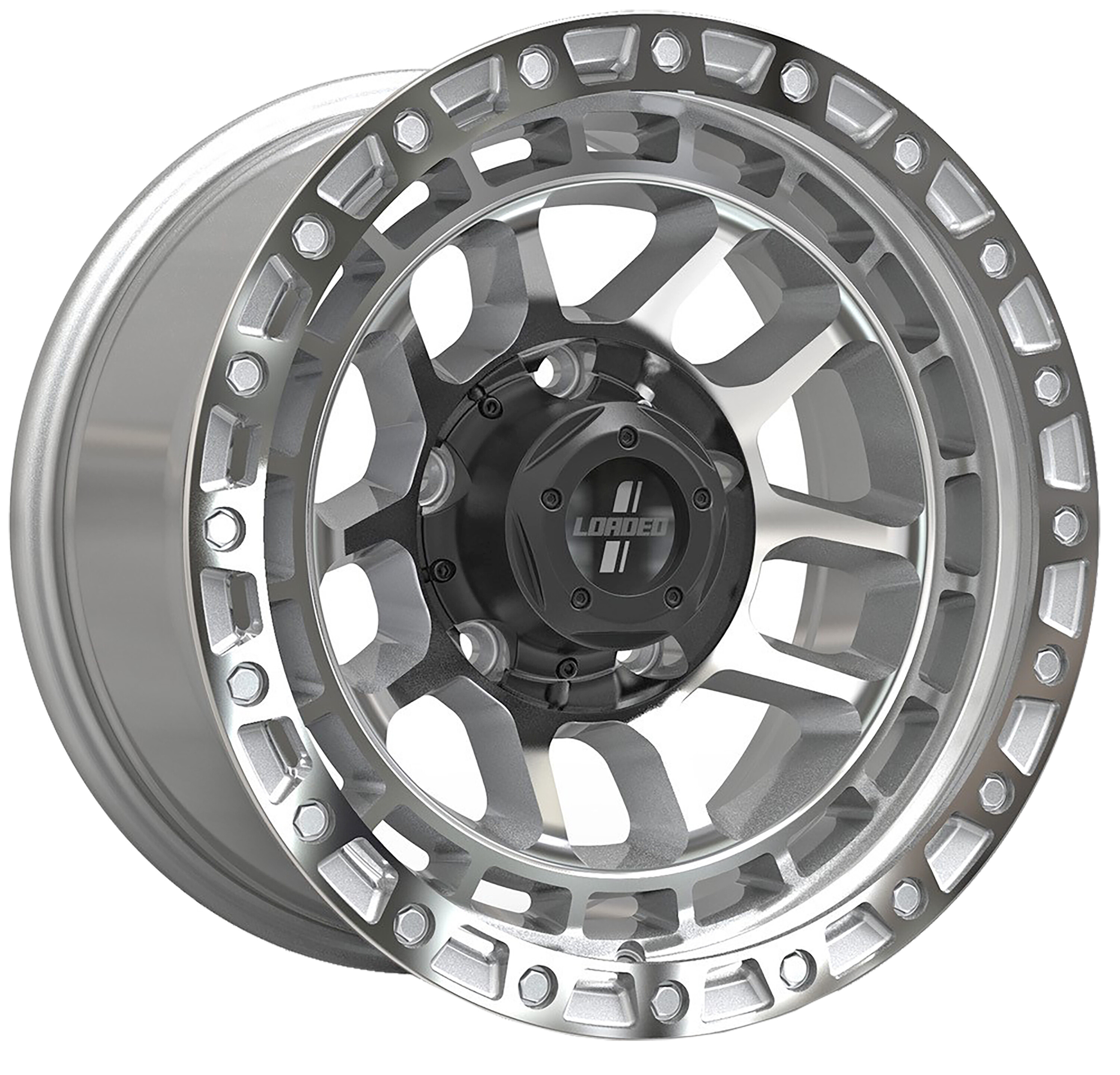
Recre8 Automotive Group also specialise in GVM and GCM upgrades across its Rambler Vehicle builds and ASG 4×4 dual-cab conversions, and the Brissy company has recently adopted LOADED wheels as a preferred option on its builds.
“When increasing the GVM and GCM of 4WDs, particularly when we chop them in half into dual-cabs, wheels are a significant consideration. We often see vehicles set up with heavy loads and towing large caravans or boats where the wheels simply aren’t rated sufficiently for the job,” cited Kris Humphrys, Managing Director for Recre8 Automotive Group. “The LOADED Stockton and Gunbarrel wheels with their 1675kg rating exceeds the axle load requirements of our largest GVMs, giving that extra peace of mind.
“Our customers range from primary industries through to the resource sector and recreational users. These vehicles are not only required to carry loads up to their GVM and GCM but also do it while traversing remote and rugged areas where road conditions can challenge the durability of even the toughest vehicle – for this reason partnering with a quality wheel manufacturer such as LOADED Wheels is high on our list of priorities,” he added.
LOADED wheels are available in a range of finishes and 17- and 18-inch fitments to fit most popular 4x4s, with a new LOADED Gibb wheel in five finishes to suit the Toyota LandCruiser 79 Series coming soon.
Determining an OEM wheel rating
TSA’s sales and business development manager, Todd Kranen, explained to 4X4 Australia that the standard method to determine the OEM wheel rating involves taking the maximum rear axle load capacity specified by the OEM and dividing it by two.
“This calculation is crucial because it provides a reliable estimate of the load each individual wheel is designed to support,” Todd advised. “Essentially, since the rear axle load is distributed across two wheels, dividing the total capacity by two gives us the per-wheel rating.”
The Jeep Wrangler is the one model in the Jeep range that pays true homage to its WW2 ancestor, the original Jeep.
With eight decades of evolution behind it, it has been a slow progression, but the Wrangler has stuck to its roots as a proper, go-anywhere 4×4 vehicle. So much so that it remains the most capable off-road vehicle you can drive off the showroom floor.
2024 brings some significant upgrades to the JL model Wrangler, which was originally launched back in 2018. The big change is the switch from a naturally aspirated V6 engine to a turbocharged four-cylinder, but there’s also some new safety and infotainment tech amid a model range refresh.
The Wrangler range in Australia now starts with the Sport S model (replacing the Night Eagle variant), followed by the high-spec Overland model and the off-road-champion Rubicon at the head of the pack. All three models are available as four-door vehicles, with only the Rubicon offering both two- and four-door bodies. As always, all Wranglers have a removable roof, with multiple options for soft and hard tops and even a powered soft top.
The new 2.0-litre inline four-cylinder petrol engine backed by an eight-speed automatic transmission is the only powertrain offered, while the Pentastar V6 is on its way out altogether. For off-road use, Sport S and Overland models retain the Selec-Trac 4×4 System which gives part-time; dual-range; and high-range, full-time, on-demand 4WD.
The hardcore Rubicon models come standard with the unrivalled Rock-Trac System, offering a 4:1 low range ratio and 4.11:1 diffs that results in a 77.2:1 crawl ratio. Front and rear locking differentials and an electronic front sway bar disconnect combine with the Rubi’s standard BFGoodrich KO2 mud terrain tyres to give it the off-road edge over any other standard passenger car or truck.
Still disappointing and frustrating for Australian Jeepers is that our Rubicons don’t get the standard 33-inch tyres that the same cars are fitted with in the USA, let alone the 35s that are offered as an option there. At least if we got the 33s you could legally step up to the 35s if you wanted to. The 255/75-17 tyres fitted to international-spec Rubicons are equivalent to around 32 inches in diameter. There was one spot on the test drive where the Rubicon scraped its front diff on a rut where you wouldn’t expect it to, and the added clearance that 35s would afford would certainly fix this.
The Rubicon models also get a new, heavier duty, full-floating Dana 44 rear axle containing its 4.11:1-equipped locking diff. The heavier duty rear axle has helped to increase the payload of the Rubicon to 620kg, an increase of more than 200kg that will be much appreciated by users.
The Wrangler’s new GME T4 2.0-litre four-cylinder turbo-petrol engine produces 200kW and 400Nm compared to the 209kW and 347Nm of the previous V6 engine. It’s that extra torque of the turbo four that makes all the difference in the upgraded model, not only for its peak output but more for its broader spread of torque throughout the engine’s rev range.
Where the Pentastar V6 needed to be revved hard to get the most out of it (and it loved a rev), the turbocharged engine delivers its grunt from lower revs to make the new JL a nicer car to drive both on- and off-road. The ZF-derived eight-speed TorqueFlite transmission works well to make the most of the broader spread of torque and deliver acceleration that is both smooth and swift.
Our drive was in the four-door Rubicon model, and you certainly feel the sprightlier performance of the new engine, especially with the Rubi’s shorter gearing and even with the mud-terrain tyres. Jeep has made some improvements to the Wrangler’s body to better insulate the cabin from road noise and, while it’s noticeably quieter, you still hear and feel the humm of the BFGs.
Part of the changes to quieten the cabin is the inclusion of acoustic laminated in the front doors of the Rubicon models. In addition, the Wrangler’s front windscreen is now made of Gorilla glass, which is the same heavy-duty glass used on Apple iPhones and it’s said to be tougher than regular glass. The radio antennae has now moved into the windscreen glass, removing the whip from the front guard.
Also inside you notice the new dash pad that is no longer red but a soft-touch black material, while the big addition is the 12.3-inch panoramic multimedia touchscreen. As well as being bigger than before it includes the latest Uconnect 5 system with wireless Apple and Android phone mirroring. The four-door Rubicon now gets 12-way power adjustable, heated front seats, while the two-door Rubi only gets the powered seat on the driver’s side.
The old-school off-road design and construction of the Wrangler has never leant itself to making it the safest car, and it still only achieves a three-star safety rating despite the addition of new side curtain airbags for both front and rear passengers. Other standard safety kit includes rear cross traffic alert, front and rear cameras, forward collision warning, six airbags, and a TPMS.
While many buyers will still purchase a Wrangler for its iconic style, it remains a specialised off-roader. The Wrangler is far from the best on-road drive, its ergonomics are best described as odd, and its safety rating will scare off many a helicopter parent. Its price is up there as well at more than $90K for the four-door Rubicon.
However, it’s a fun car that offers so many options for driving with the roof on or off, on the road or in the roughest terrain. The Rubicon will leave any other stock 4×4 behind in the rough stuff and we’re glad it’s still here.
Specs
| 2024 Jeep JT Wrangler Rubicon | |
|---|---|
| Engineu00a0 | 2.0L 4-cyl turbocharged petrol |
| Max power | 200kW @ 5250rpm |
| Max Torque | 400Nm @ 3000-4500rpm |
| Transmission | 8-speed automatic |
| Transfer case | Rock-Trac with full-time and part-time 4×4 and low range |
| Crawl ratio | 77.24:1 |
| Steering | Electro-hydraulic |
| Suspension | Live axles on links, coil springs, stabiliser bars (f/r) |
| Tyres | 255/75-R17 |
| Tare weight | 2219kgu00a0 |
| Payload | 620kg |
| Towing capacity | 2495kg |
| GVM | 2574kg |
| GCM | 4819kg |
| ADR combined fuel use | 9.2L/100km |
| Fuel tank | 81L |
| Approach angle | 43.9u00b0 |
| Ramp-over angle | 22.6u00b0 |
| Departure angle | 37.0u00b0 |
| Ground clearance | 255mm |
| Wading depth | 760mm |
Pricing
| Model | Engine | Transmission | Drive | Fuel | Power | MSRP |
|---|---|---|---|---|---|---|
| Sport S 4dr | 2.0L turbo | 8AT | 4WD | Petrol | 200kW | $75,950 |
| Overland 4dr | 2.0L turbo | 8AT | 4WD | Petrol | 200kW | $84,950 |
| Rubicon 2dr | 2.0L turbo | 8AT | 4WD | Petrol | 200kW | $83,950 |
| Rubicon 4dr | 2.0L turbo | 8AT | 4WD | Petrol | 200kW | $90,450 |
For many people kitting out a new 4×4 vehicle, a raised air intake snorkel is one of the first pieces of equipment to go on the list of accessories.
A well-designed and manufactured intake snorkel not only raises the engine’s air intake point to reduce the risk of water entry when crossing rivers and creeks, but also lifts it above the dust trail of vehicles ahead. In addition, it improves the amount and rate of airflow into the engine, which is important if you want to make the most out of any other modifications designed to improve engine performance.
When it comes to intake snorkels, the Safari 4×4 brand stands above all others in that it is sold and recognised around the world. In fact, Safari 4×4 has been developing and manufacturing snorkels for 4x4s for more than 40 years.
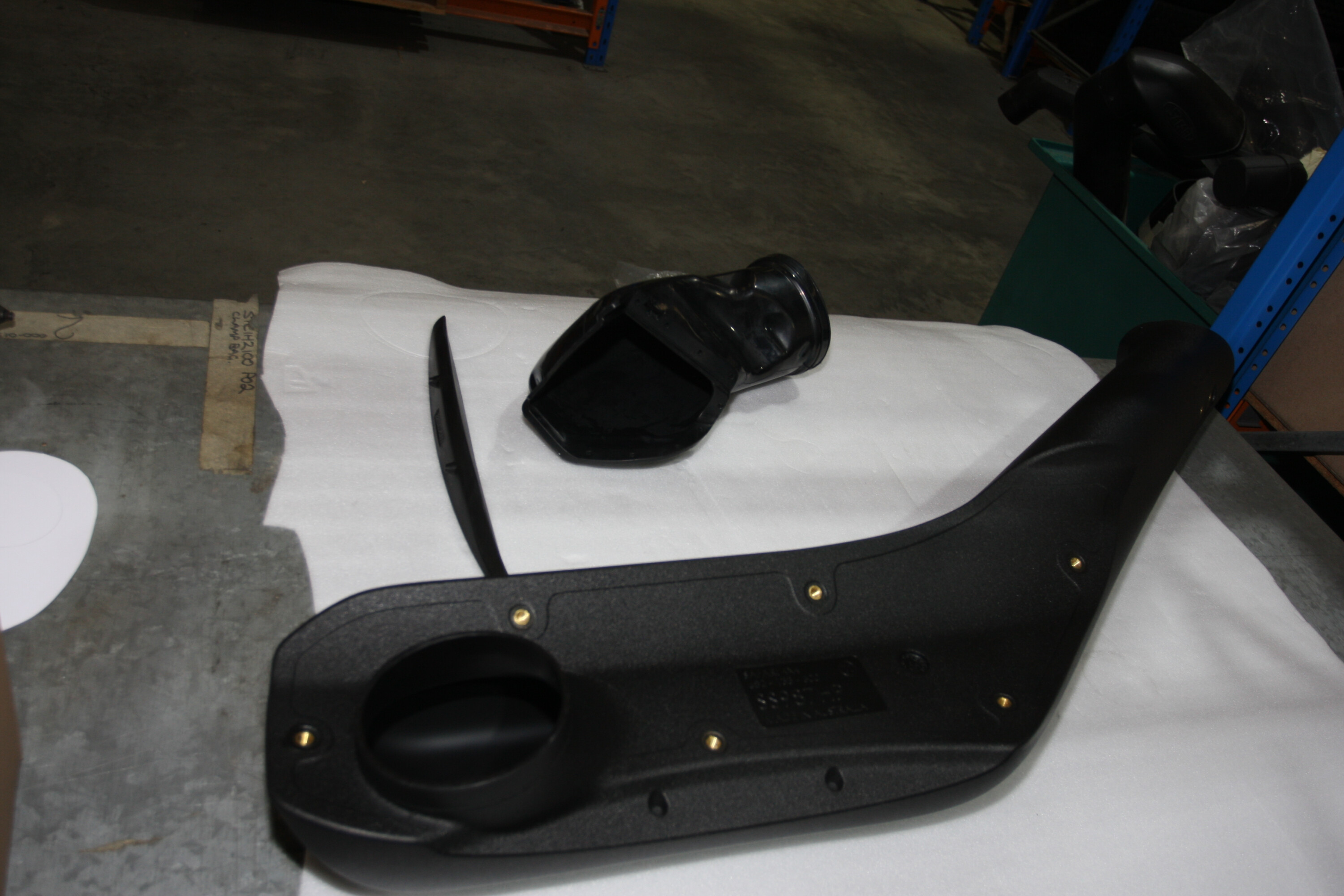
Proudly Australian, Safari 4×4 does its development and manufacturing right here in Australia, and that its products are made to withstand the harshest conditions on the planet to provide decades of reliable service on your 4×4.
When Safari announced that it had a new Armax snorkel in development for the current model Ford Ranger and Everest, we had no hesitation in turning to this company for an install on our Everest. Safari 4×4 already has its ‘V-Spec’ snorkels available for the latest Ford 4x4s, and these are Ford-approved accessory products available via your Ford dealer when purchasing a new Ranger or Everest.
The Armax range of snorkels are designed bigger to deliver even more airflow to the engine to meet the demands of modifications such as tuning kits and larger exhaust systems.
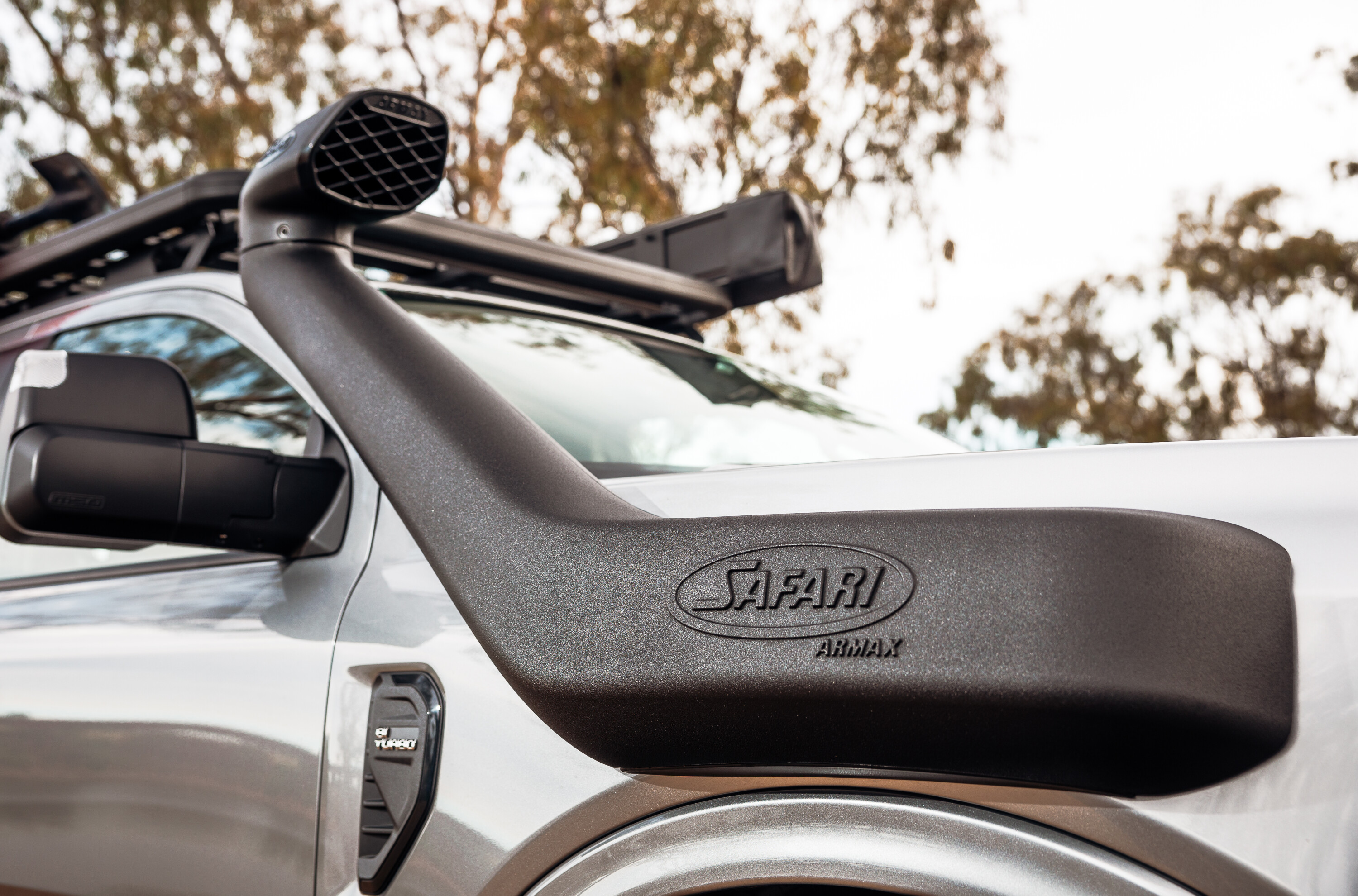
Internal combustion engines are, after all, just big air pumps and improving their efficiency and performance comes down to how much air and fuel you can put through them. A bigger, better flowing intake gets the air into the engine; tuning the engine manages how it is ingested and burnt; and a bigger exhaust system takes the burnt gases out of the engine. Safari uses an in-house chassis dynamometer to test the performance of its products fitted to vehicles to ensure the benefits are documented.
The polyethylene material used in roto-moulded Safari 4×4 products was developed to not only be tough and durable but to have high levels of UV stabilisation to cope with the harsh environment on the outside of your vehicle. It’s this quality that allows Safari 4×4 to offer a lifetime warranty on its snorkels.
The Safari snorkel on my 1985 LandCruiser, for example, is almost as old as Safari itself and it shows no signs of damage or fading after four decades of service, so it was a no-brainer to go with a Safari snorkel for our latest build.
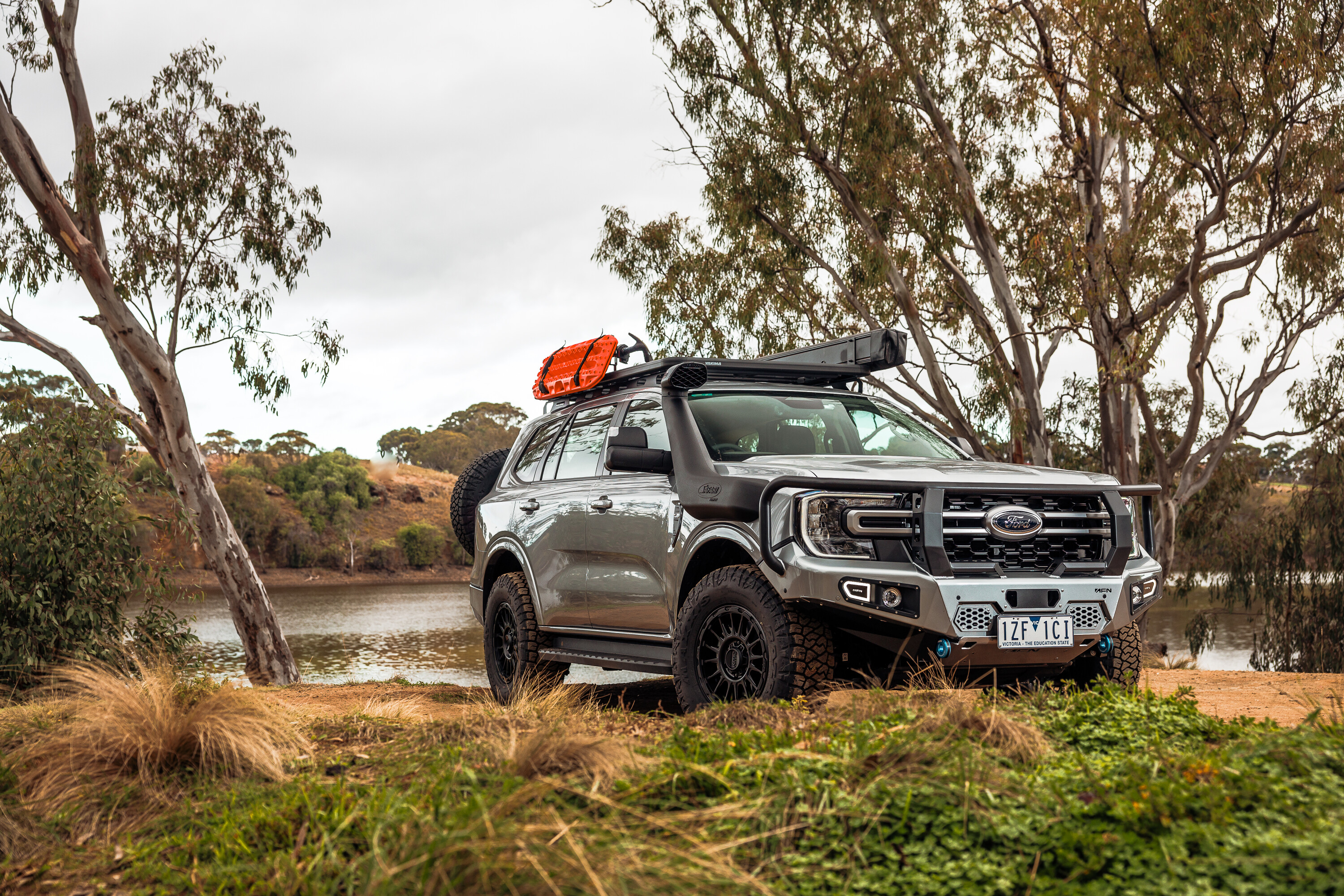
Installation
We chose to have the Armax snorkel fitted at Safari’s Melbourne headquarters, but it is a job that can be carried out by anyone who is handy on the tools and is confident enough to cut holes in the guard of their 4×4.
The supplied instruction book is comprehensive and detailed, listing all the tools needed to do the job, and it includes templates not just for where the snorkel is mounted on the vehicle but also for the modifications needed to be made to the airbox.
To achieve the extra airflow that the Armax snorkel is capable of (up to 25 per cent more) the intake of the factory Ford airbox needs to be opened up and this requires removing some strengthening ribs with a die grinder and cutting out the aperture. The supplied templates make this job easier but, like everything involved in this job, it’s best to measure twice and cut once!
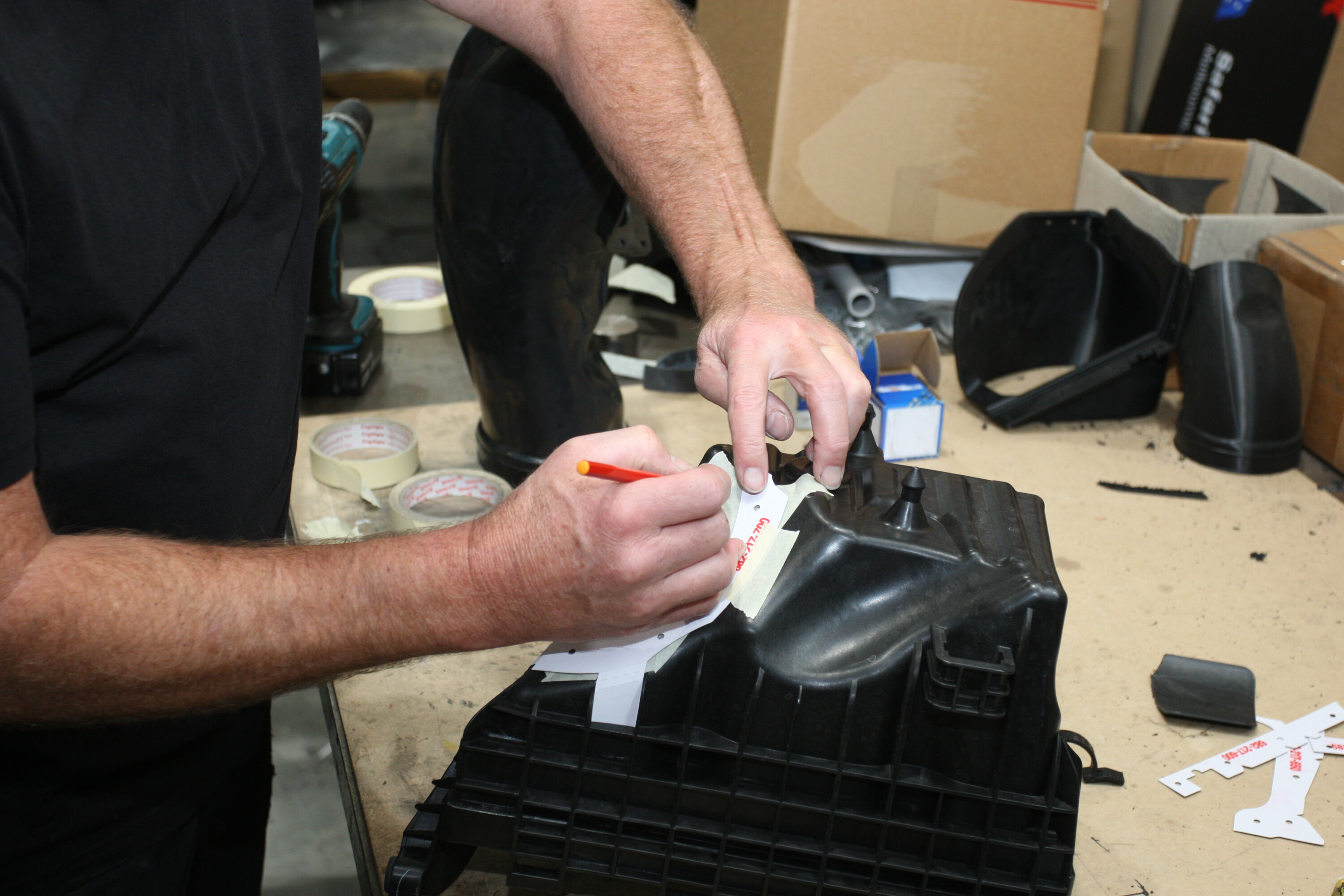
Stainless steel reinforcing brackets are included in the kit and these need to be affixed to the airbox to maintain its rigidity. A huge OE-style moulded rubber tube connects the modified airbox to the snorkel through the guard. The modified airbox still uses the factory air filter element.
Careful marking using the supplied templates will ensure you correctly drill and cut the holes in the guard and on the A-pillar to mount the snorkel in place. Again, check twice and cut once. In fact, I’d check three times to be sure.
Depending on the model, engine and spec of your Ford, you may need to relocate the horn or bend a bracket here and there to ensure it all fits within the inner guard. The snorkels are made to suit all model variants with either the V6 or bi-turbo diesel engines, while another variant of Armax snorkel is currently in development for the Ranger Raptor.
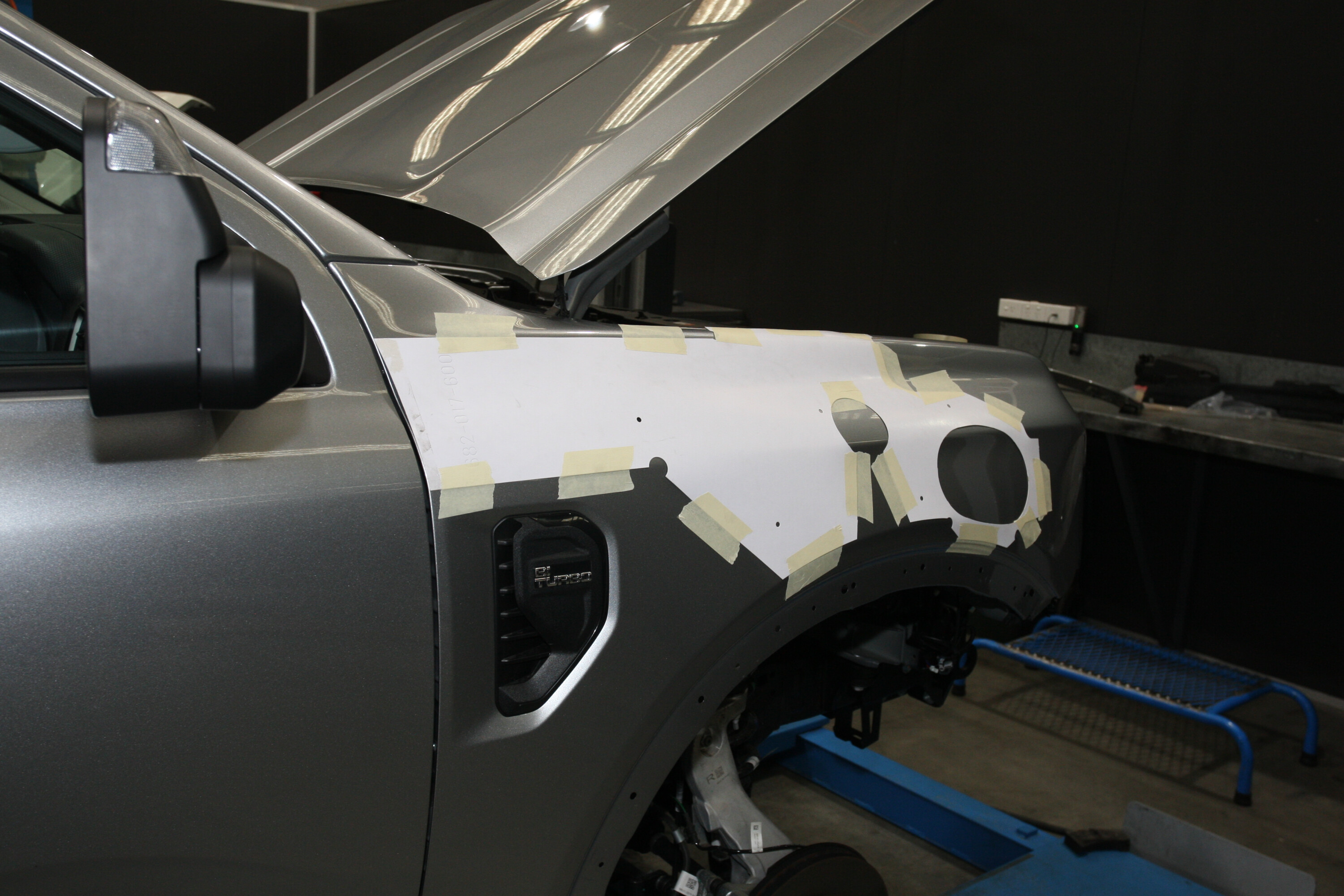
If your Ford Everest or Ranger has flares fitted there is a cut-out in the lower edge of the Armax snorkel to clear them without any cutting. If you don’t have flares, like our Everest, an infill plugs that cut out on the bottom of the snorkel. At the other end of the Armax, it’s capped with a four-inch Air Ram head with inbuilt water separator to drain any rain or other water away from the intake and keep it out of your engine. The Air Ram head is also designed to be quiet so you’re not bothered by any intake noise when out on the highways and tracks.
We have found that the snorkel does slightly amplify the resonances of the four-cylinder diesel engine but not to the point where it becomes annoying or loud. The Armax snorkel is big on the front of the Everest and flows well beyond what we have planned for the vehicle but it looks great and we know the capability is there for additional flow if required by any future modifications. But more than anything, we can drive with confidence into creeks and streams without being too concerned about water entering the engine via the Ford’s OE forward facing air intake.
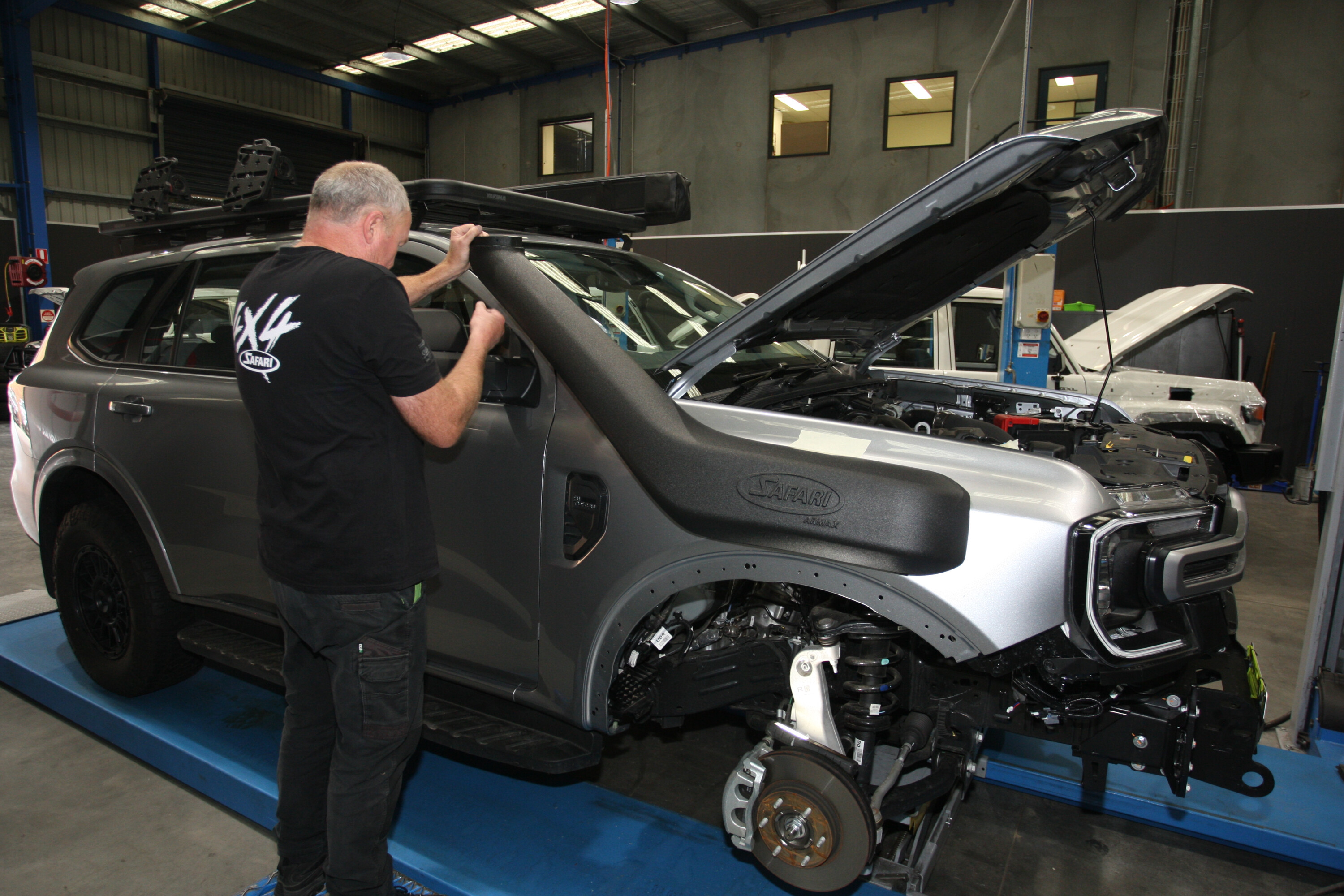
Despite Ford claiming a class-leading 800mm wading depth for the Ranger and Everest, we don’t think the forward facing intake is ideal and moving that intake through the guard and up high on the A-pillar gives us a lot more confidence for water crossings.
This is a great Australian-made product and, if it’s anything like the Safari snorkel on my Cruiser, it’s one that we reckon will outlive the Everest itself.
RRP: $880 (plus fitting)
Rinse and repeat! Yep, unsurprisingly the Ford Ranger yet again sits atop the 4×4 sales charts, with the Blue Oval securing top spot on the podium with a total of 5449 sales in May 2024.
However, the result wasn’t as dominant as prior months, with the ageing Toyota HiLux registering a mightily impressive 5055 sales (4×4 variants). The Everest was the third best-selling vehicle – and most popular 4×4 wagon – in May, ending the month with 2110 sales in the bank. As always, the trusty D-MAX wasn’t too far behind, with 2049 4×4 sales for the month.
Adding 4×2 variants to the mix only strengthens the Ranger’s supremacy, with the Ranger remaining the best-selling overall vehicle in Australia with 5912 sales. It was followed by the Toyota HiLux (5702), Toyota RAV4 (5517), Isuzu D-MAX (2612) and Toyota LandCruiser (2578).
The 300 Series ended the month with 1482 sales in the book, which is up from 1364 sales at the same time last year (+8.7%). Its closest competitor in the upper large SUV segment, the Nissan Patrol, is also experiencing a healthy sales period – 622 sales for the month (up from 501 in May 2023, or +24.2%).
The budget brawl continues between the LDV T60, GWM Ute and SsangYong Musso, with GWM’s Ute (685 sales) outselling both the T60 (510) and Musso (420). This is despite both the GWM Ute and LDV T60 registering a considerable decline in sales in May compared to May 2023 (-26.4% and -38.0% respectively). Alternatively, the Musso improved on last year’s monthly result, showing growth of 23.2 per cent. At the opposite end of the market, the Silverado outsold the Ram 1500 by 332 sales to 207.
A deeper dive into the overall market reveals that new vehicle sales in Australia have reached a total of 512,753, which is a significant increase (+55,920) compared to 456,833 sales at the same time last year.
The LCV market in particular has performed well, with sales up 13.9 per cent (year-to-date) compared to 2023: 114,157 (2024) compared to 100,192 (2023). A total of 25,317 LCVs were sold in May 2024, up from 23,824 vehicles sold in May 2023. Overall, the LCV segment makes up 22.8 per cent of the market so far in 2024, compared to SUV (53.6%) and Passenger (19.1%).
The PU/CC 4×4 segment is also strengthening, with 19,140 sales registered in May 2024, an increase of 11 per cent compared to May 2023 (17,244 sales. Year to date, a total of 86,892 PU/CC 4×4 sales have been registered, compared to 73,938 in 2023 (+17.5%).
In a sign of the times, both hybrid and plug-in hybrid vehicles have shown considerable growth so far in 2024, capturing 15.8 per cent of the overall market compared to 7.9 per cent in 2023. However, diesel remains king in the LCV segment, with a total of 103,887 sales registered so far in 2024 – up from 90,363 at the same time last year.
Comparatively, a total of 9927 petrol-powered vehicles have been sold so far this year, which is pretty much on par with the 9776 sales seen last year. Electric sales in the LCV segment are up from 53 to 163, and hybrid sales have increased from 0 to 180.
“The continued growth highlights consumer confidence and the industry’s ability to meet diverse needs of Australian motorists despite current economic challenges,” said Tony Weber, FCAI Chief Executive. “The Australian market is one of the most open and competitive in the world which supply consumers with a wide choice of vehicle across all segments and price categories.”
| Best-selling 4x4s in May 2024 | |
|---|---|
| 1: Ford Rangeru00a0 | 5449 |
| 2: Toyota Hiluxu00a0 | 5055 |
| 3. Ford Everestu00a0 | 2110 |
| 4: Isuzu D-MAXu00a0 | 2049 |
| 5: Isuzu MU-X | 1789 |
| 6: Toyota LC300u00a0 | 1482 |
| 7: Mitsubishi Tritonu00a0 | 1128 |
| 9: Toyota LC70u00a0 | 1096 |
| 8: Mazda BT-50 | 1085 |
| 10: Volkswagen Amarok | 911 |
| Best-selling 4x4s YTD | |
|---|---|
| 1: Ford Rangeru00a0 | 24,778 |
| 2: Toyota Hiluxu00a0 | 20,004 |
| 3: Isuzu D-MAXu00a0 | 10,219 |
| 4: Ford Everestu00a0 | 9009 |
| 5: Isuzu MU-Xu00a0 | 8519 |
| 6: Toyota LC300u00a0 | 6911 |
| 7: Mitsubishi Tritonu00a0 | 6130 |
| 8: Mazda BT-50 | 5049 |
| 9: Toyota LC70u00a0 | 5030 |
| 10: Nissan Navarau00a0 | 4020 |
ARB has partnered with NACHO Offroad Technology to revolutionise the off-road lighting market with innovative and durable products.
The new Quatro light features a sleek four-inch pod design and combines robust construction with superior lighting capabilities, making it ideal for harsh off-road environments. The Quatro range includes several models: Spot/Off-Road for everyday use; Flood/Off-Road for a wide beam, ideal for crawling; a Spot/Flood Combo; and SAE Fog/Spot Combos in both white and amber for fog replacement.
NACHO lights are versatile, allowing mounting in various locations like bull bars, roof racks, pillars, or custom mounts, giving users control over placement. The Quatro lights feature multiple functions in a single unit, with low-power and high-power outputs for different lighting needs. They also introduce the industry’s first forced induction light, designed to maximise airflow and cooling for enhanced performance. The polycarbonate housing is removable and replaceable, adding to the light’s durability.
The Trail Running Light (TRL) enhances visibility and safety by providing a low-power mode that creates a glow effect, making the vehicle visible without blinding oncoming traffic. This light can be independently triggered or integrated with factory running lights. It comes with amber and smoke covers for added protection and customisable light output colour.
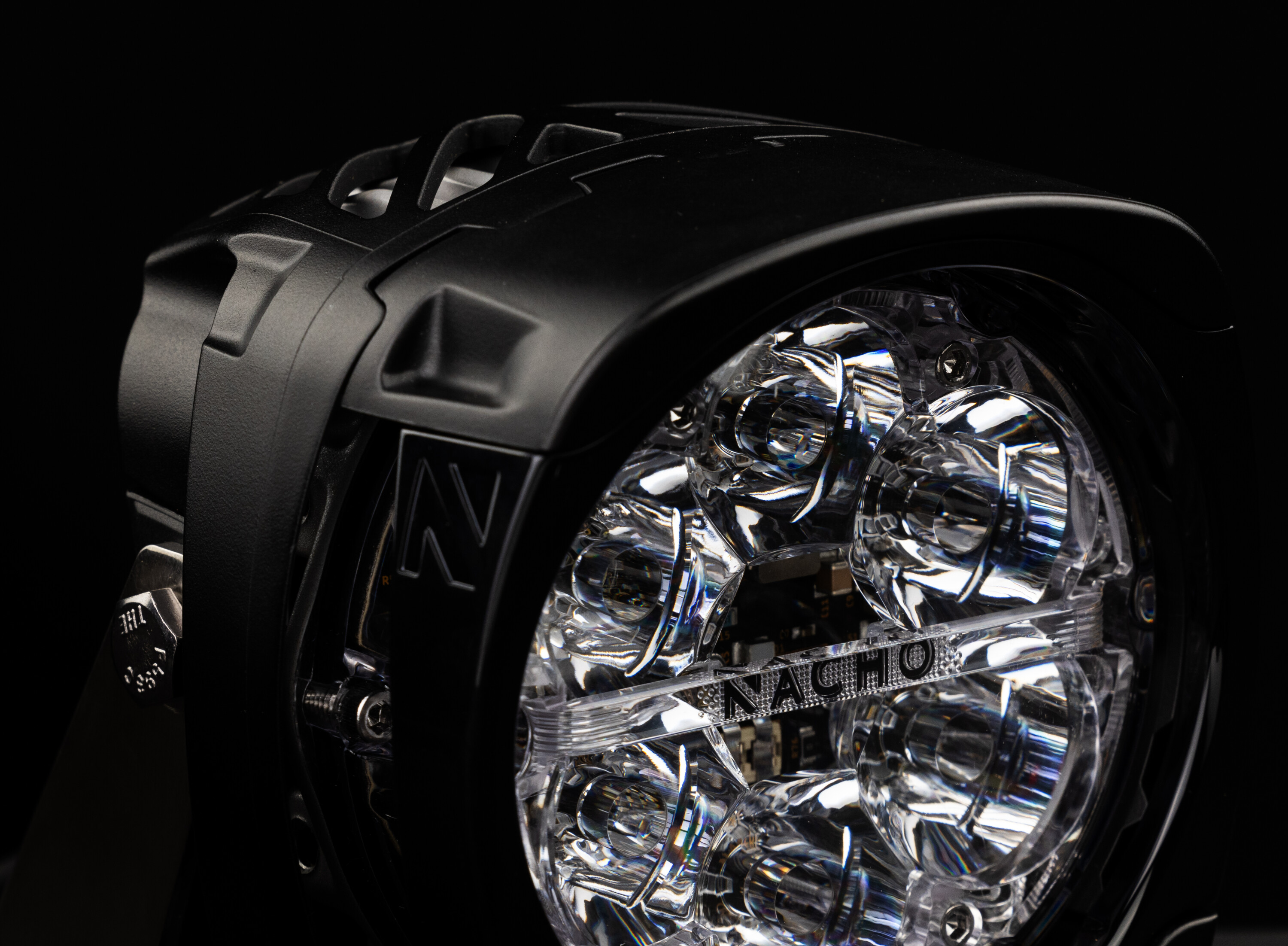
Engineered to withstand tough vibrations, the Quatro light boasts a J575 vibration rating and has been tested in demanding environments like Baja and KOH.
“ARB is thrilled to announce our partnership with NACHO Offroad Technology, the NACHO team are genuine pioneers of the off-road lighting industry,” said Cameron Smith, Product Manager at ARB. “Both of our teams share a deep commitment to quality, design, and innovation. Together, we aim to shake up the off-road lighting market.
“With ARB’s international distribution network, which spans over 100 countries and includes eight international offices, we are excited to take NACHO’s groundbreaking products to all corners of the globe.”
A new, premium infotainment upgrade accessory package is now available to suit the current-generation Mazda BT-50, but it’s not cheap and it’s not available for all models in the BT-50 line-up.
Model grades the infotainment package can be adapted to include the XTR cab chassis and pick-up; XTR LE pick-up; GT pick-up; SP pick-up; and Thunder pick-up. It’s unavailable for all lower-spec XS and XT variants, but it can be retro-fitted to suitable model grades.
The package is a dealer-fitted Mazda genuine accessory, which means it comes with a five-year warranty when fitted as part of a new vehicle purchase.
“Already the complete package, the Mazda BT-50 now offers owners an even more enjoyable in-car experience,” said Alastair Doak, Marketing Director of Mazda Australia. “This new premium infotainment upgrade package is ideal for drivers who enjoy high-quality car audio, and it’s an ideal companion for longer trips on the open road.”
The package replaces the standard nine-inch display with a new, larger 11-inch WXGA high-definition laminated touchscreen head unit developed by Alpine Electronics. The head unit is embedded with wireless Apple CarPlay and Android Auto; TIDAL high-res audio streaming app; HEMA off-road navigation; and it offers dual USB-C, HDMI and AUX interfaces. Plus, an in-built Class D audio amplifier channels sound to a crossover unit that is specifically tuned for the BT-50’s cabin.
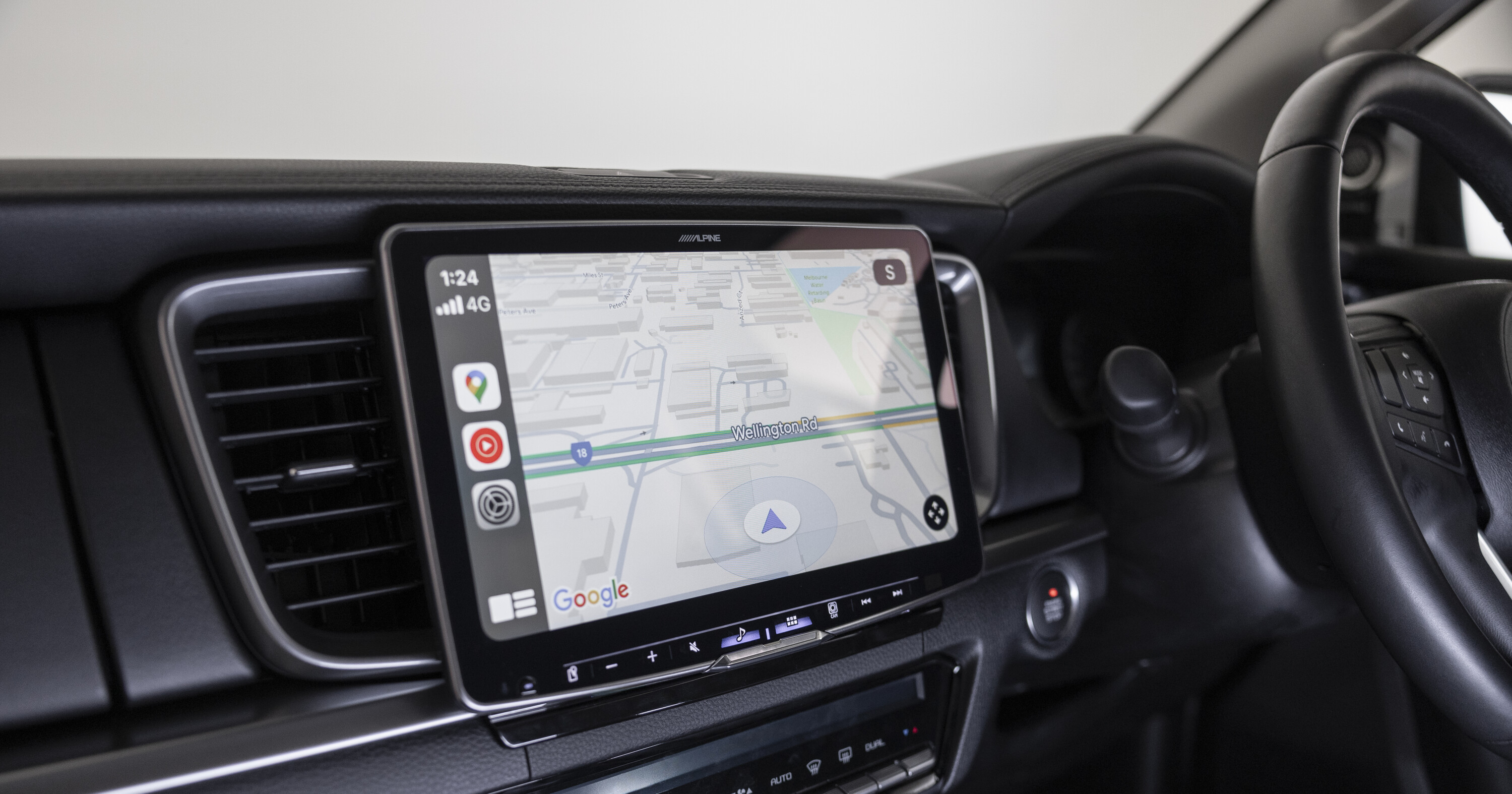
To maximise sound quality, the BT-50’s stock front speakers have been flicked and replaced with high-performance 6×9-inch drivers – featuring a lightweight composite cone construction – which offer a 300-watt peak power rating. In addition, two extra Hi-Fi Audio-certified tweeters have been installed.
As mentioned, the upgrade isn’t cheap, with the 11-inch premium infotainment upgrade touchscreen head unit listed with a recommended fitment price (RFP) of $3447. The premium infotainment upgrade speaker package has a RFP of $1495.
The upgrade is available now from all authorised Mazda dealers across Australia.
The sun was shining, and the temperature was climbing, perfect conditions to explore Murray-Sunset National Park and surrounding areas.
With mind-blowing nature and unique history, spectacular silo art and enticing breweries, sandy tracks and epic camping, spending a few days here is something not to be missed.
My adventure began across the South Australia border just outside of Renmark. The stunning Heading Cliff lookout is a must see. The colours of the cliff face change according to the time of day and the weather conditions, with sunset a popular time to experience this special place, whiling away some time watching houseboats meander along the Murray River as it flows below you.
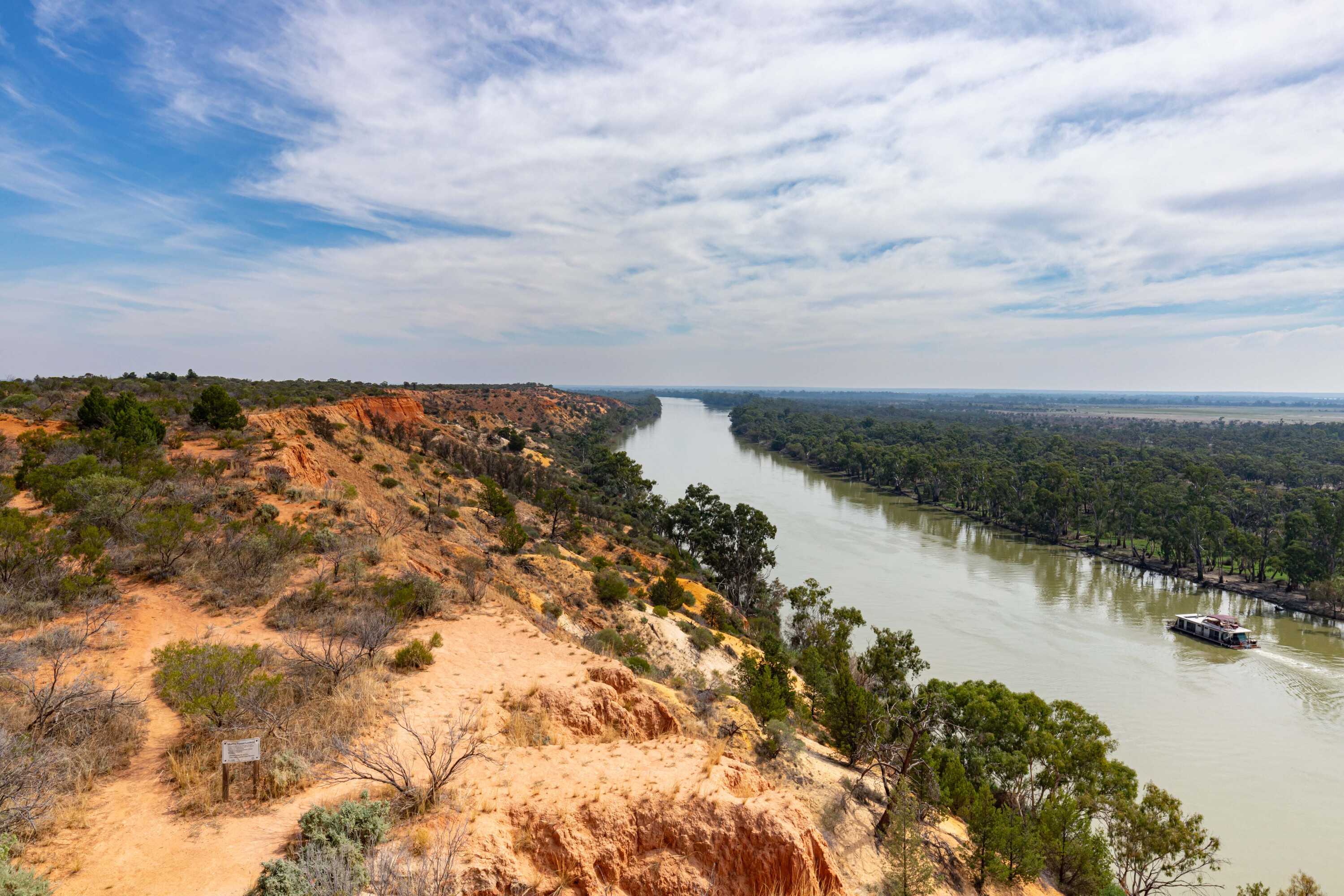
The nearby Woolshed Brewery also offers great views of the river and of course a range of locally brewed beers. There are free barbecue facilities here and on weekends there are food trucks serving delicious fare. The brewery is open from Wednesday to Sunday from 11am to 5pm.
My final stop before hitting the Border Track was at the old Customs House at the end of Murtho Road. Constructed in the 1900s, it served as an excise collection point on the Murray River for goods and services travelling to South Australia on paddle steamers.
These days it is a general store with river access and a boat ramp nearby. The Border Cliffs Customs House Wetland Walk also begins and ends here; it’s a 4km loop that meanders through the wetland supported by numerous creeks that flow through the reserve.
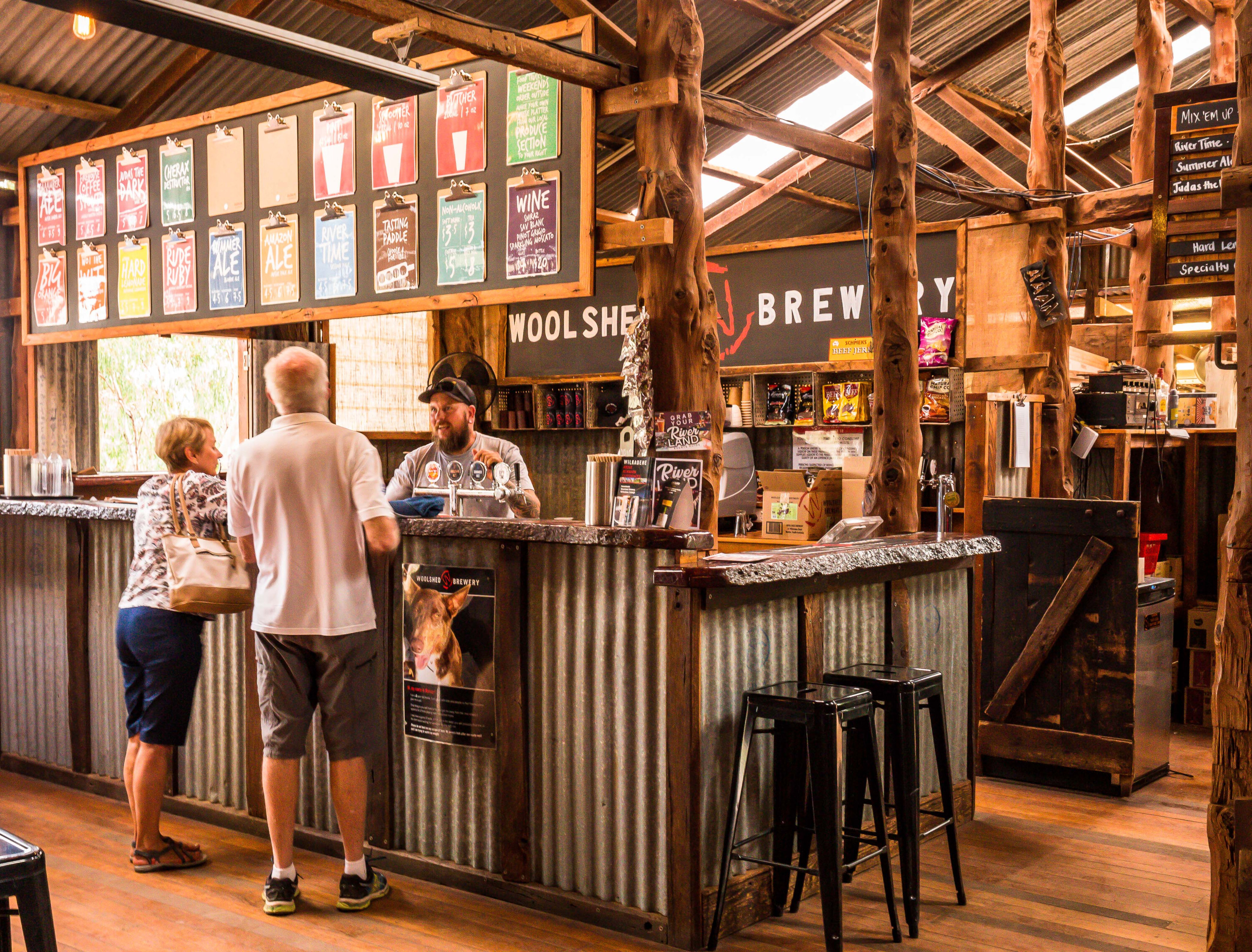
Backtracking along Murtho Road, I took a left onto Millewa Road, travelling 2.8km before crossing over the cattle grid into Victoria.
Turning south onto the northernmost point of the Border Track I soon reached White’s Cairn survey marker, a replica of the original one that was erected in 1850 during the first Victoria/South Australia border survey by Edward White and Henry Wade. There is also a storyboard that commemorates the history and significance of the site.
I followed the Border Track for a while before turning onto Tanks Track. I’ve driven the Border Track from start to finish several times and wanted to explore a section of the northern reaches of Murray-Sunset that I hadn’t driven before.
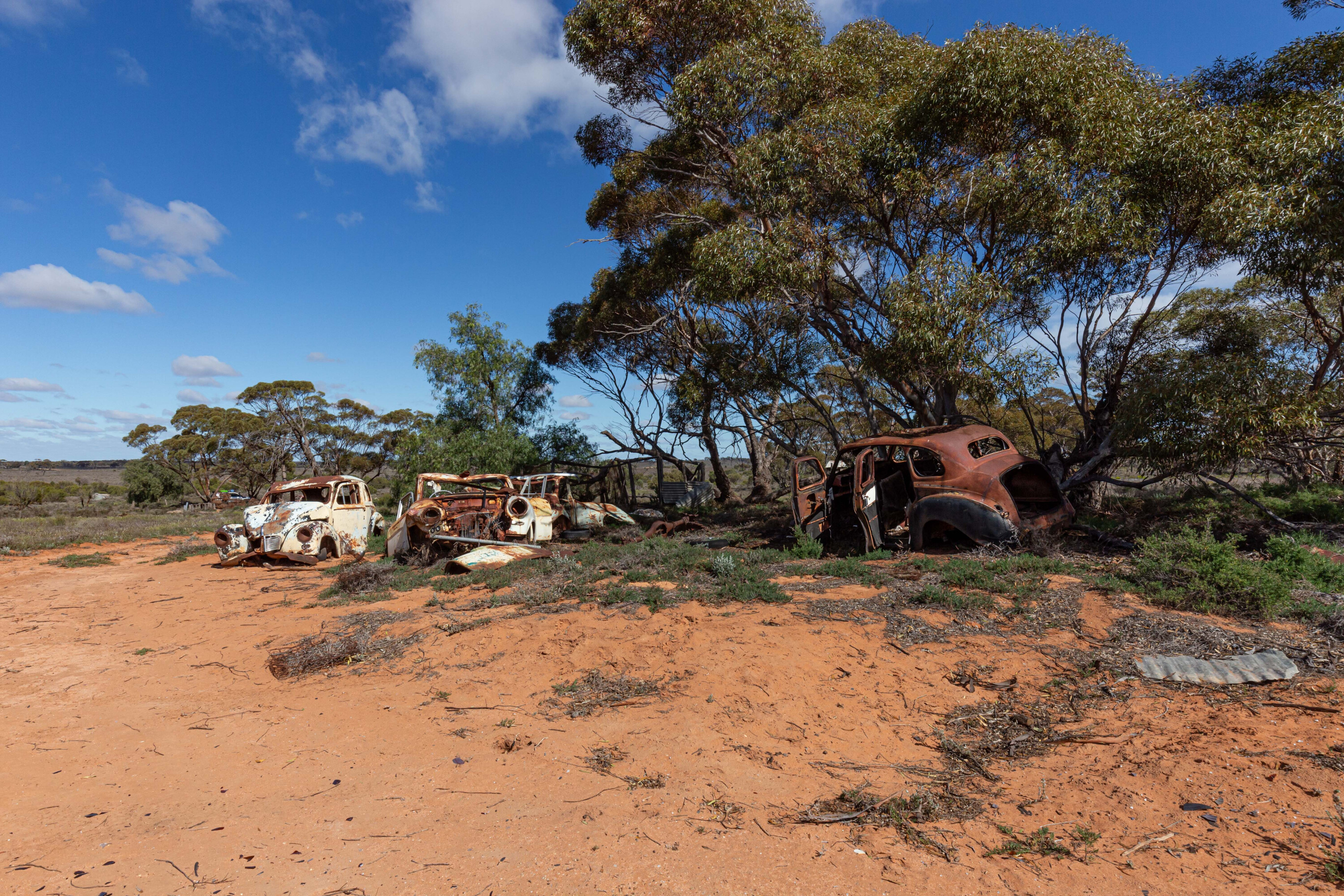
The sandy track led 10km east to the junction with Berribee Tank Track, another sandy track with more dunes as it headed 13km south to the Sturt Highway. I spotted an echidna crossing the track and it tried to bury itself into the dune while I tried to snap a shot.
It was getting late in the day, so upon reaching the Sturt Highway, I took a right turn then a quick left onto Taparoo Track that passes the old Taparoo Homestead site, a place worth exploring with a handful of old vehicles still lying around. I continued along the track, eventually crossing the open Copi Plains before reaching Settlement Road. Keep an eye out for kangaroos and emus who enjoy the bountiful expanse.
Upon reaching the Shearers Quarters Campground, I was happy to be the only person there, and I enjoyed the peace with only the birds and the wind whistling through the Native Cypress pines for company, enjoying the golden sunset and the starry night sky.
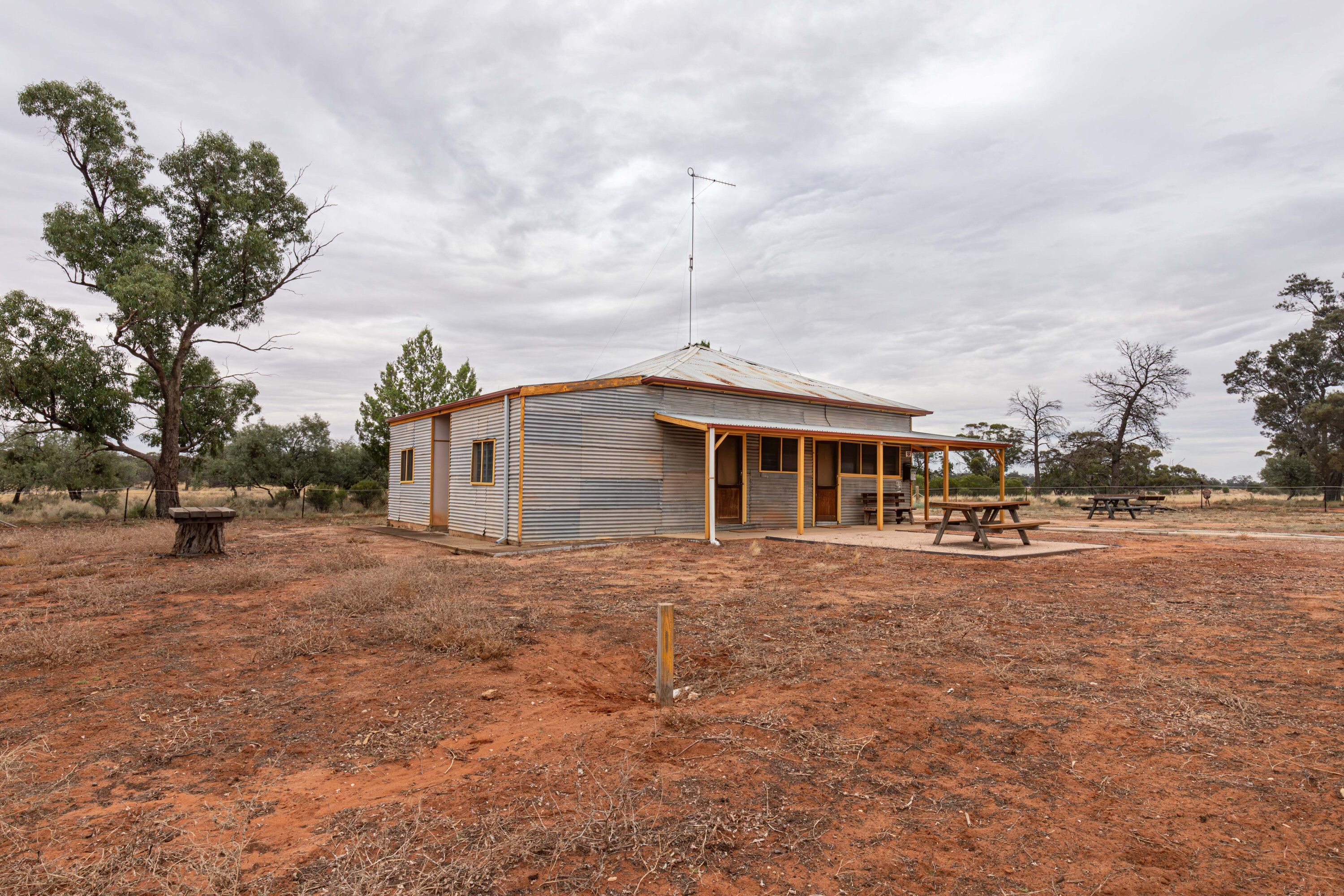
The campground has firepits, tables and a pit toilet, while the historic Shearers Quarters cottage can be pre-booked and sleeps up to 10 people, and features a gas fridge, oven and stovetop, flushing toilets and hot showers.
Sometimes, there is non-potable water available, but you must supply your own drinking water. It’s BYO firewood too.
The clouds had rolled in overnight, and the temperature had dropped, and after a quick breakfast I hit the tracks again, following Settlement Road 8km to the Border Track and turning south. It is slow going along this section of the track, with tight twists and turns, dunes and lots of whoopsie-dos. It took nearly two hours to travel 16km to Pheeneys Track.
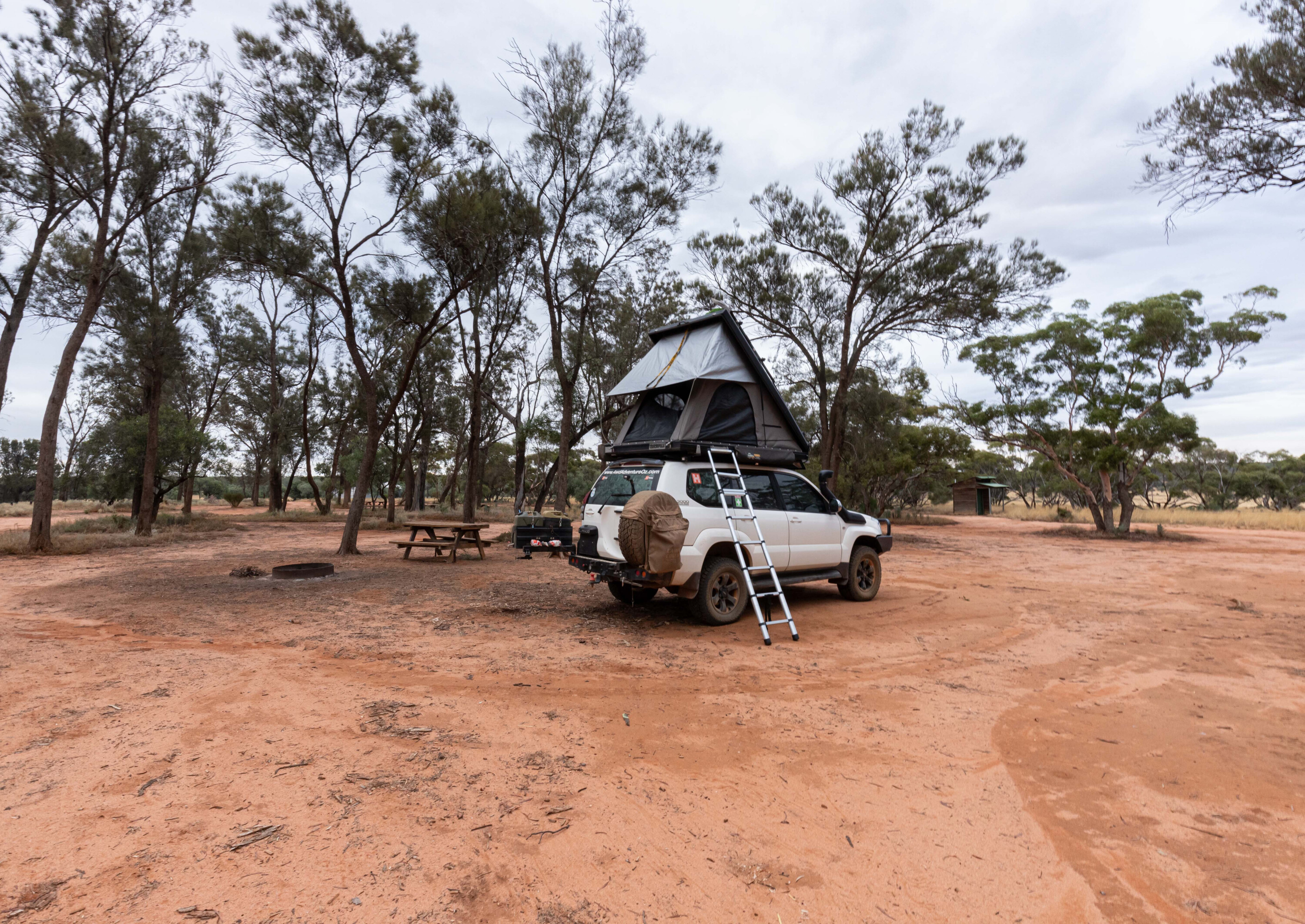
The Border Camping Area is located nearby, where I enjoyed an early lunch, and I still hadn’t come across anyone else so far.
Continuing along Pheeneys Track for 9km, I decided to follow the Mallee South Bore Track for 18km to check out the natural rock hole; you’ll encounter a bit of soft, deep sand on this track. Covered with wire mesh to prevent animals and humans from falling in, there was plenty of water in the hole.
Retracing my steps back to Pheeneys Track, I headed east for 40km to Bambill South Track. With Pheeneys Track following the swale between dunes, it is easy going. Heading north for 19km it wasn’t long before Settlement Road was reached.
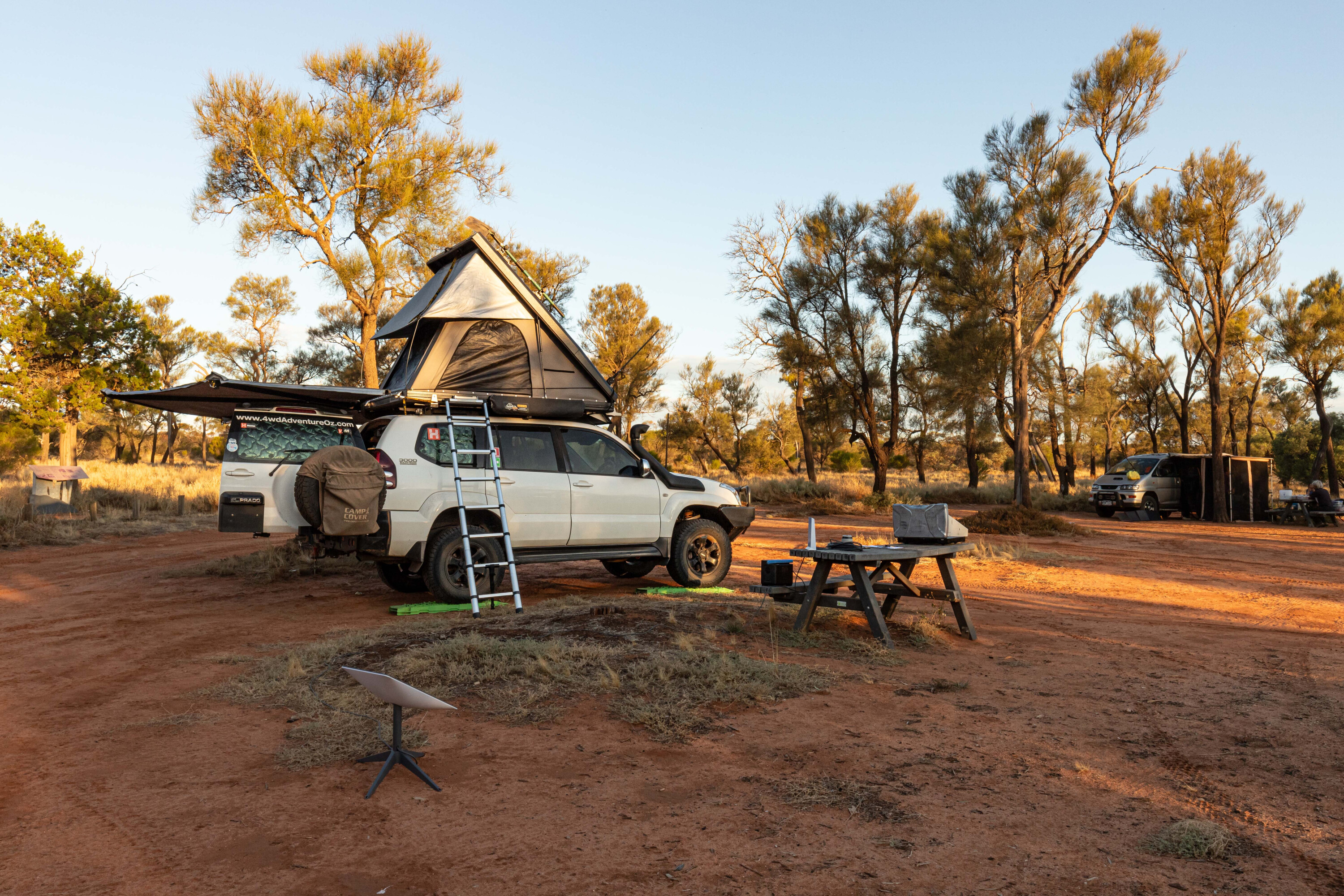
Turning east, my destination was Rocket Lake 41km away, and as the afternoon sun burnt the clouds off, it was a beautiful drive.
Settlement Road, for the most part, borders the national park and wheat belt properties, making it a thoroughfare for kangaroos and emus, so keep an eye out as they aren’t afraid to jump in front of you… or even into you. An emu took out the rear passenger door on a mate’s new 100 Series a few years back and bounced off, leaving an expensive dent.
Pulling into the campground at Rocket Lake, there were a couple of other groups set up in caravans. I selected a reasonably flat spot next to a table and quickly erected my rooftop tent and awning before relaxing with an ice-cold beer from the fridge.
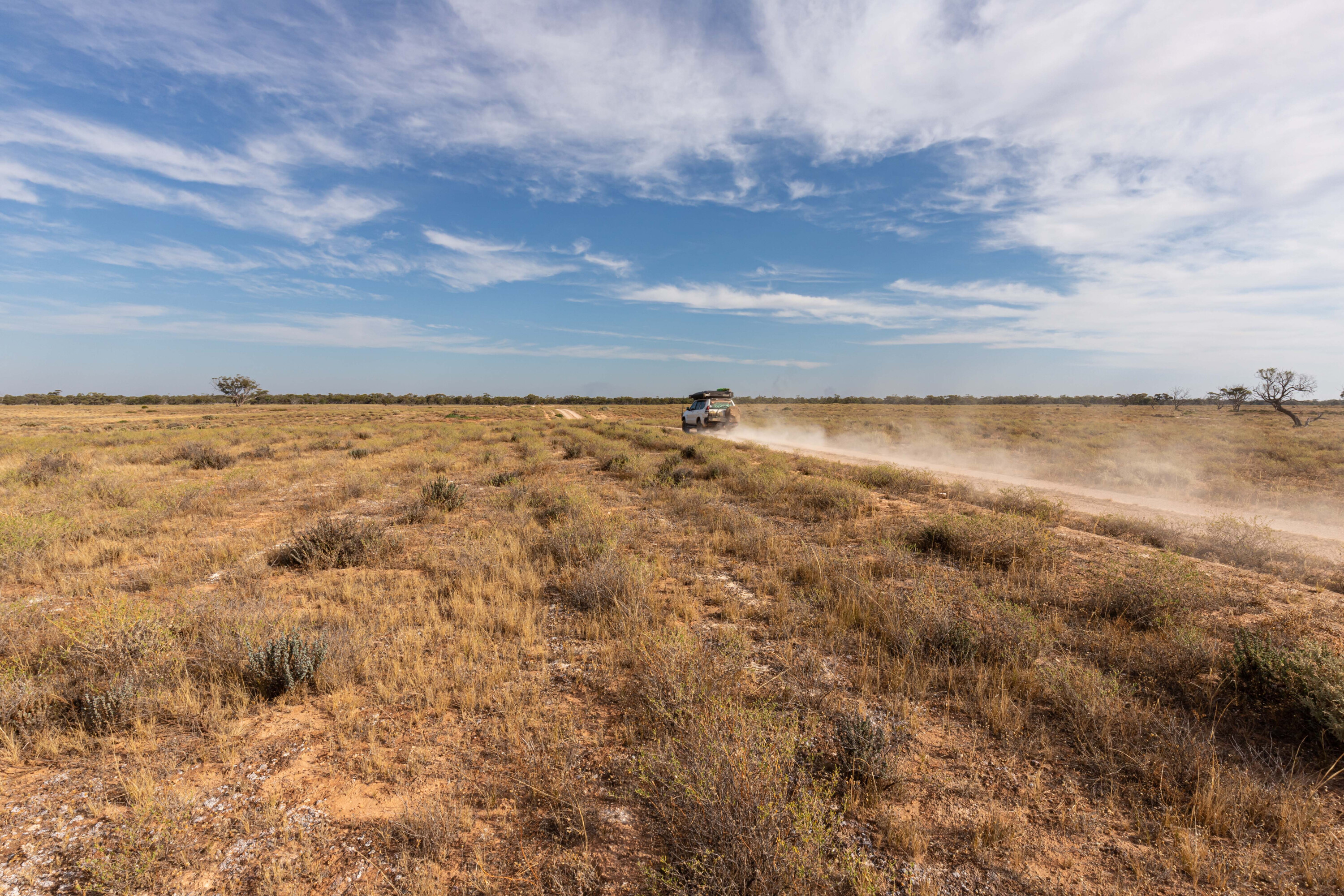
On this trip, I was giving Starlink a run for the first time and, so far, I have been very impressed with the speed of connection and the speed of the internet once it locks onto a satellite.
As the sun set I enjoyed a home-cooked beef casserole, washed down with a glass of red wine. The night sky was full of stars and thankfully my neighbours went to bed early and I enjoyed the serenity.
Rocket Lake was named by workers on the rail line as the bosses sent up a rocket to let them know when it was time for smoko. These days it is a wide-open expanse and hasn’t seen water in many years. Waking to clear blue skies there was no indication of what was to come weatherwise.
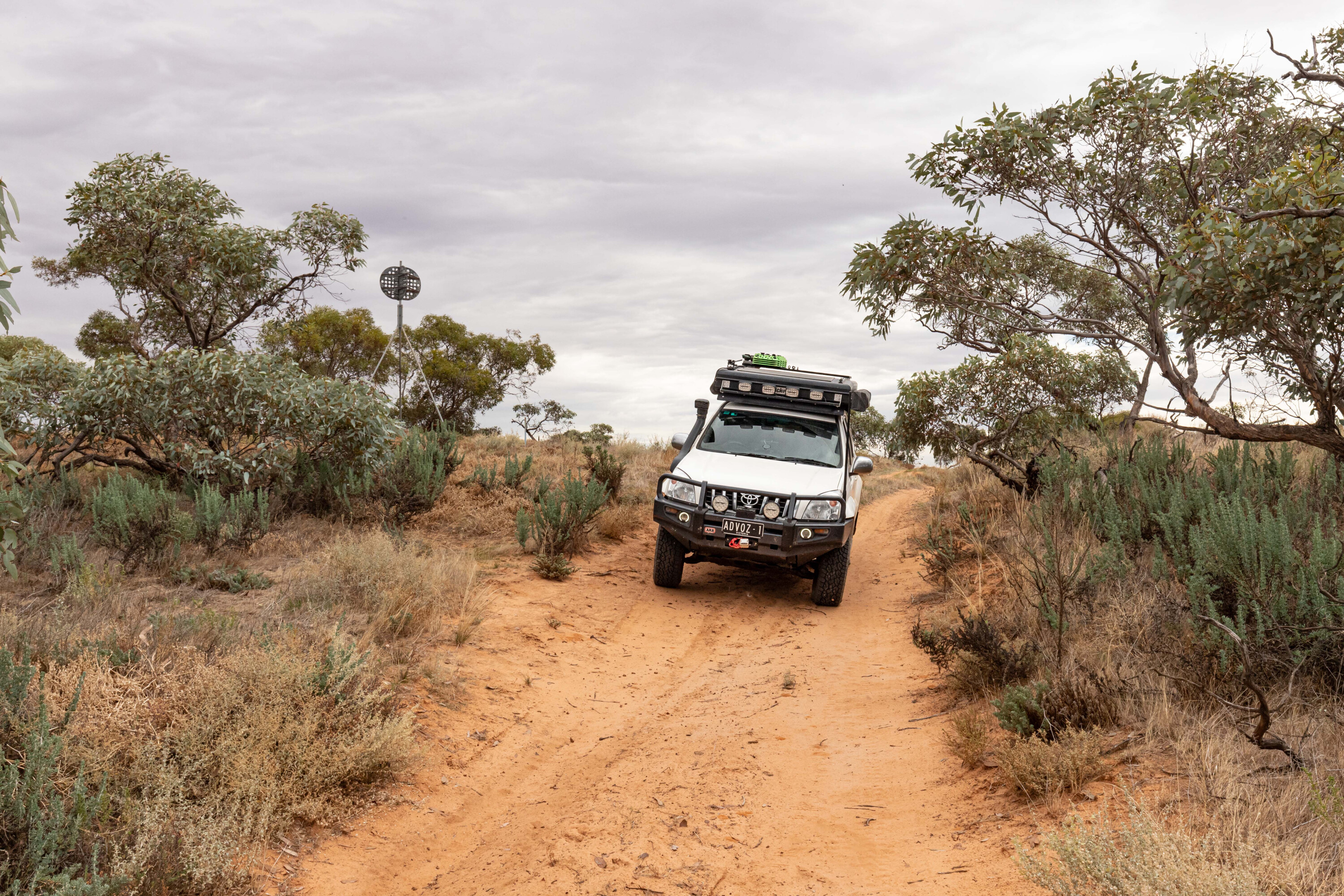
I decided to explore the park a bit more before heading out to Ouyen to fuel up. Nowingi Line Track is where the railway track used to run, and you can still find iron spikes along its length.
The track is straight, flat and easy going once the right speed is reached to negate the corrugations. Henscke Track heads north, across black soil plains covered in saltbush, and for the first time this trip I came across some fellow four-wheel drivers.
Midnight Tank Track eventually links up with Settlement Road, but I decided to continue following it until I reached Underbool Track. Heading south along Underbool I jumped back onto the Nowingi Line to drive 8km to get back to Rocket Lake Track.
Rocket Lake Track crosses many dunes and can be challenging when it is hot and dry, and it was a nice change from the mostly flat tracks I’d driven so far.
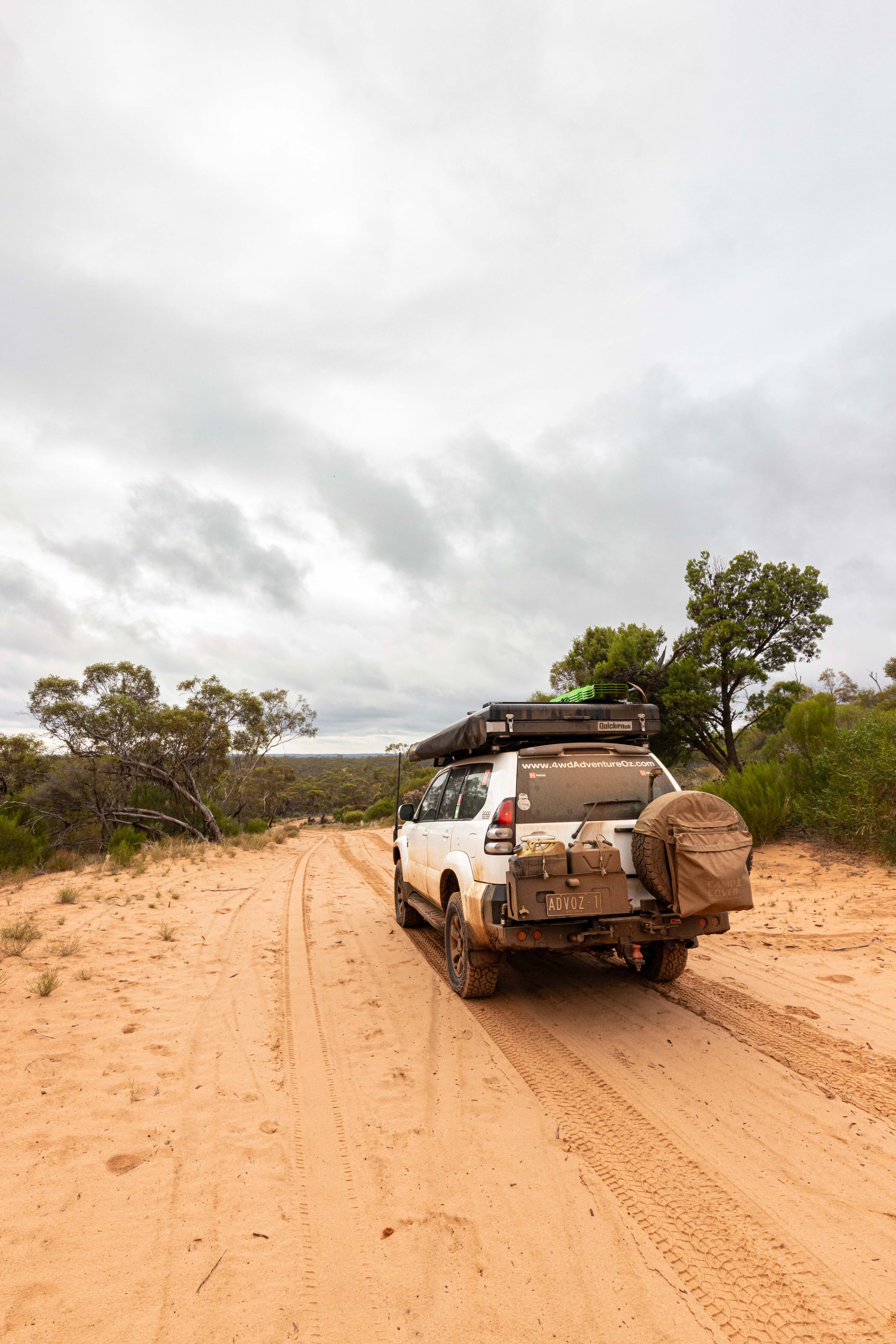
Turning onto Last Hope Track led me to One Tree Plain Track, which is one I wouldn’t want to tackle when wet as it skirts one salt lake and then crosses another along its route.
Once out of Murray-Sunset, the drive to Ouyen is via the Mallee back roads with fields of wheat and canola wafting in the wind. I was surprised to see the new 500-megalitre recreational lake on the outskirts of Ouyen.
What was once the abandoned Ouyen Reservoir is now open for water sports, and boasts manicured lawns, a wharf, jetty, toilet block and barbecue facilities. There are even whispers that camping may be allowed in the future.
Once fuelled up, I started heading back the way I’d come, though this time I jumped onto Honeymoon Hut Track, and that is when the skies opened up and dropped a bucketload of rain across the park.
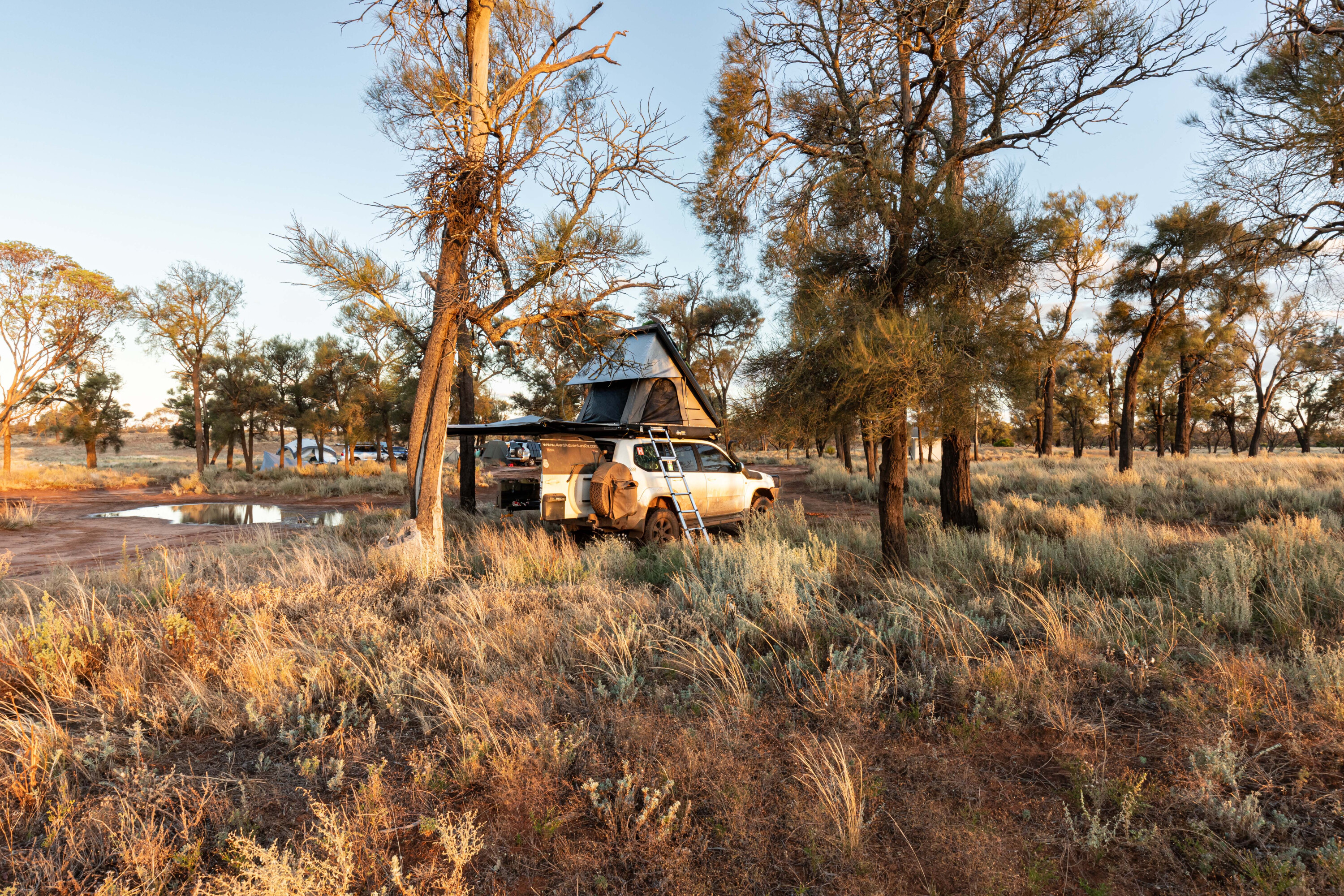
Having just swapped my muddies to all-terrains, traction was reduced on the clay-based track, and I had to slow down to stay on it. With Mopoke Hut my planned stop for the night, I wasn’t sure I would get there.
The 21km drive to Mopoke Track was challenging but I was following fresh tyre tracks, so I knew that so far the track wasn’t impassable. Mopoke Track is one of my favourites, with deep sand and a couple of sizeable dunes to cross, and the rain had tamed it dramatically. I had forgotten about the black soil lakebed that had to be crossed and when I reached it, the pit in my stomach grew.
Momentum was my friend along this section, and even though the back end of the Prado wanted to lead the way, I was able to stay on track and keep moving forward until I reached the sandy section of track. Beads of sweat covered my brow and it felt like I’d held my breath for the entirety of the crossing.
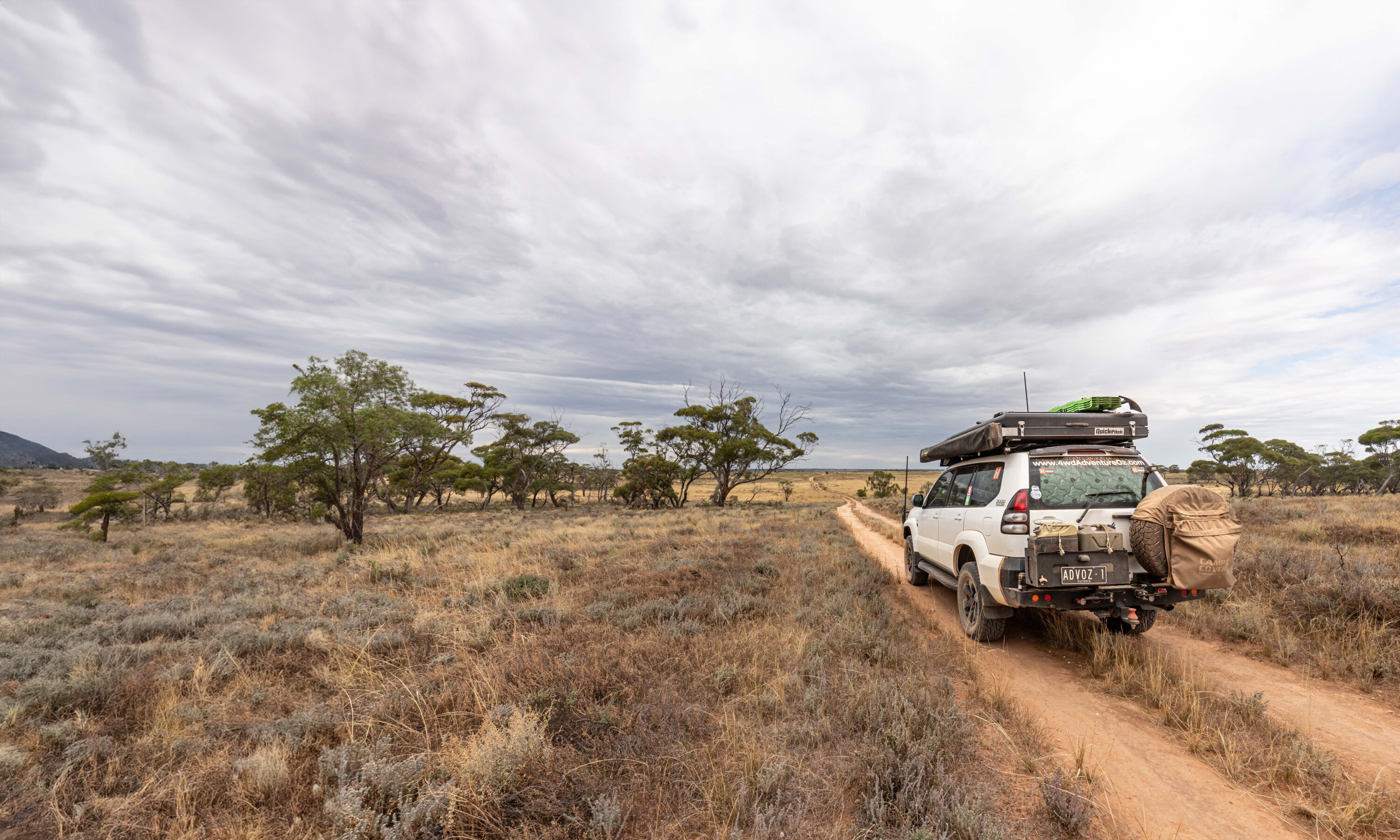
The rain stopped and the sun returned on a sodden Murray-Sunset and the campground at Mopoke Hut was busy. I found a spot beneath some trees and cracked a can before setting up for the night.
Mopoke Hut was constructed in 1962 by Bill Henschke as somewhere to rest after driving a mob of his cattle on horseback from his ‘Yaramba’ property, or after mustering and yarding.
Bill relinquished his grazing licence to the government in February 1990 stipulating that the hut should remain as a place for travellers to stay. Unfortunately, the hut was badly vandalised in 1991, but was thankfully rebuilt by the Mildura 4×4 Club.
The sky was blue with a mix of grey clouds hovering around when I awoke, and I knew it could be a challenge to get to the Lake Crosbie campground at Pink Lakes.
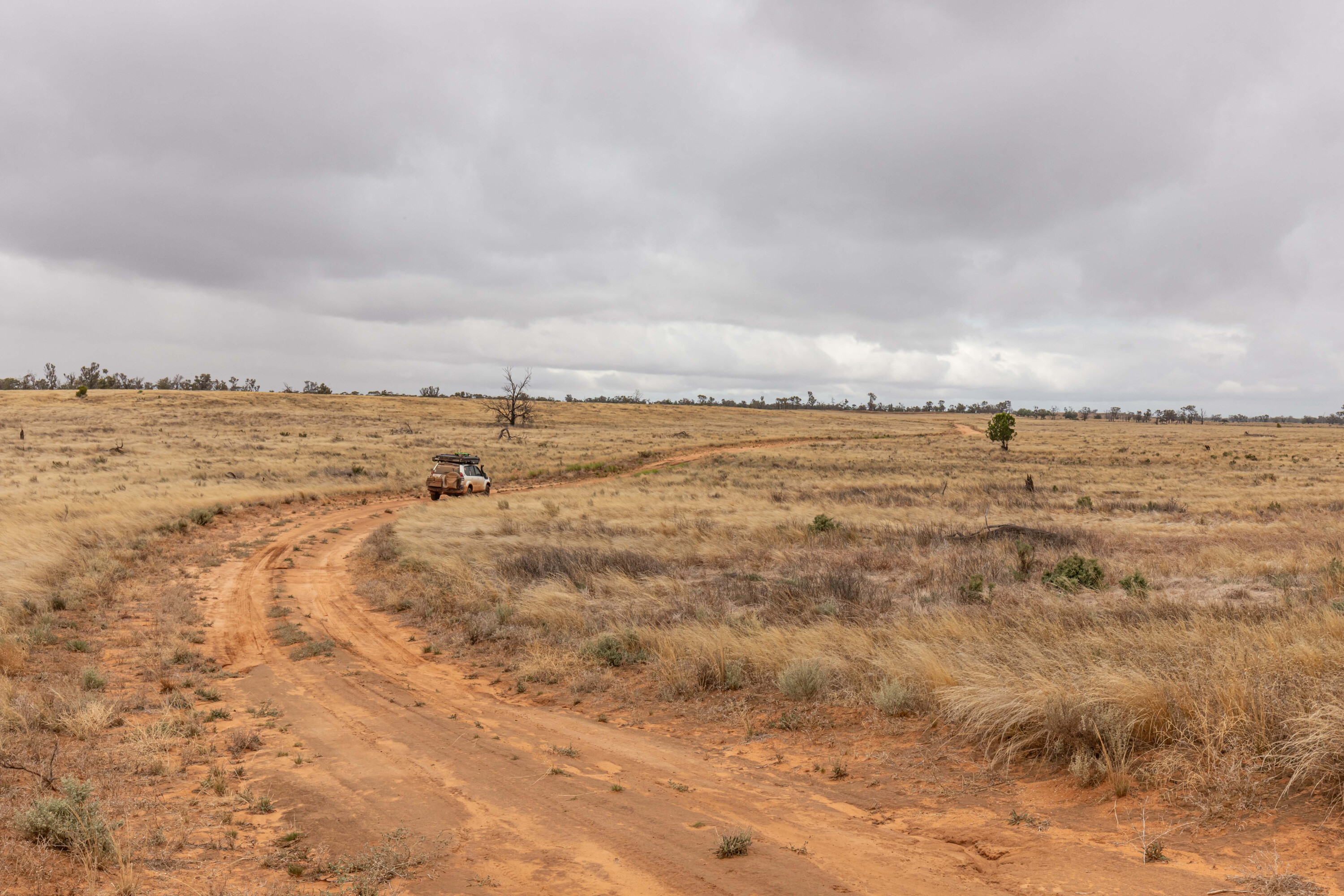
Making my way west along Last Hope Track, I was stopped in my tracks with water covering an old lakebed ahead of me. Thankfully I managed to perform a three-point turn without becoming bogged and I retraced my tracks back to Mopoke Track.
It was carnage at the junction of Mopoke, Rocket Lake and Pheeneys tracks, with water, deep wheel ruts and splattered mud everywhere. It was obvious that most of the campers at Mopoke Hut had come through the junction, albeit with plenty of difficulty. Skirting the worst sections, I was able to get onto Pheeneys Track and follow it for 14km to Underbool Track.
The drive down to Mount Crozier Track was good going, with little evidence of the previous day’s downpour, although it started to drizzle on the approach to Mount Crozier, the tallest spot in Murray-Sunset.
There is a campground here as well as a short walk before a steep climb to the top of the mountain. The views across the park are spectacular usually, but today all I could see was where the rain was falling.
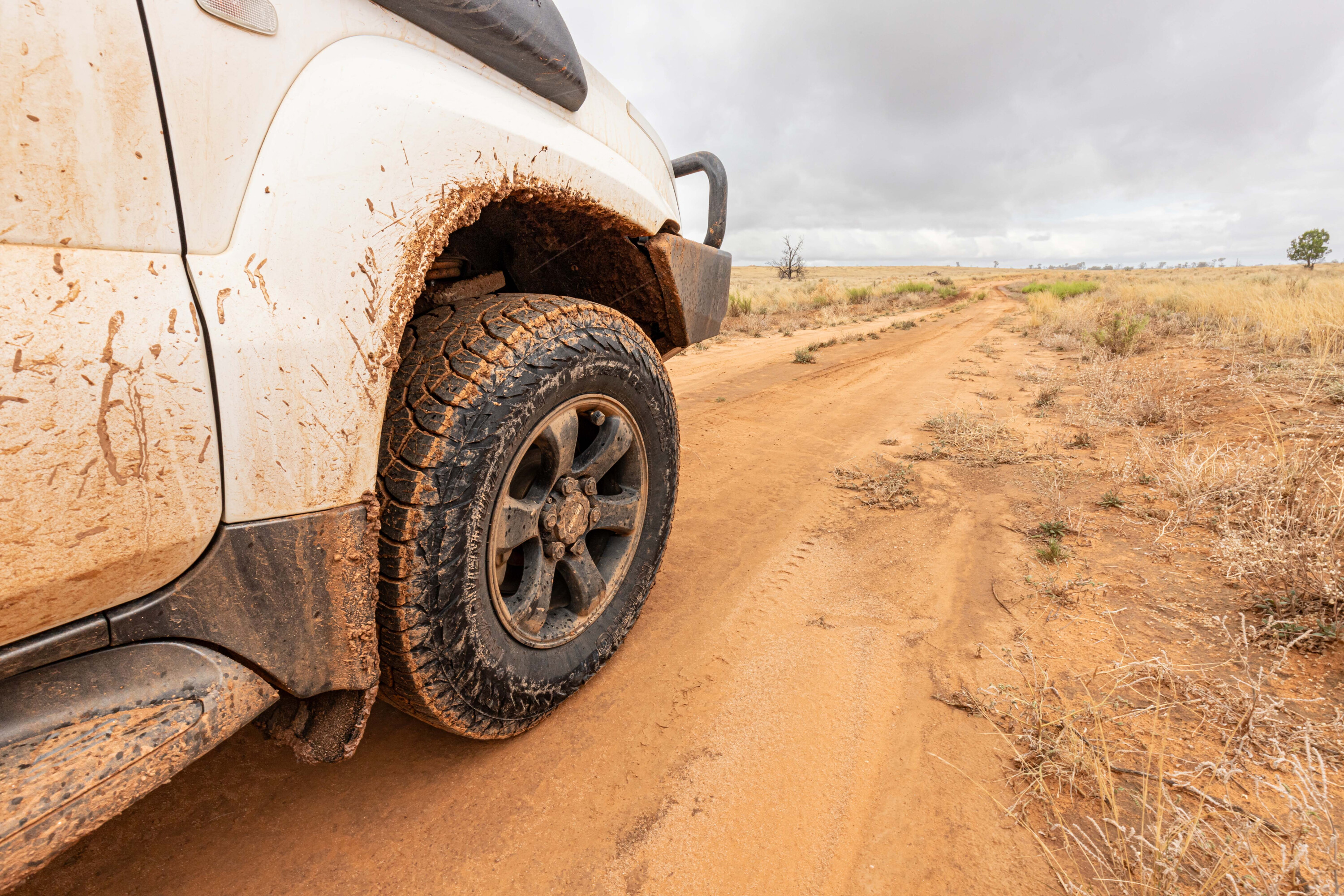
Once back in the dry cabin of the Prado, I followed Mount Crozier Track south, reaching Pioneer Drive without difficulty.
The sun was trying to poke through the clouds as I jumped onto Salt Bush Flat Track, which leads to then circumnavigates a small salt lake. After Checking out the Lake Becking Campground, I followed Pioneer Drive, a two-wheel drive road, around Lake Crosbie before reaching the busy Lake Crosbie Campground.
I needed to use recovery boards to level the Prado as the only site that wasn’t being used sloped badly. The rest of the day was spent relaxing, and I was thankful that I’d made it this far. Even though it was busy, the campsite was very quiet and once the sun disappeared, and I enjoyed an early night.
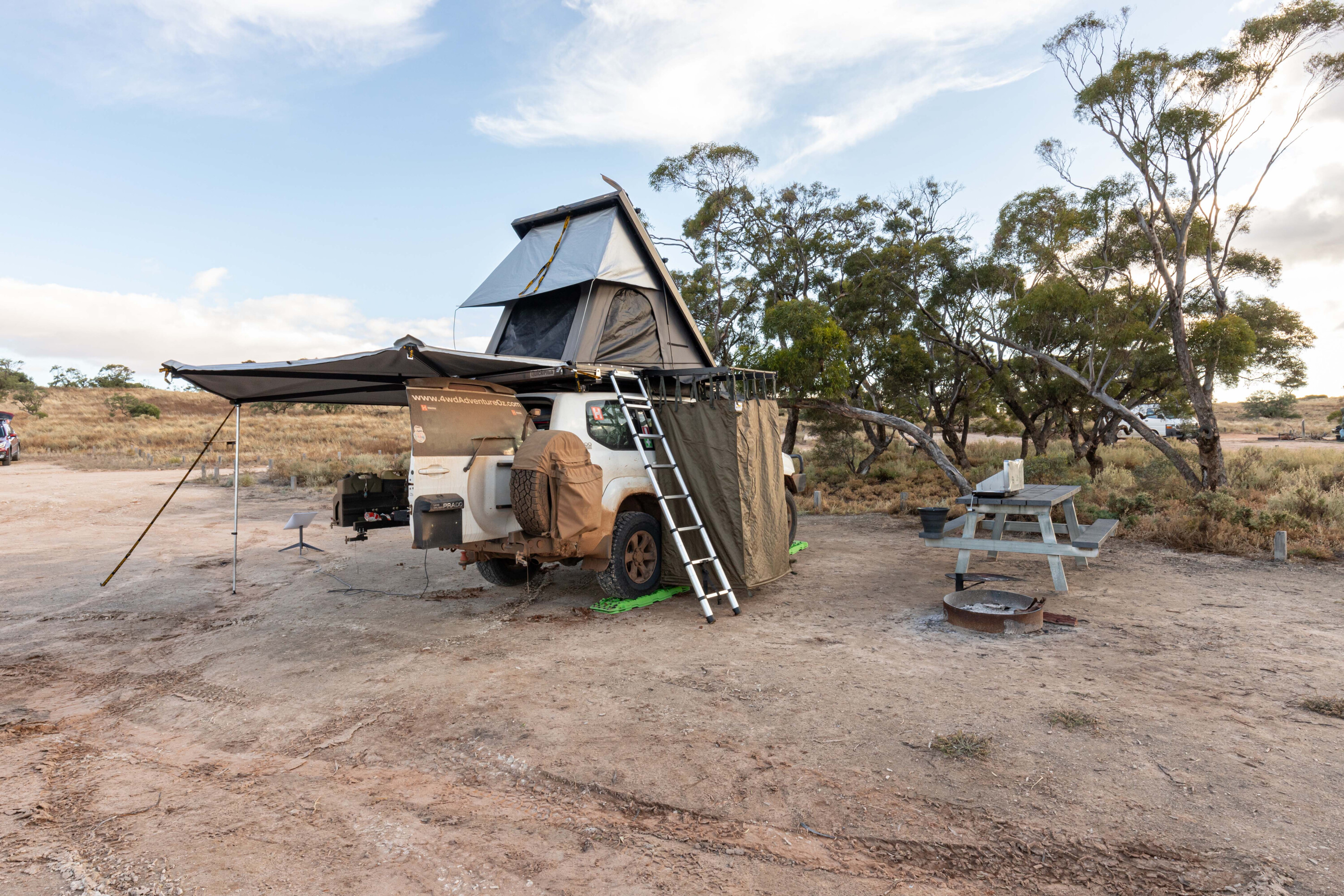
The next morning was similar to the previous day, with more grey clouds than blue sky on offer. I made a quick stop at the outdoor Pioneer Museum that tells the story of the salt mines that used to operate here.
The algae that release carotene in the lakes were in action, so the Pink Lakes were very pink.
Deciding that I wanted to scope out Kow Plains Homestead, I jumped onto Grub Track for 28km before tackling Sunset Track which led 23km to the western edge of the national park. Sunset Track was good for the most part; the deep sand sections had been tamed by the rain, but there were a couple of spots where water was covering the track with no diversions. Nevertheless, the Prado made it through in low range with just the right amount of momentum.
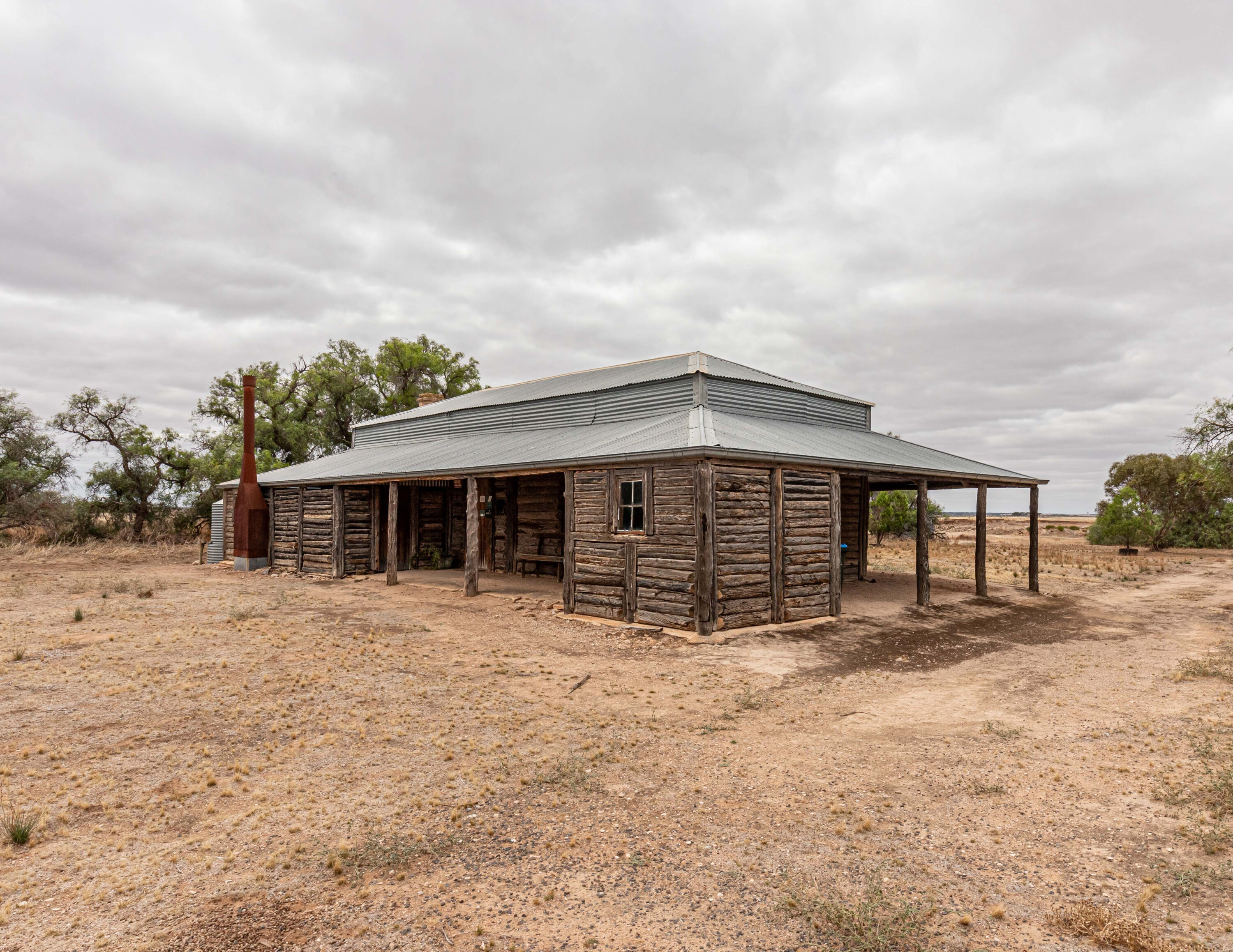
Once out of the park, I aired up before hitting the blacktop just west of Murrayville. I enjoyed a hot shower and change of clothes for a $5 donation at the caravan park before heading to Kow Plains just out of Cowangie.
Built in the 1870s using local pine logs the homestead and outbuildings here represent one of the last substantial links with the pastoral days of the past. A gold coin donation allowed me to follow the walking trail, reading the interpretive boards that described what life was like in the early days, and the tough times.
It was time to head home, so after following the Mallee Highway to Underbool, I took a quick detour down to Patchewollock to check out the silo art before making my way home to Wodonga. Murray-Sunset NP is a favourite haunt of mine and as it often does, it threw up a few surprises on this trip, all of which added to the adventure.
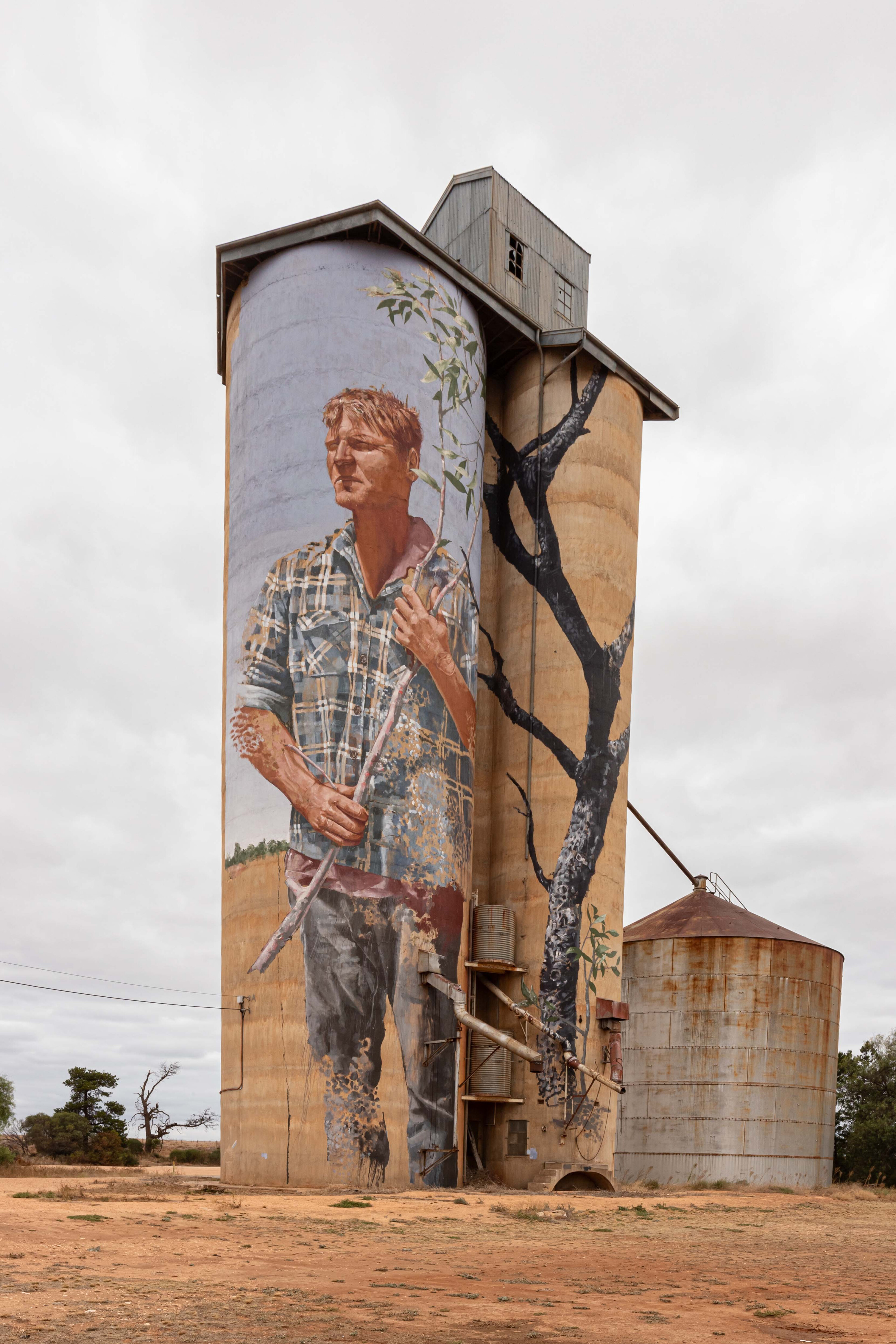
TRAVEL PLANNER
Region
North-western Victoria
Nearest town
Mildura and Renmark are the largest towns nearby and have all the facilities you need.
When to go
The cooler months from April to September are the best times, but access may close after rain. The warmer months bring native bees that are attracted to water.
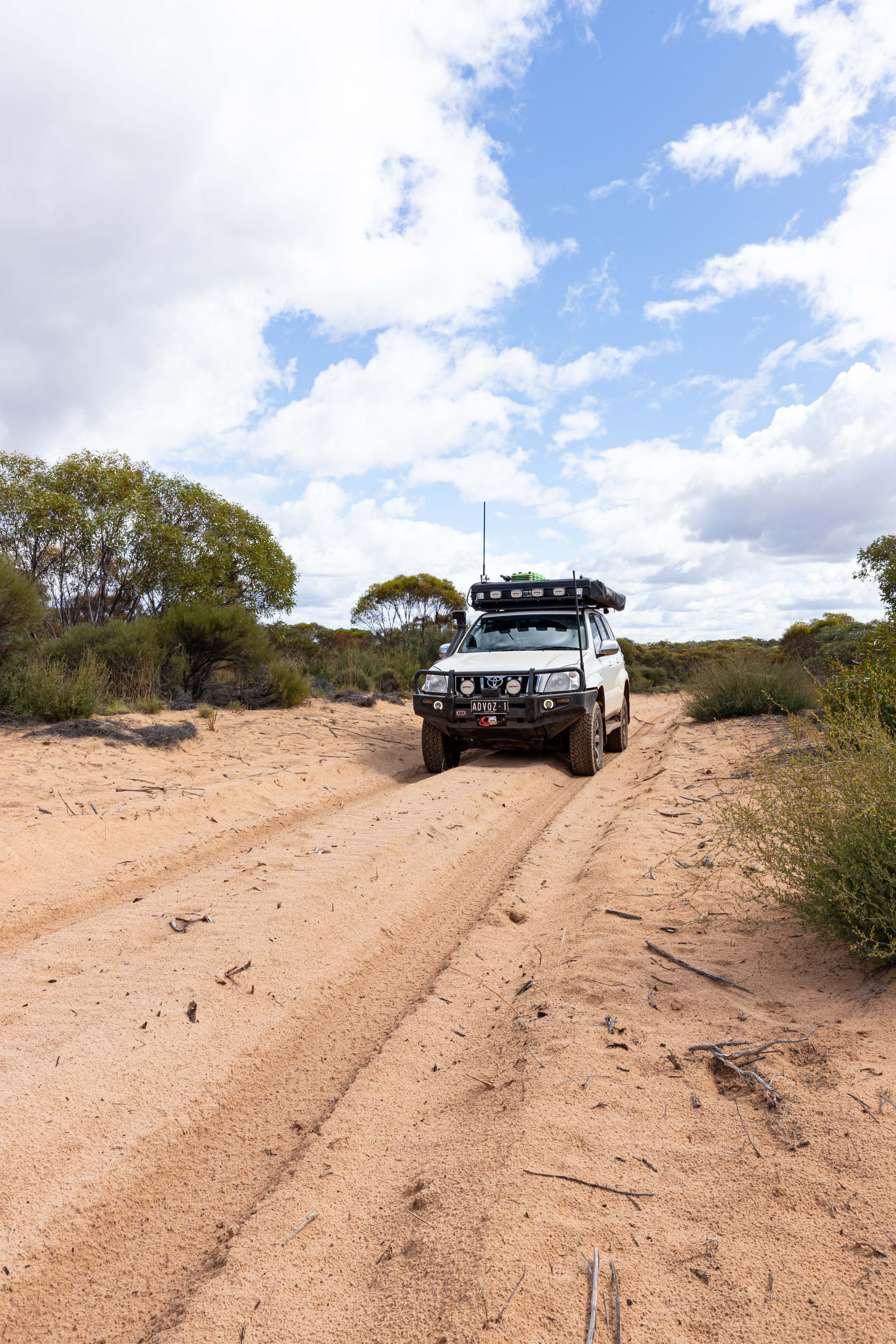
Accommodation
Camping is available at Lake Crosbie, Mt Crozier, Mopoke Hut, Rocket Lake, Pheeneys Track and the Shearers Quarters, each with pit toilets, tables and firepits. Rainwater may be available depending on conditions. Border Track Campground has no facilities.
What to take
A compressor and tyre gauge, tyre repair kit, firewood, food and water. Leave it better than you found it.
Difficulty
Once you move away from the Pink Lakes, most tracks will offer you a good challenge with deep sand. When it is warmer, the tracks are even more challenging.
Contact
5 reasons to visit Murray-Sunset NP
- Pink Lakes
- Sunsets
- Plenty of tracks to explore
- Excellent campsites
- Sense of isolation
